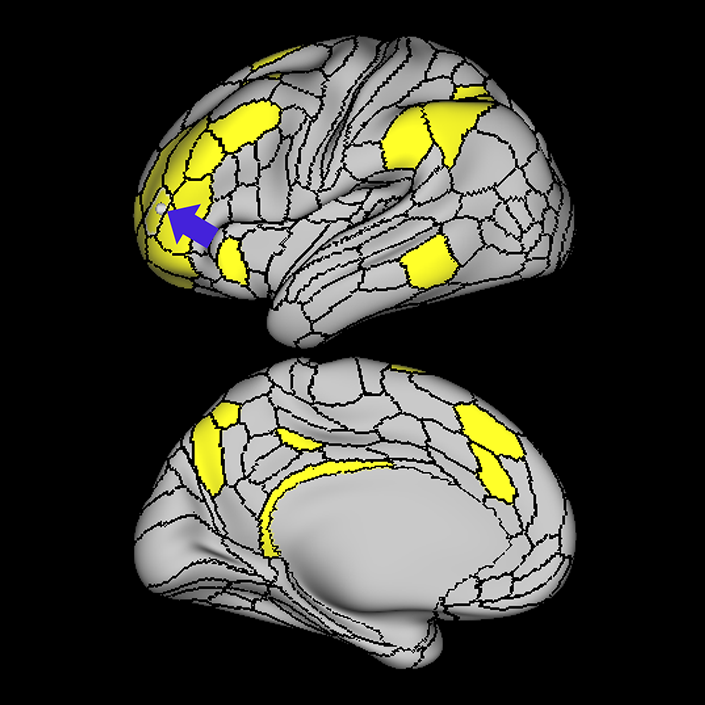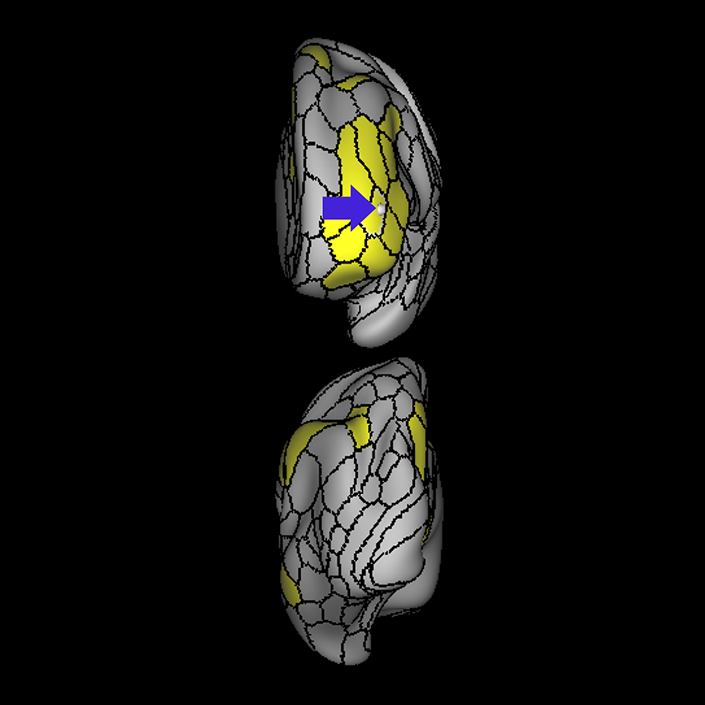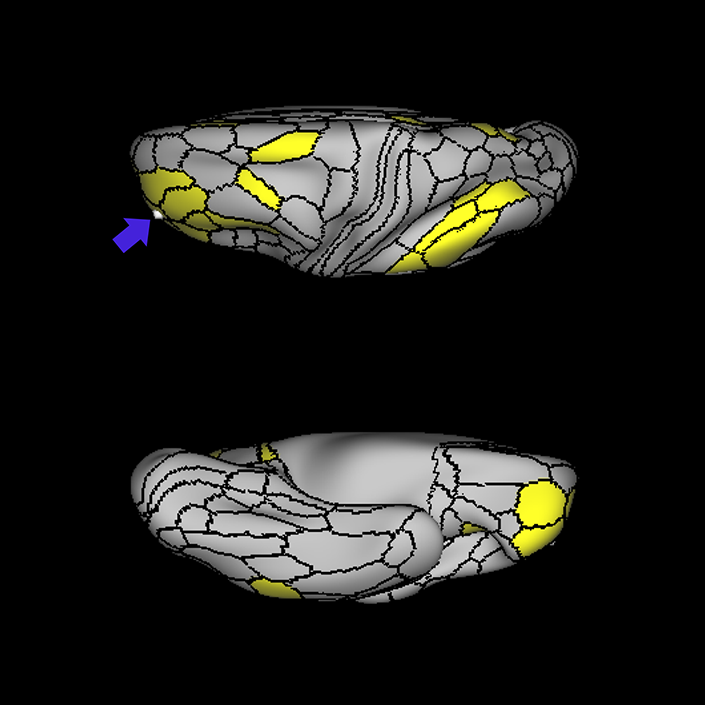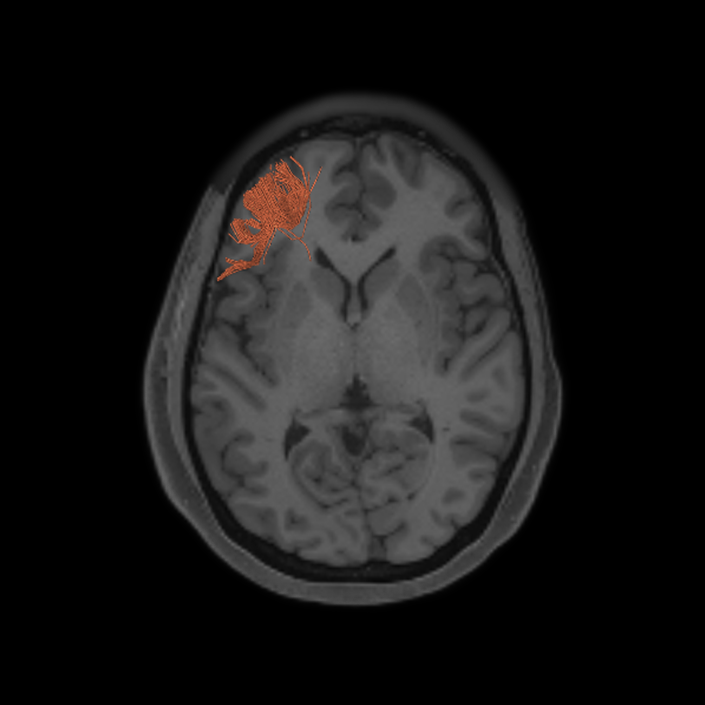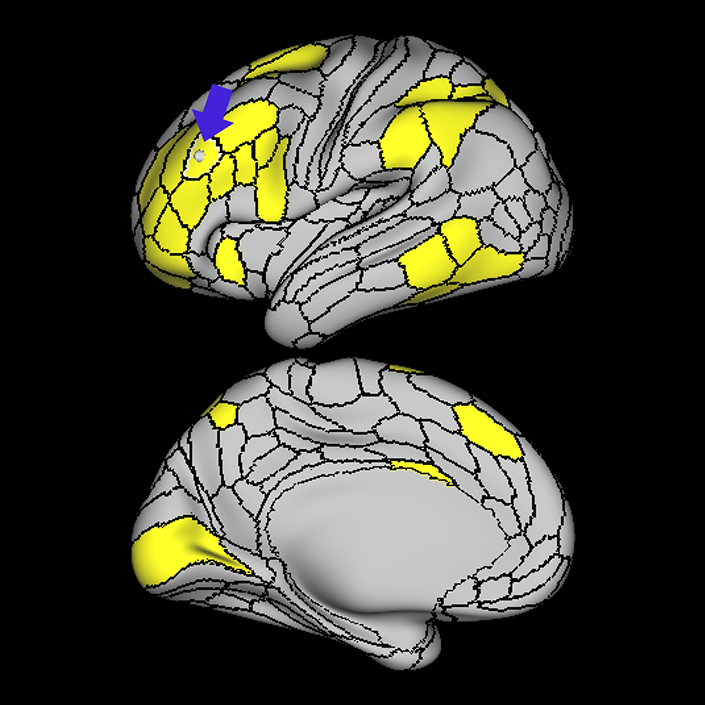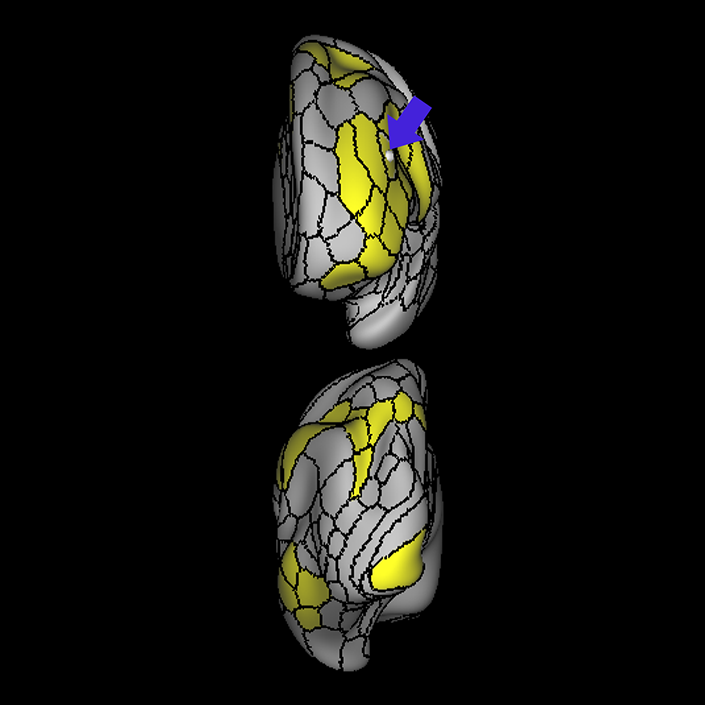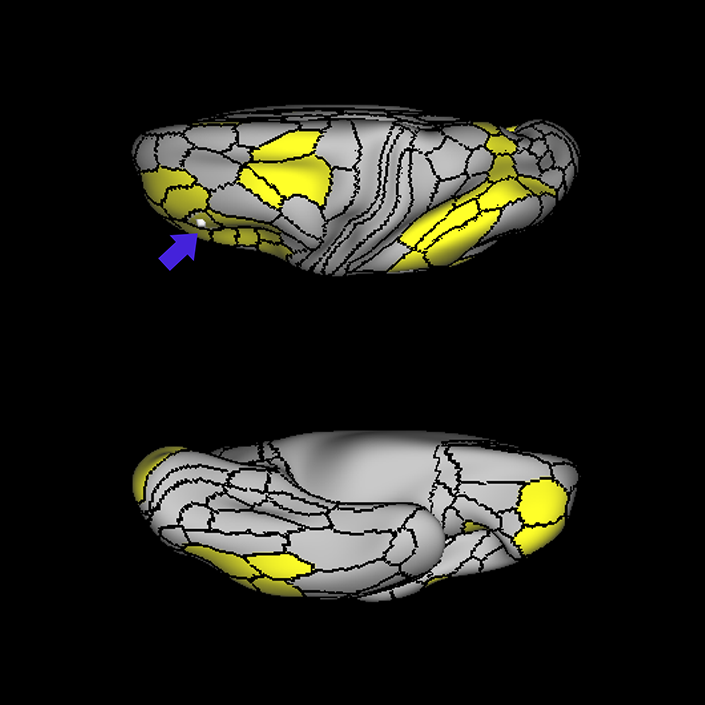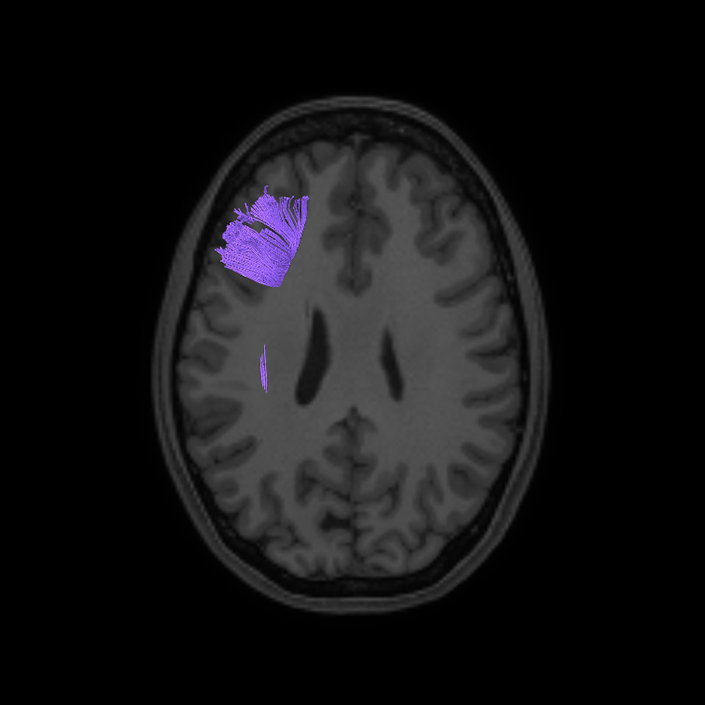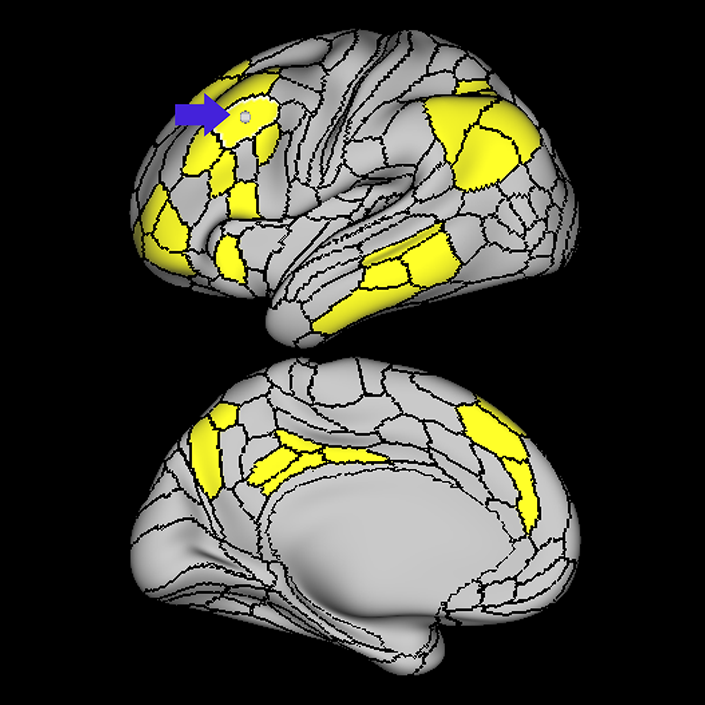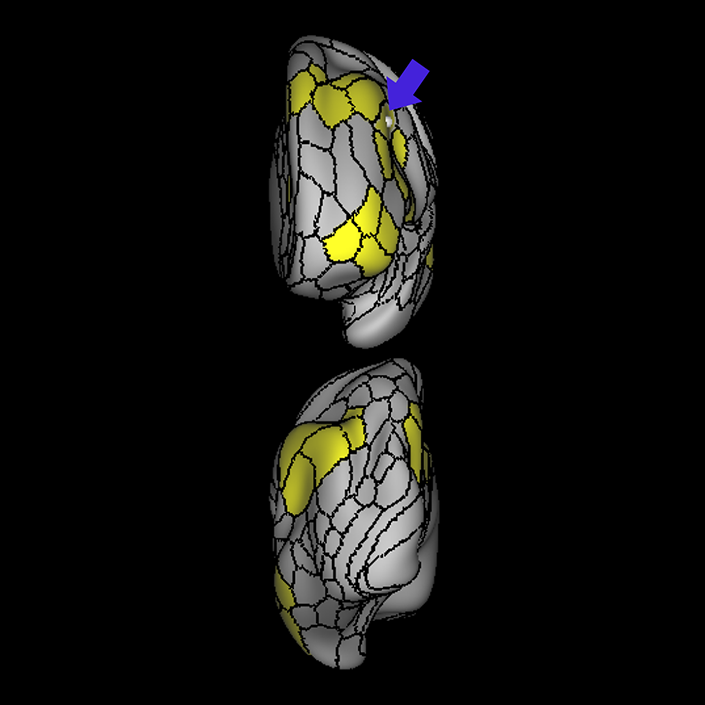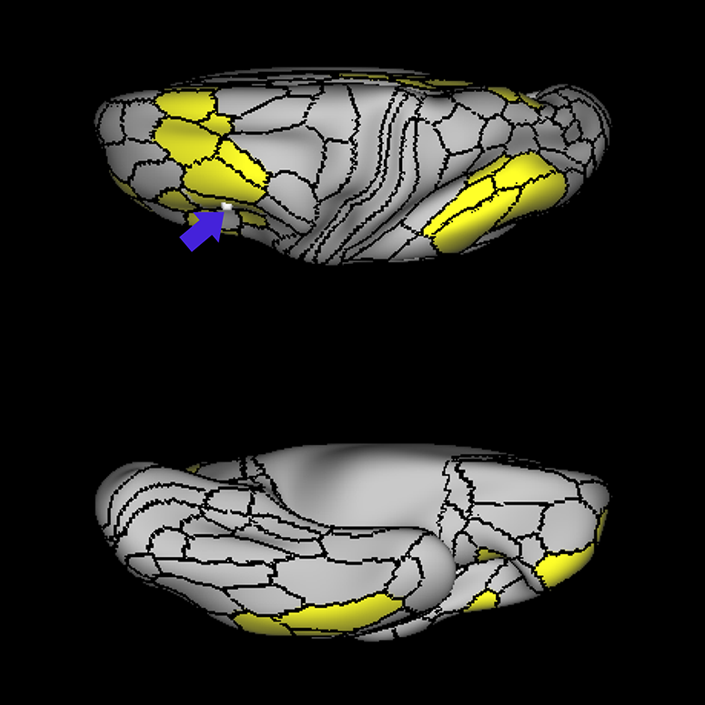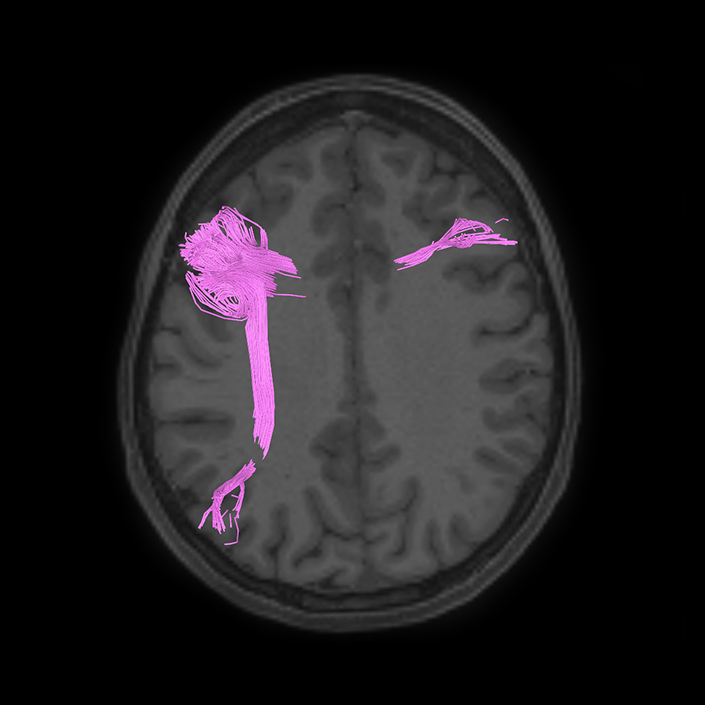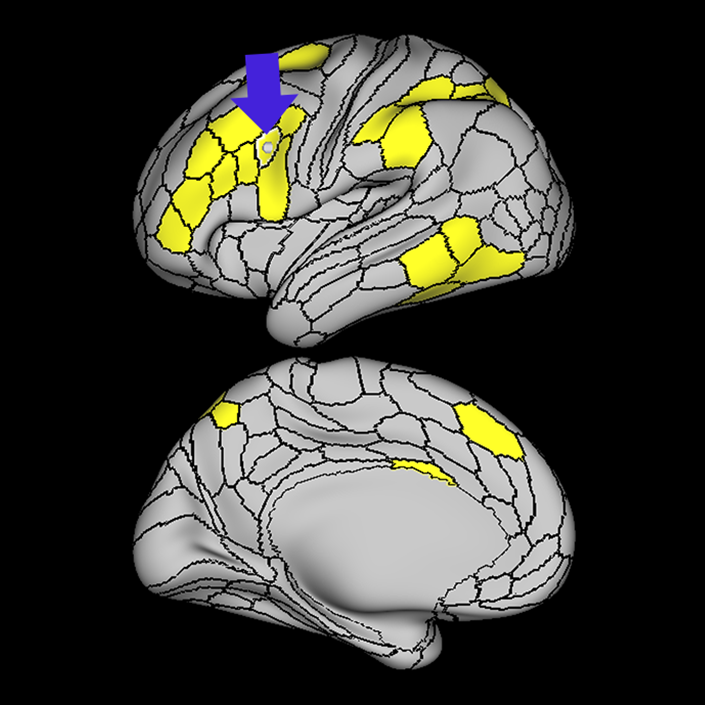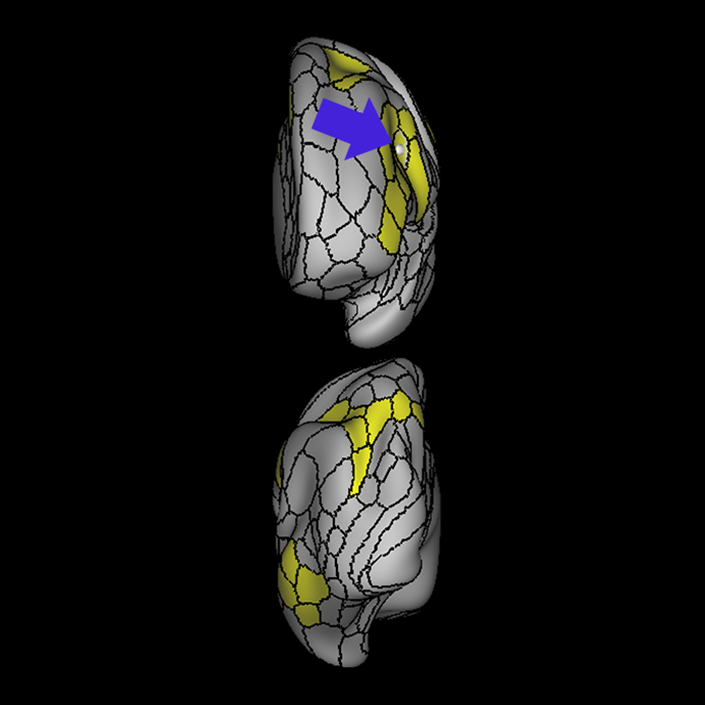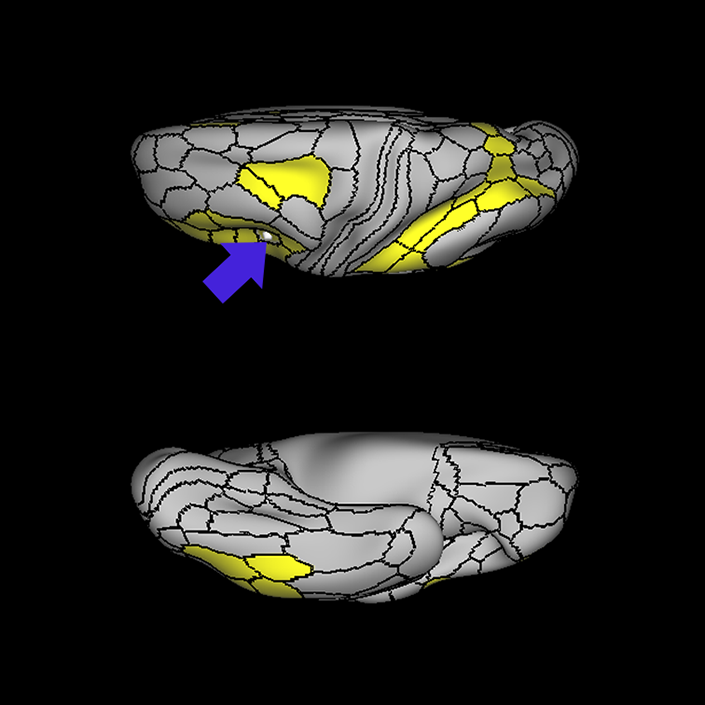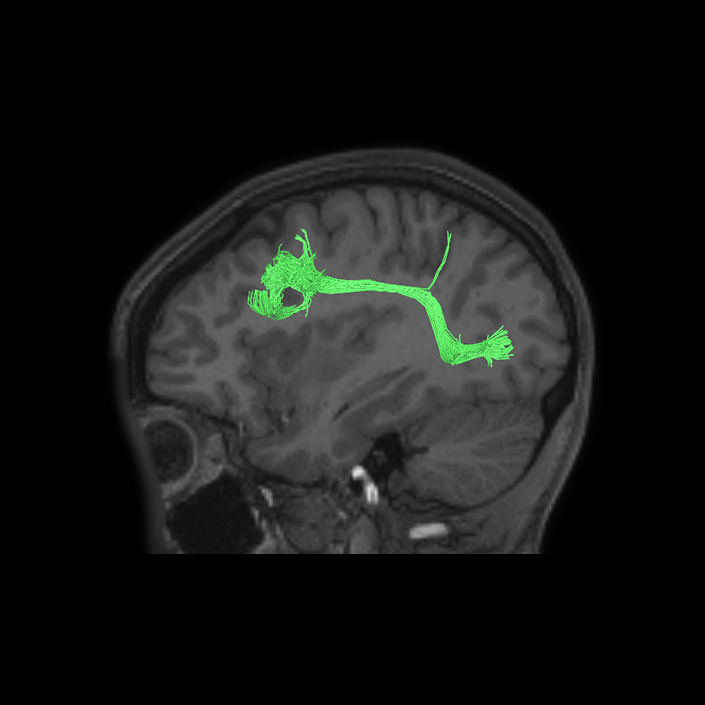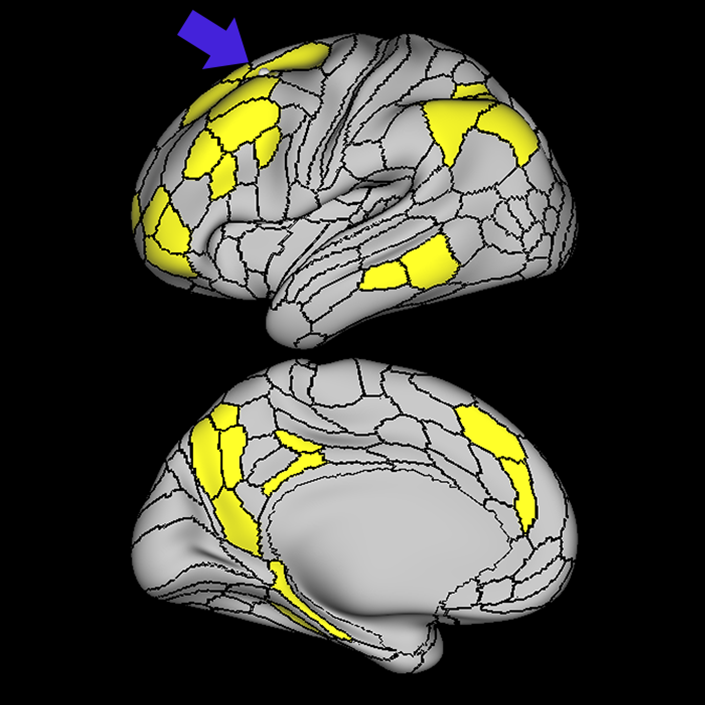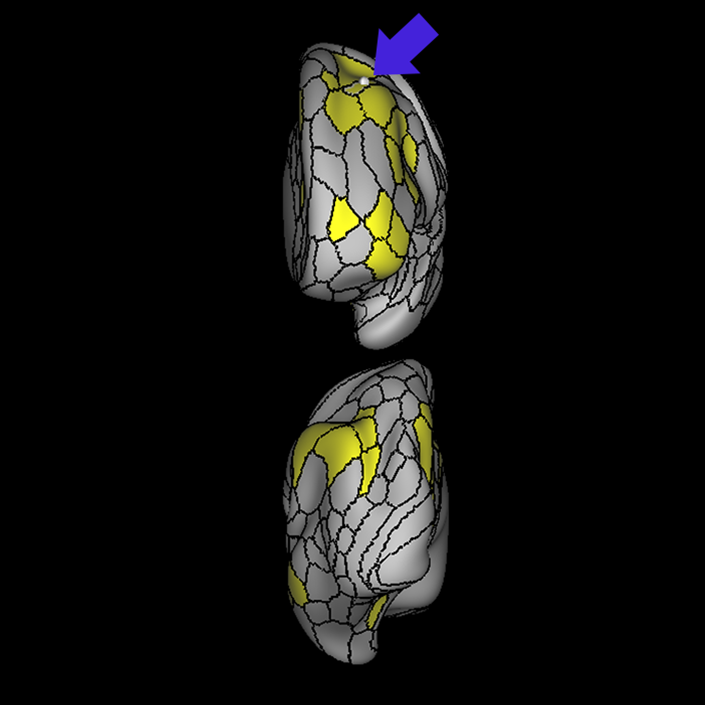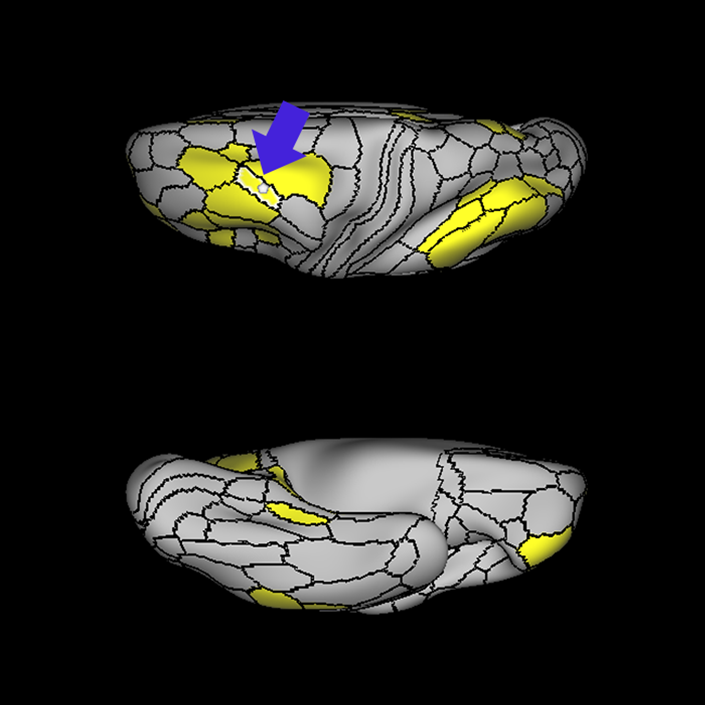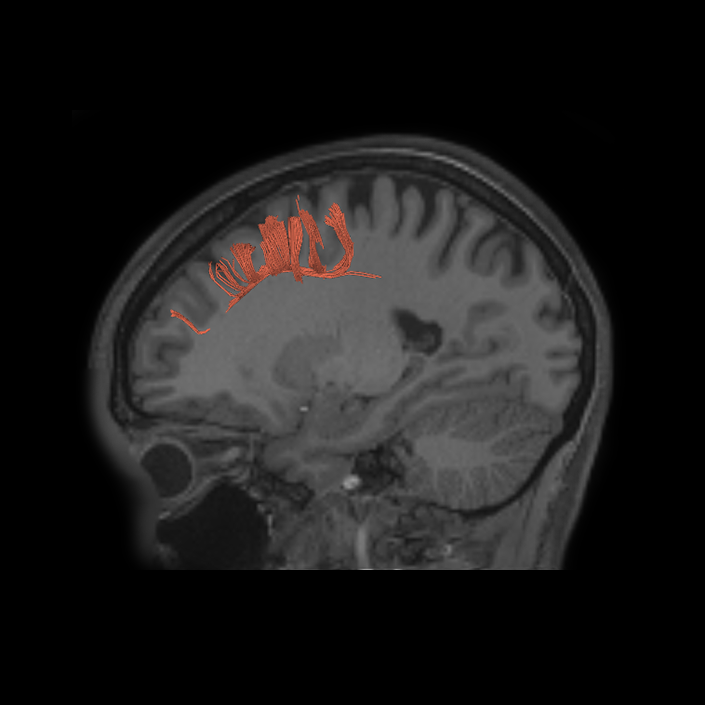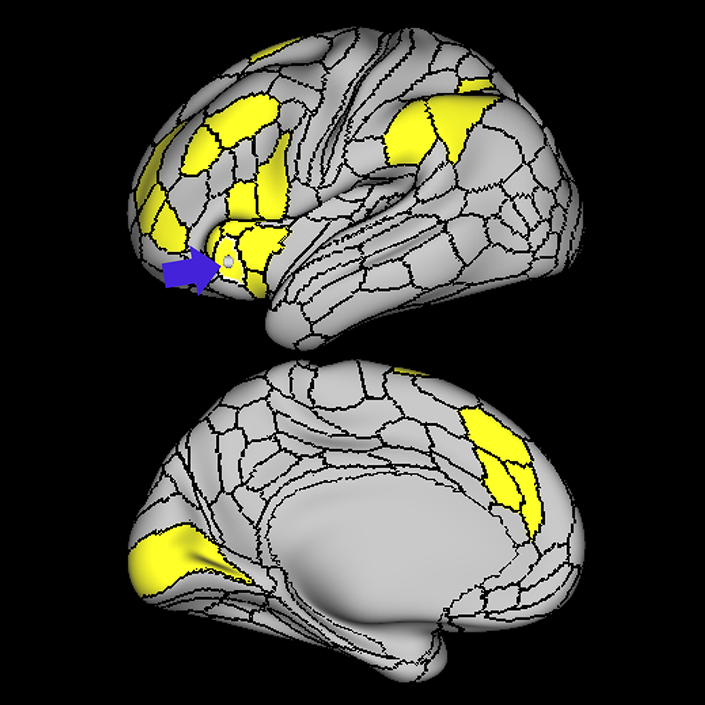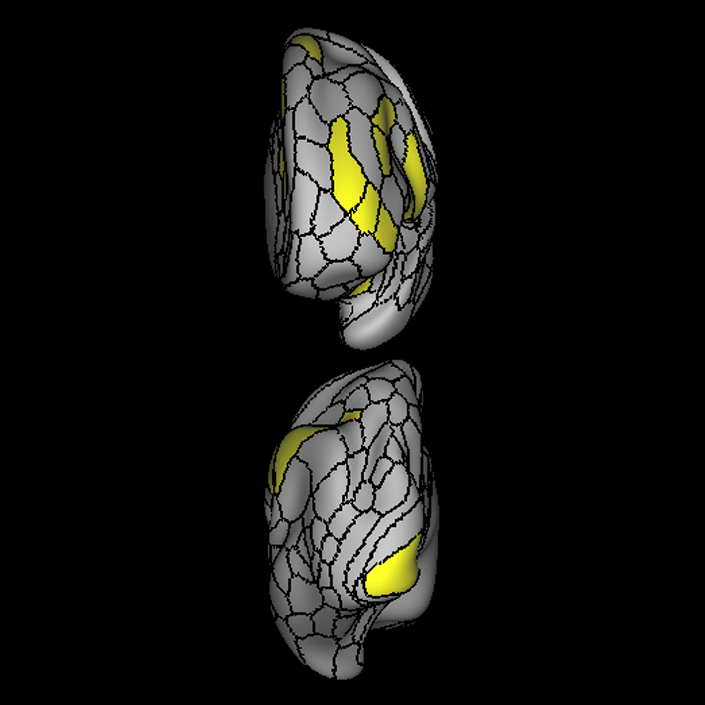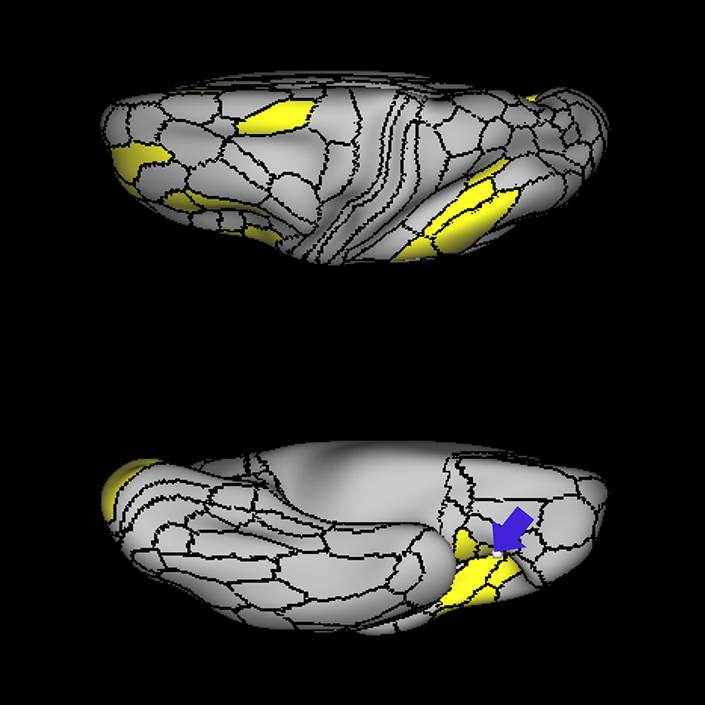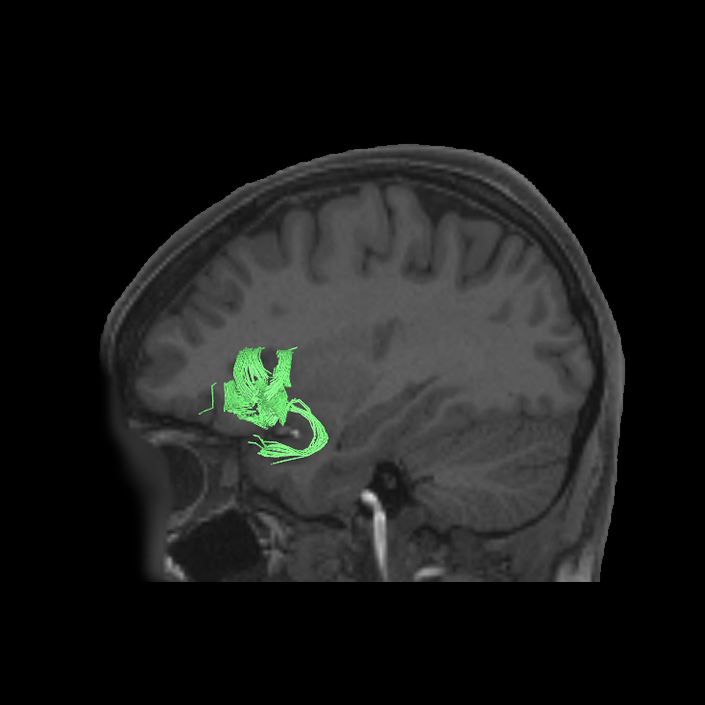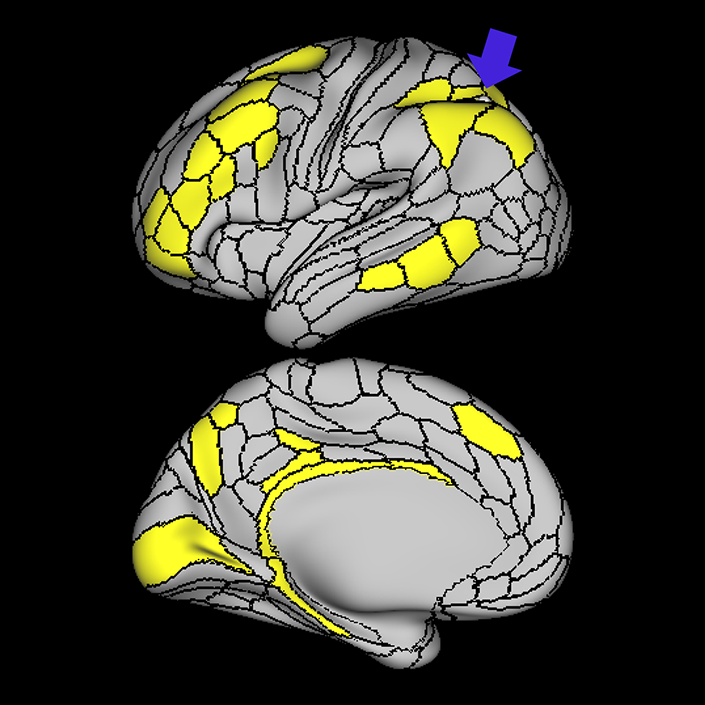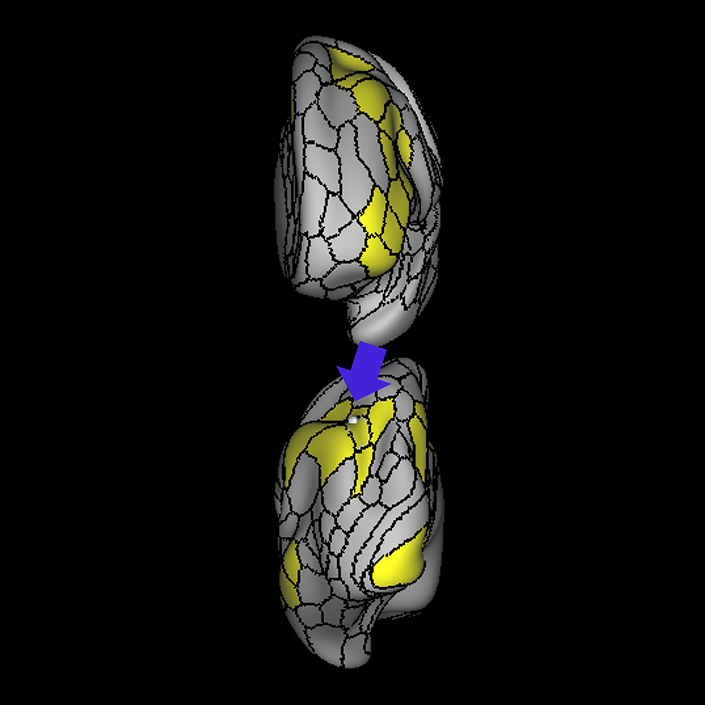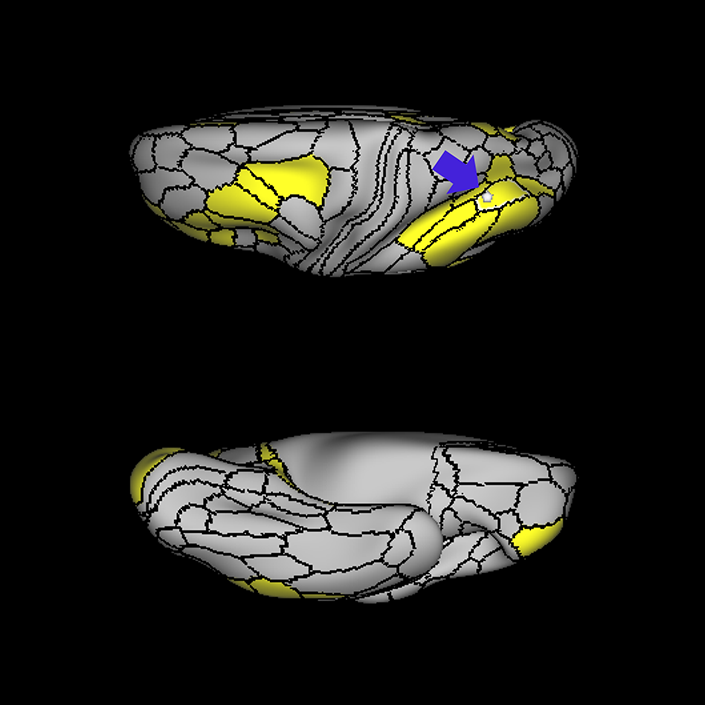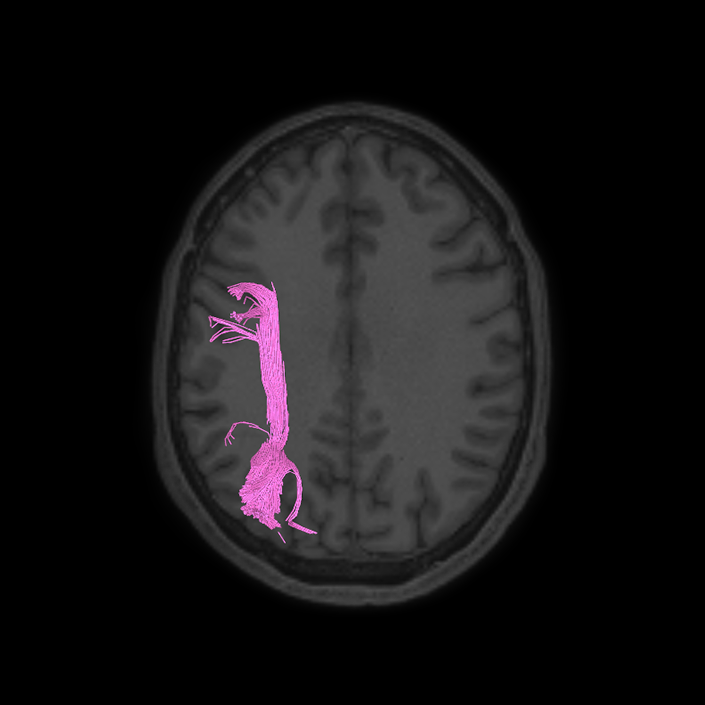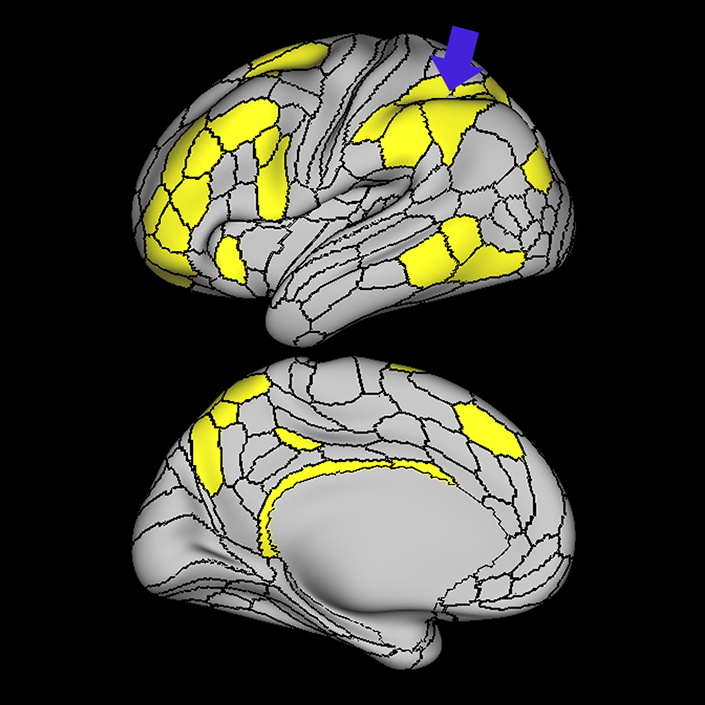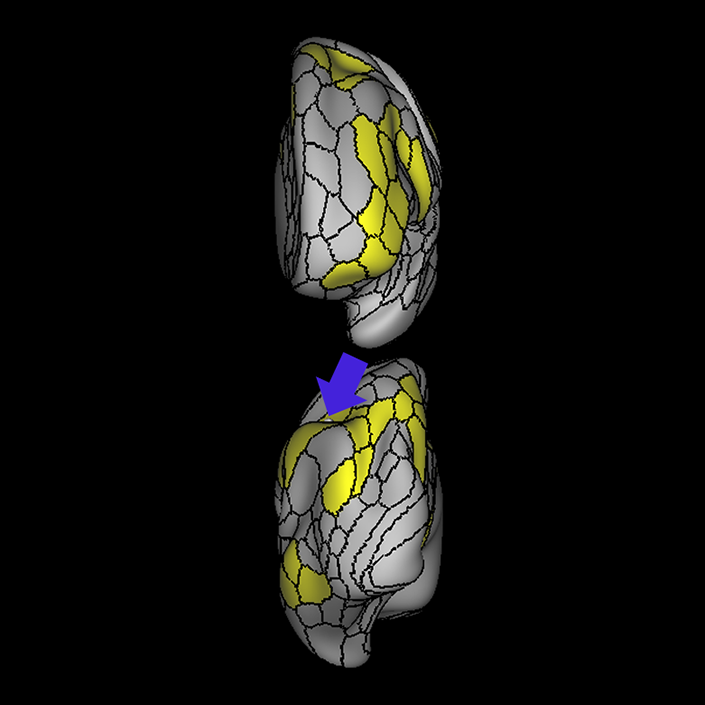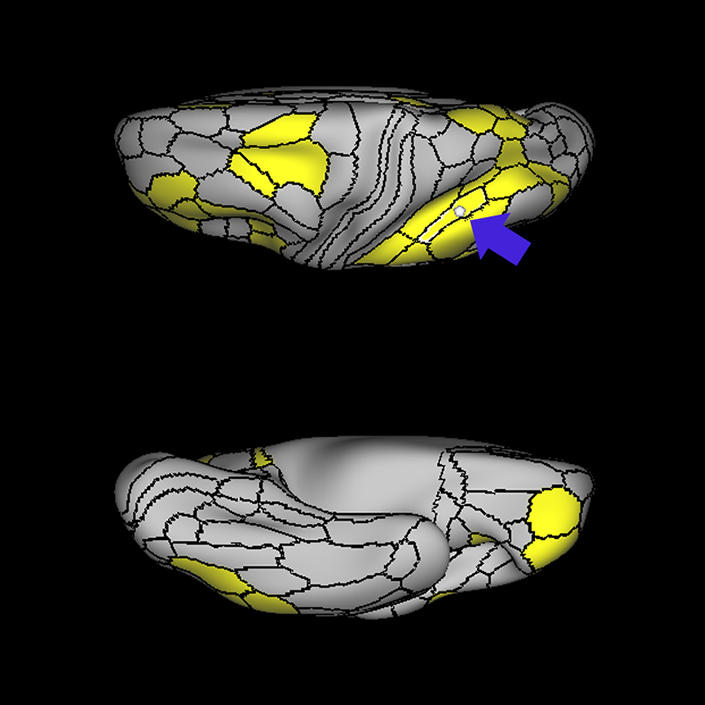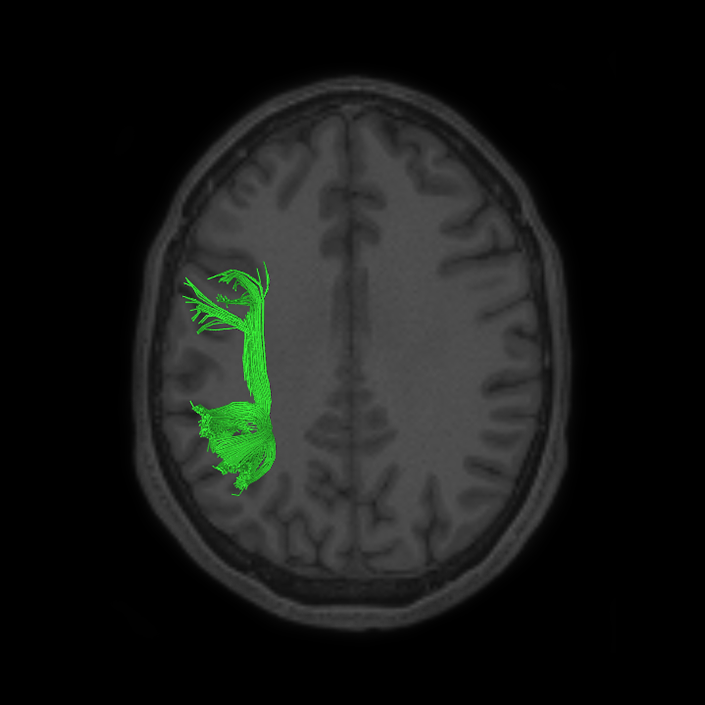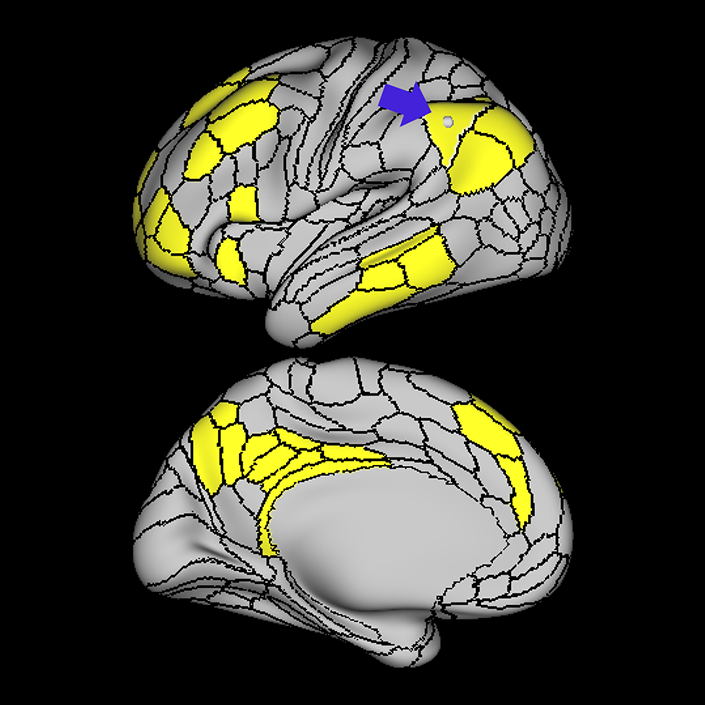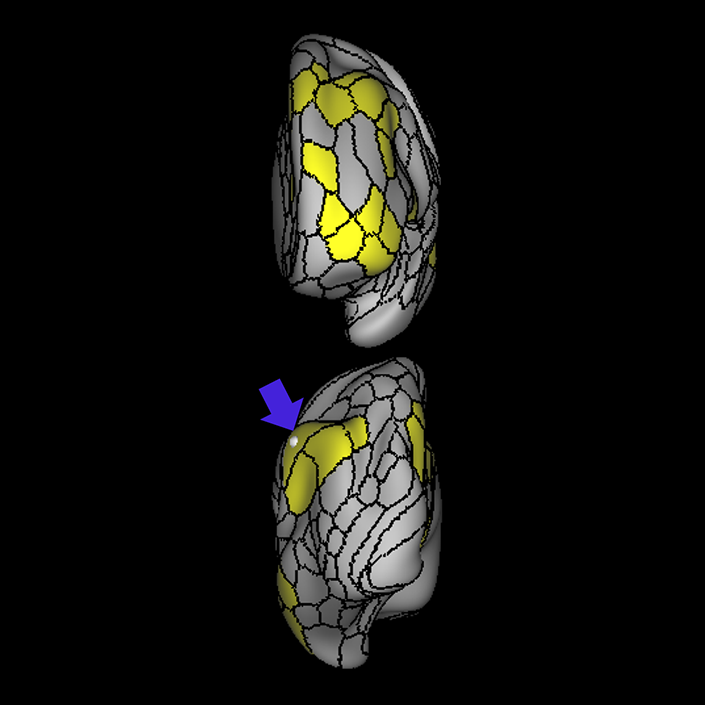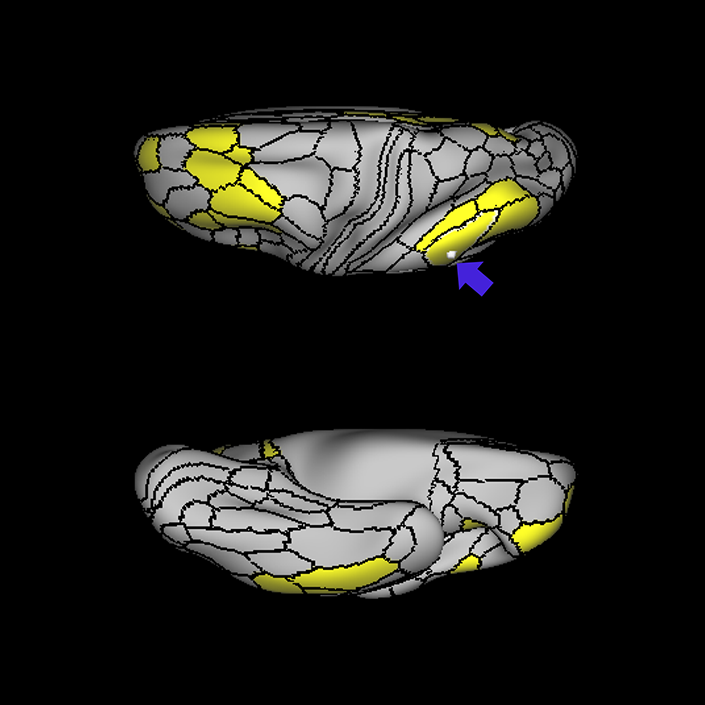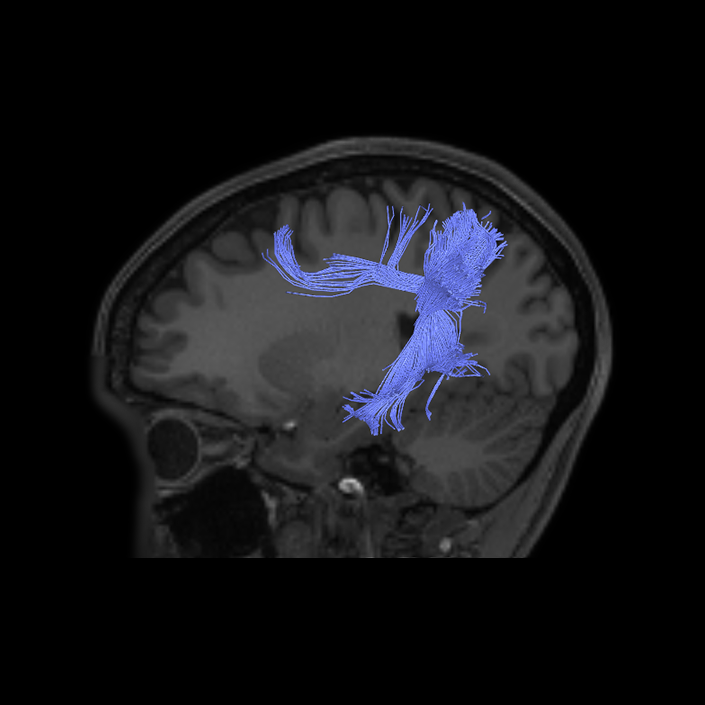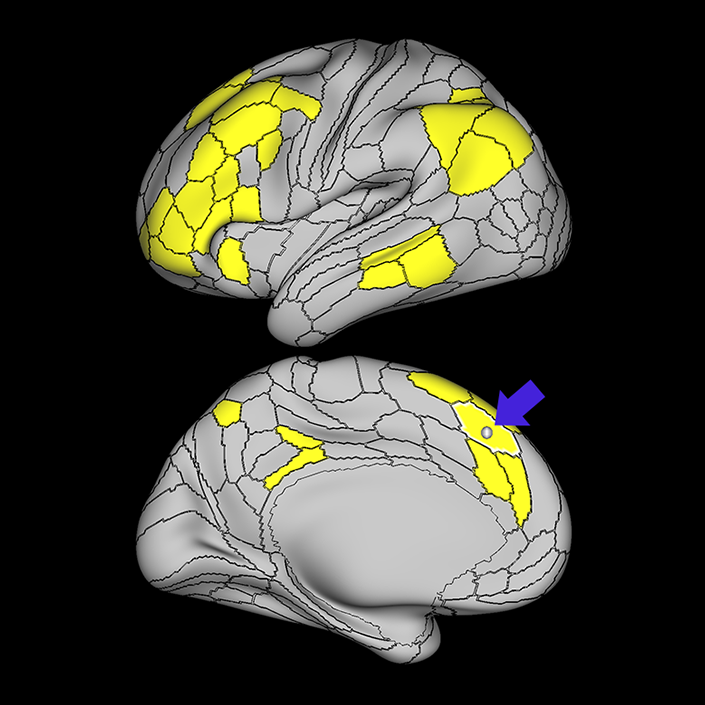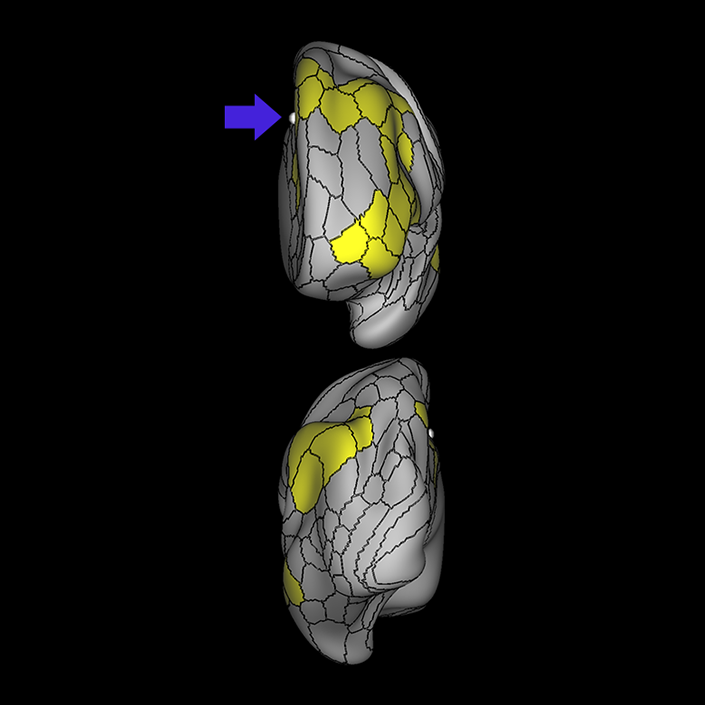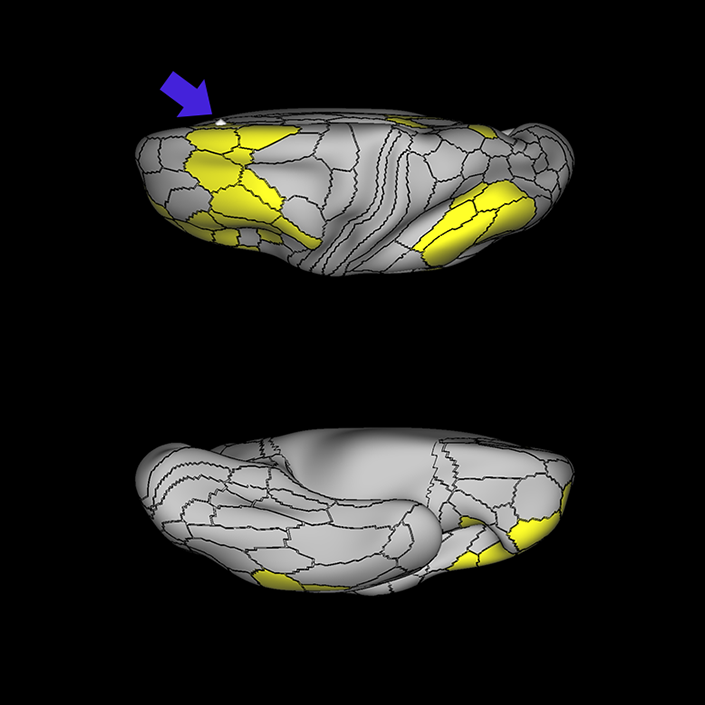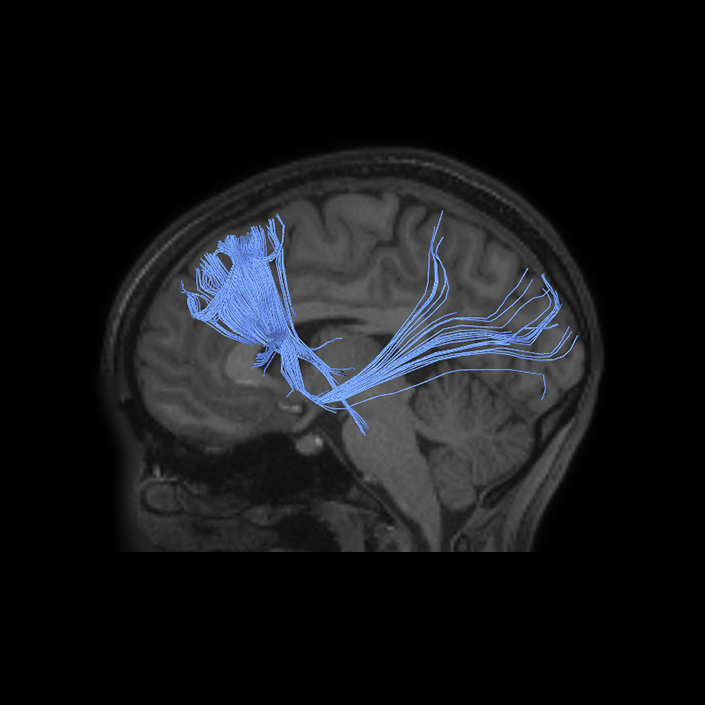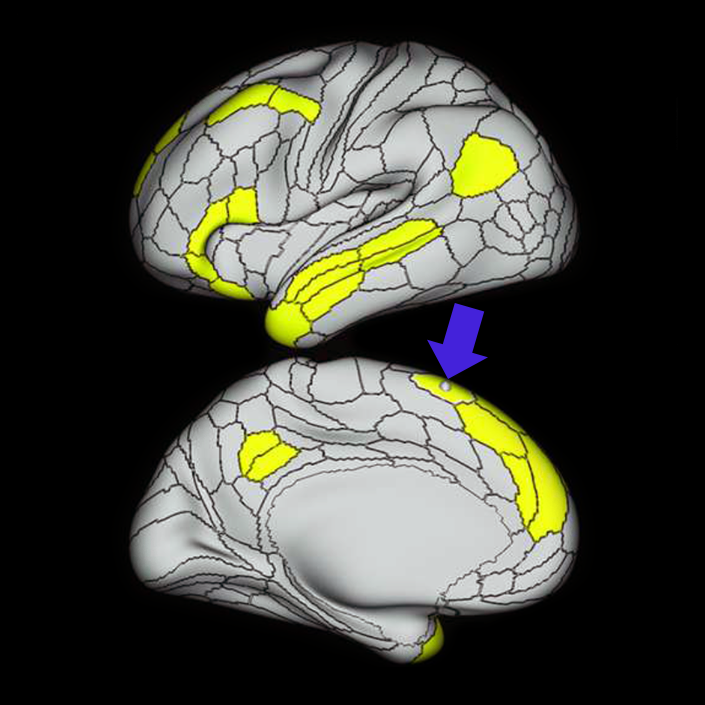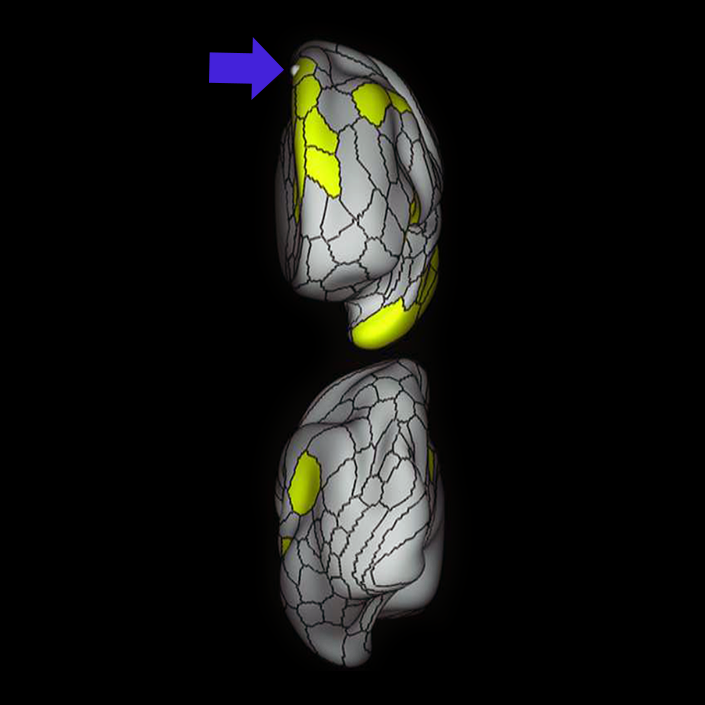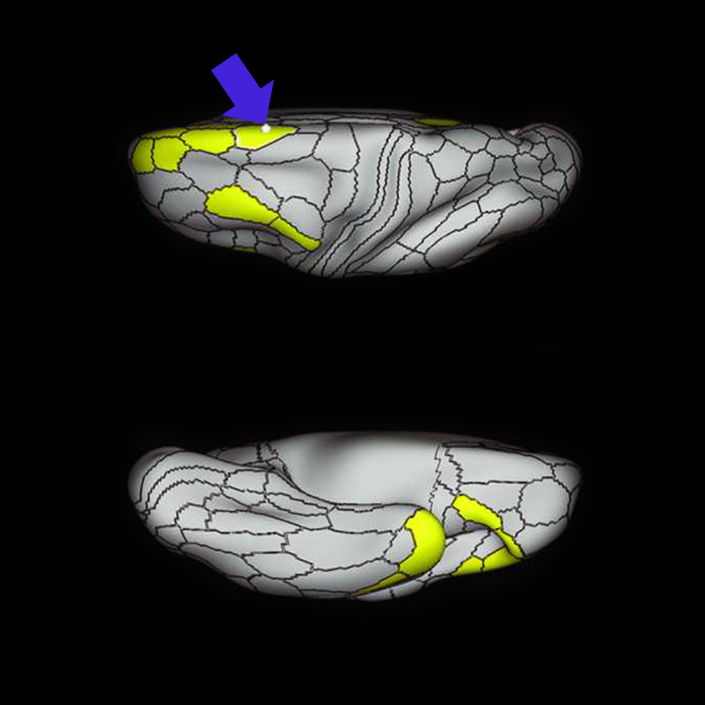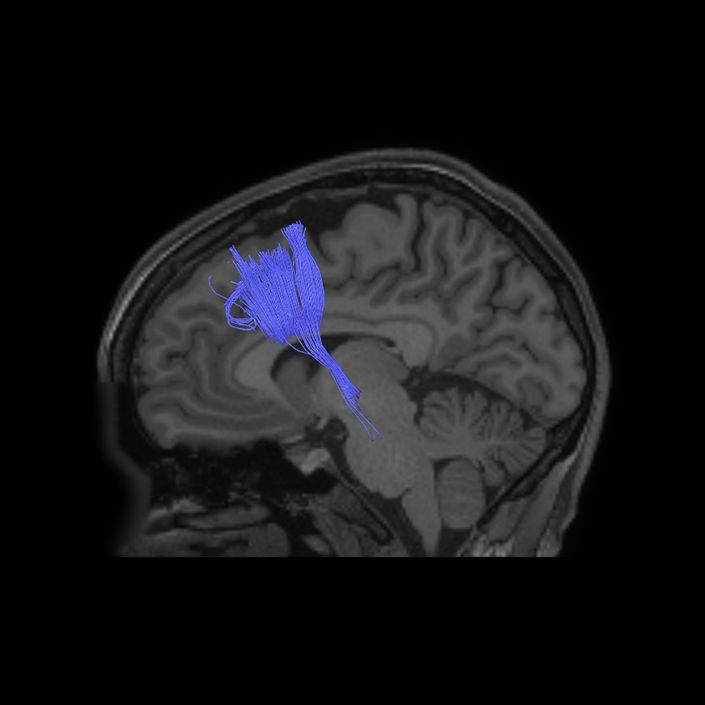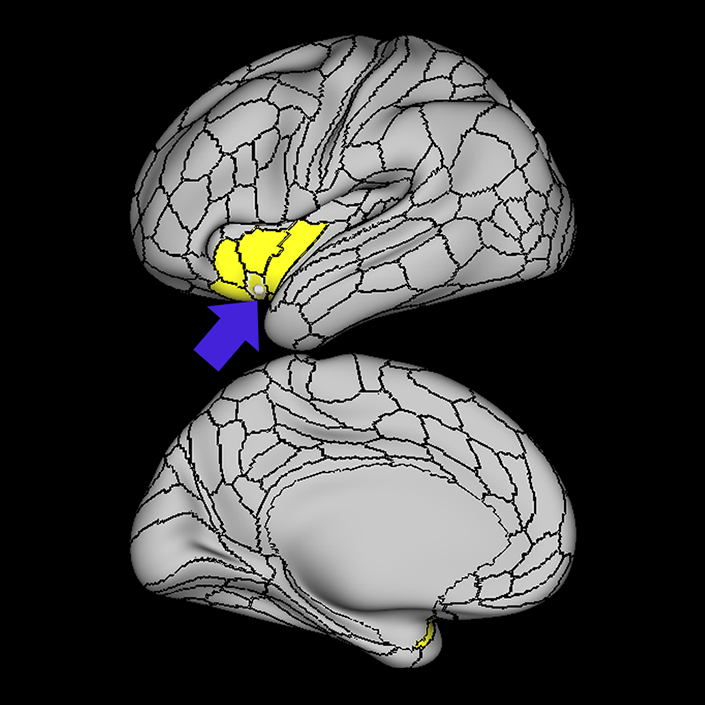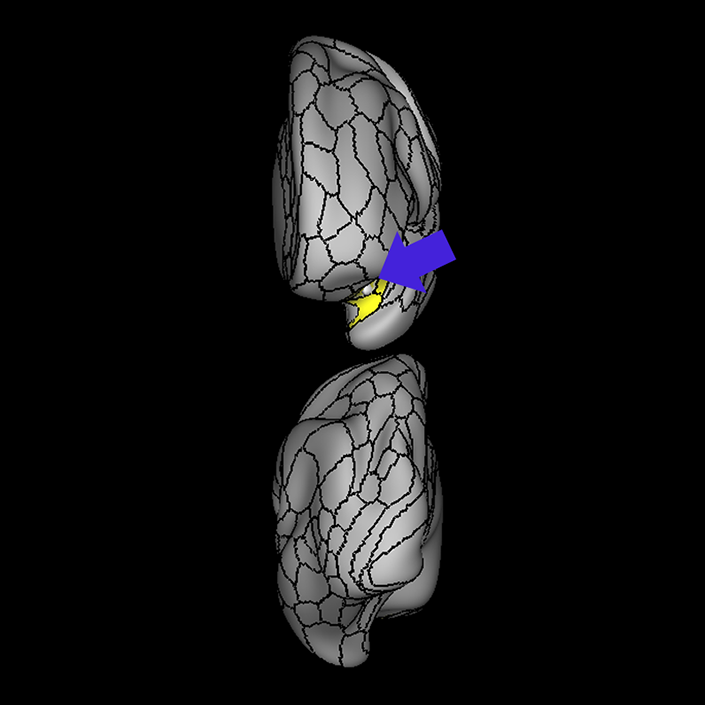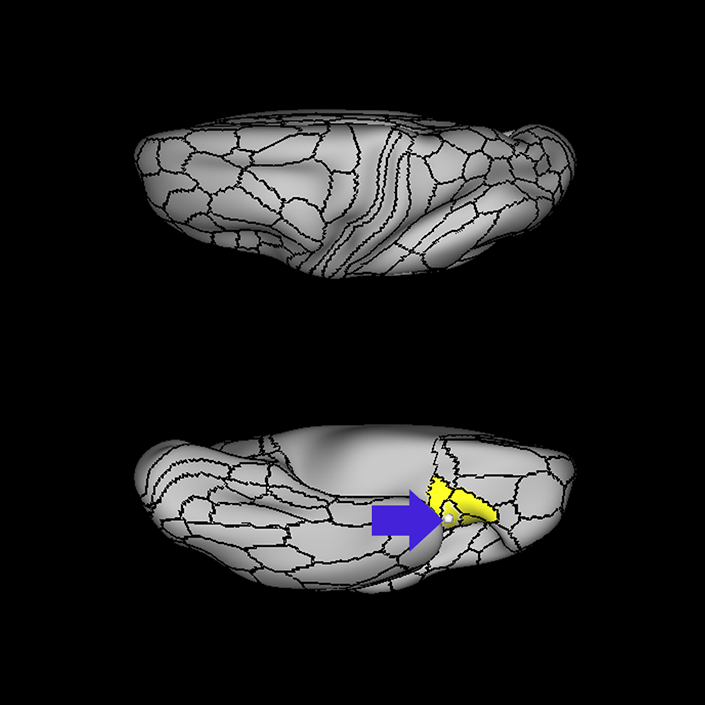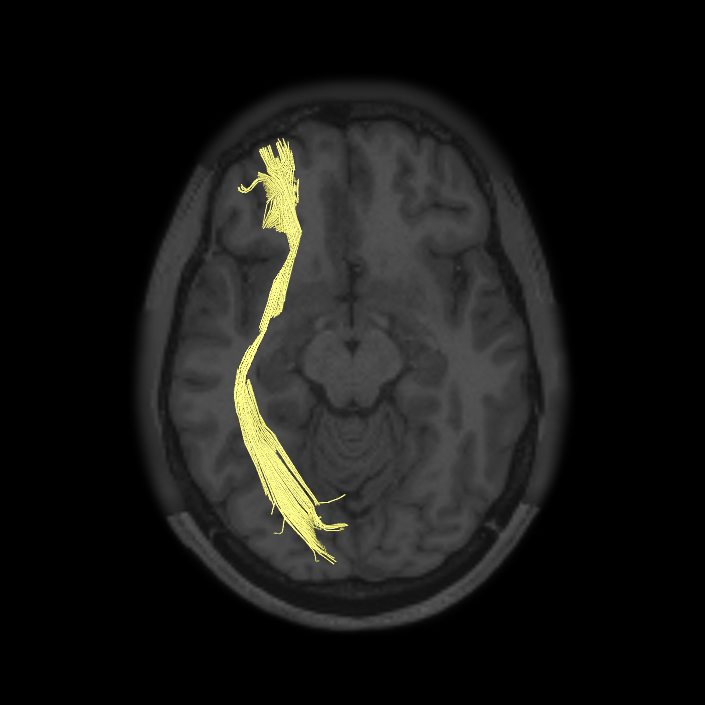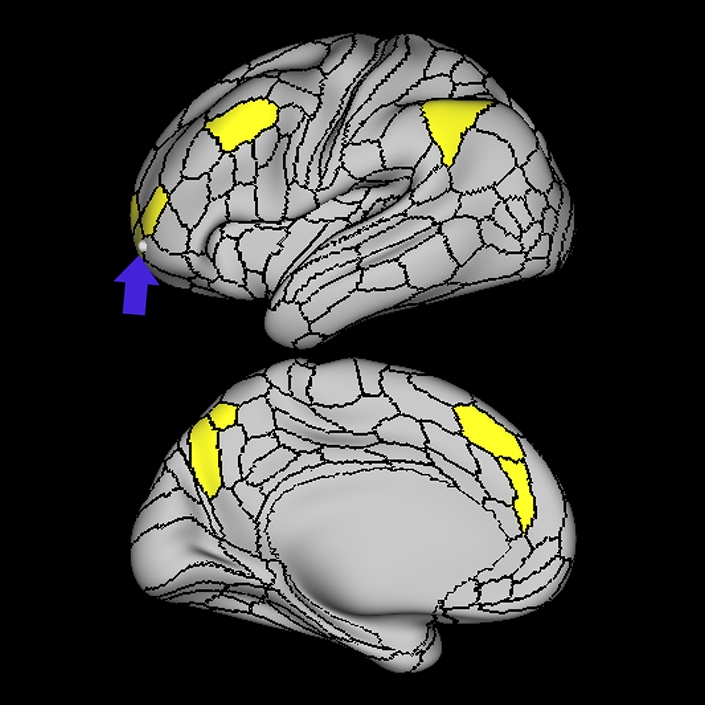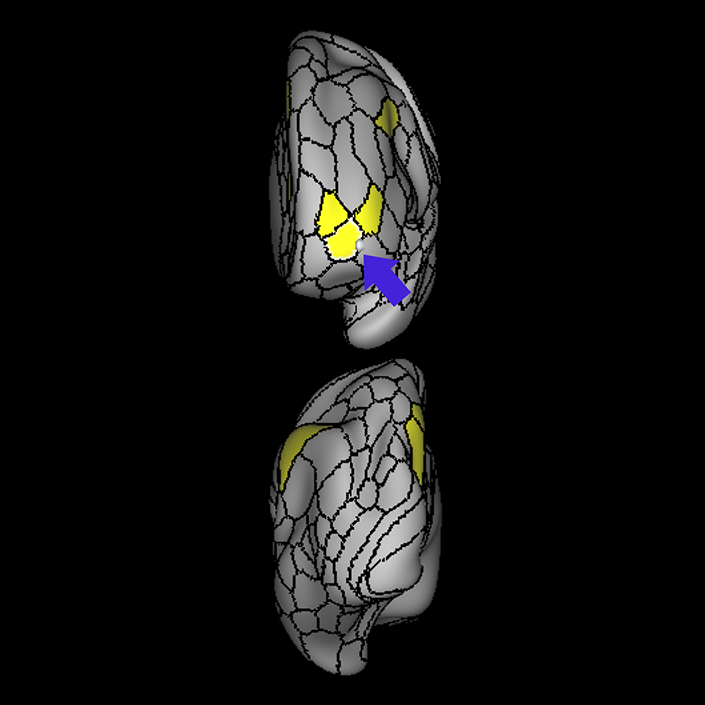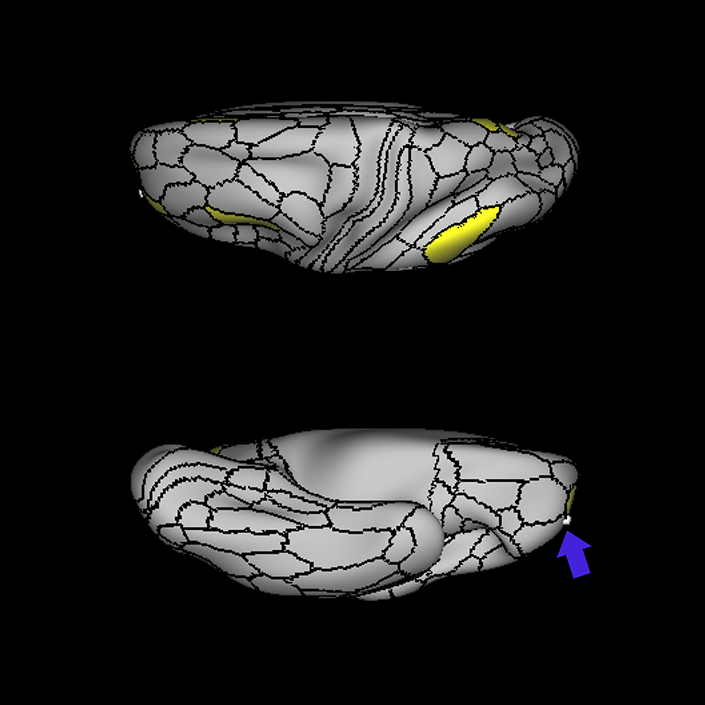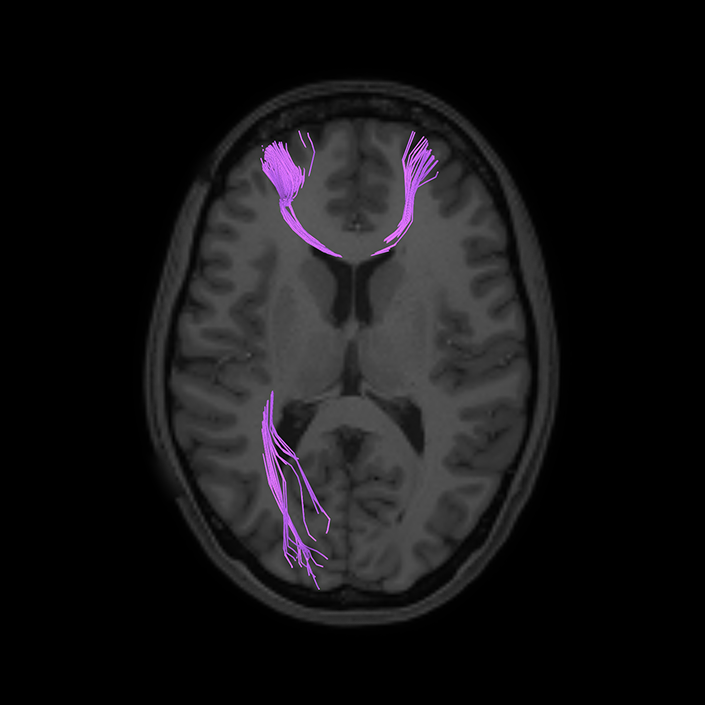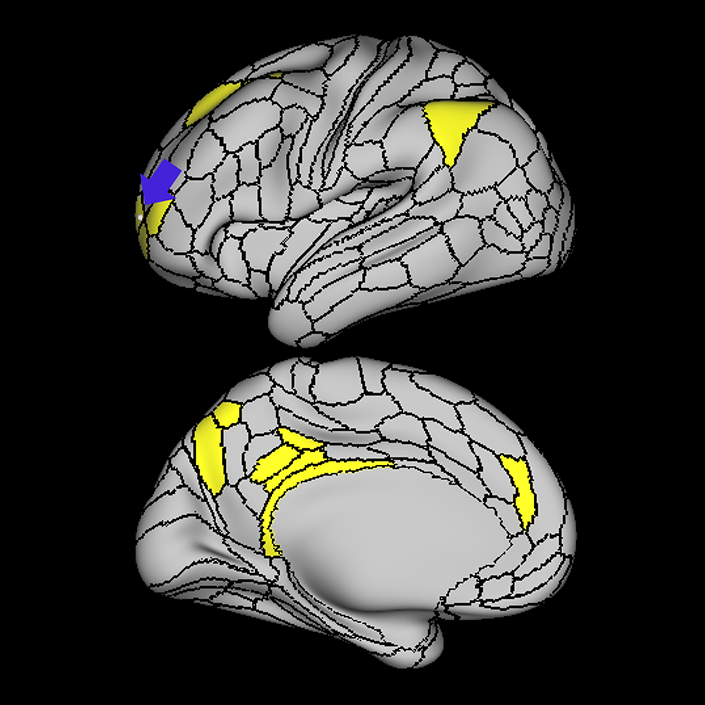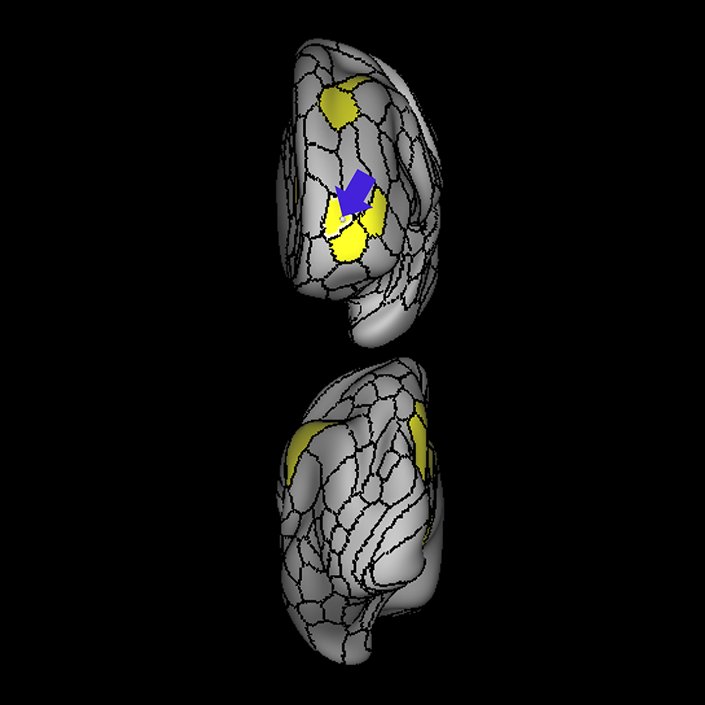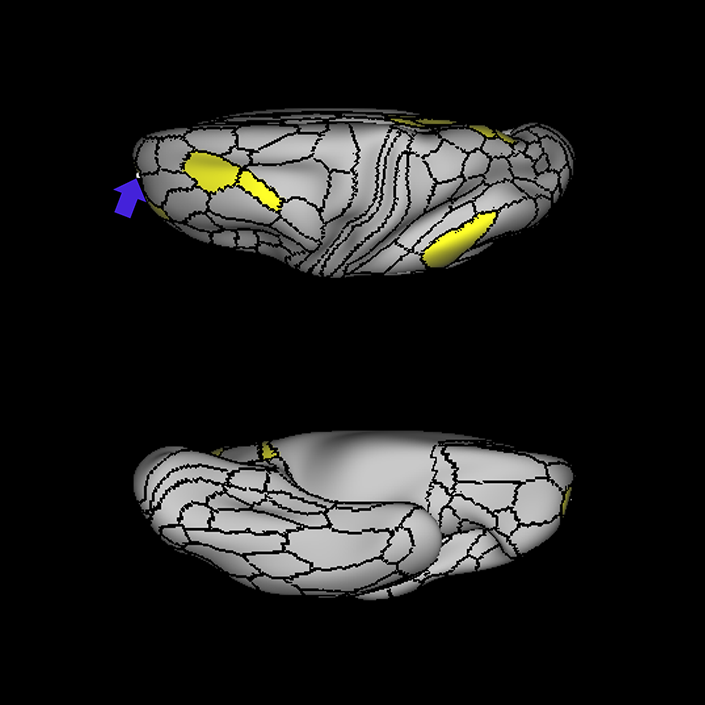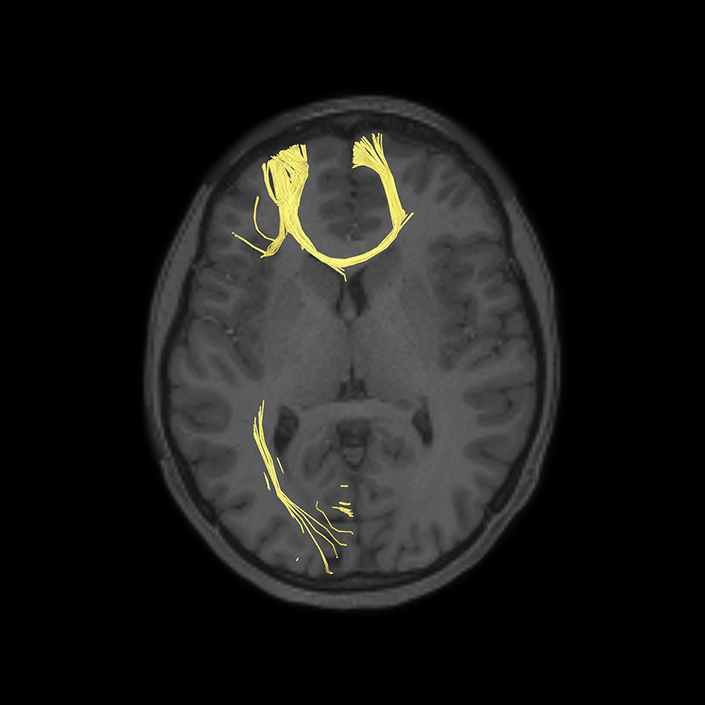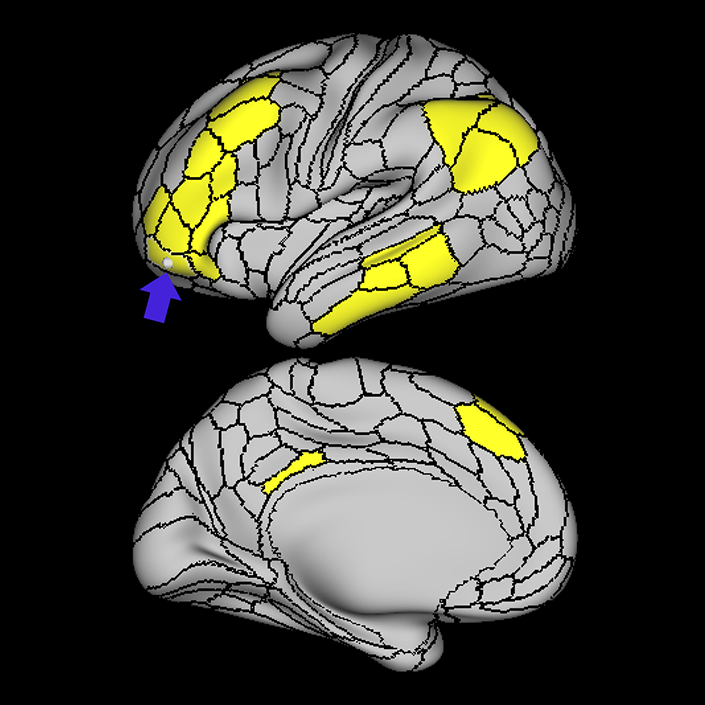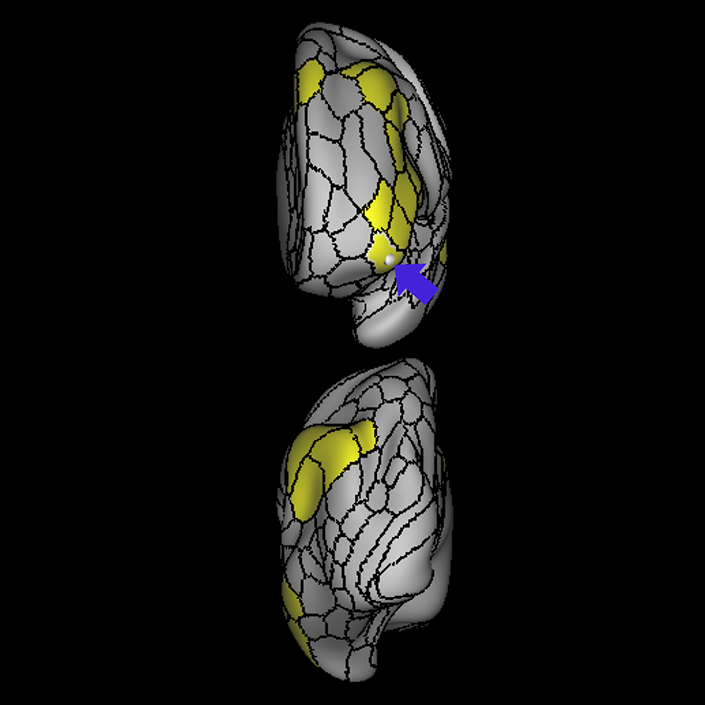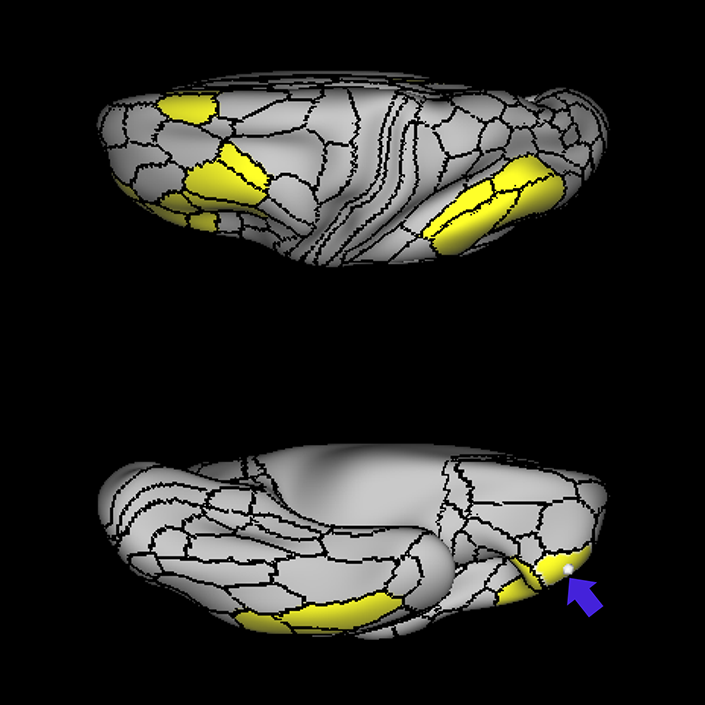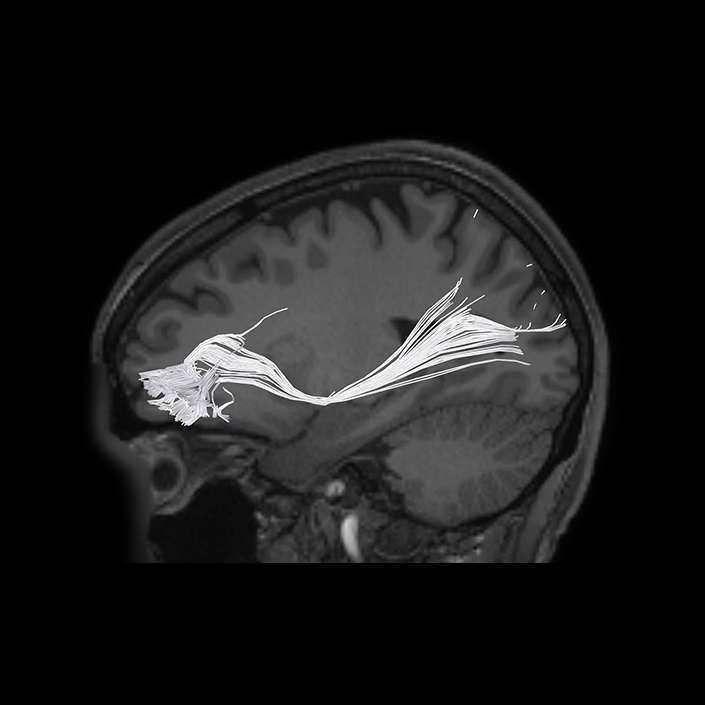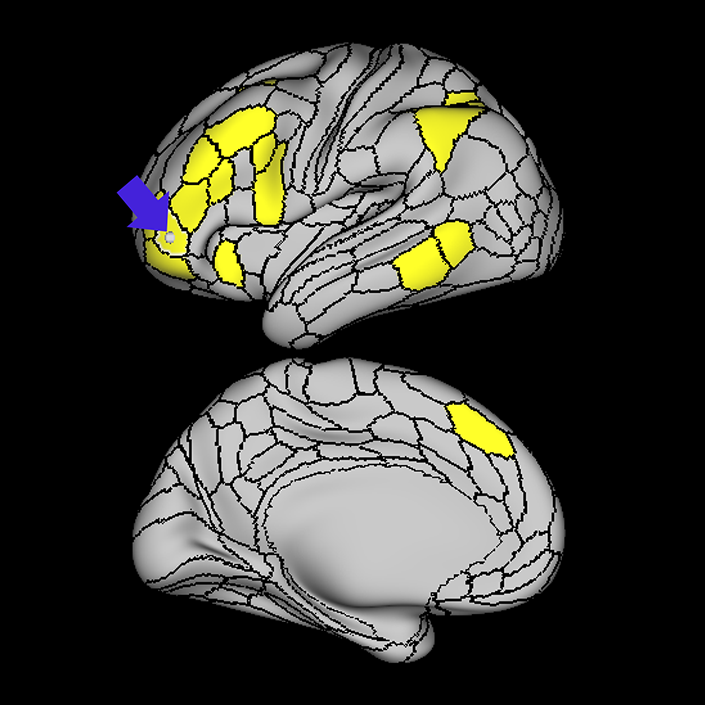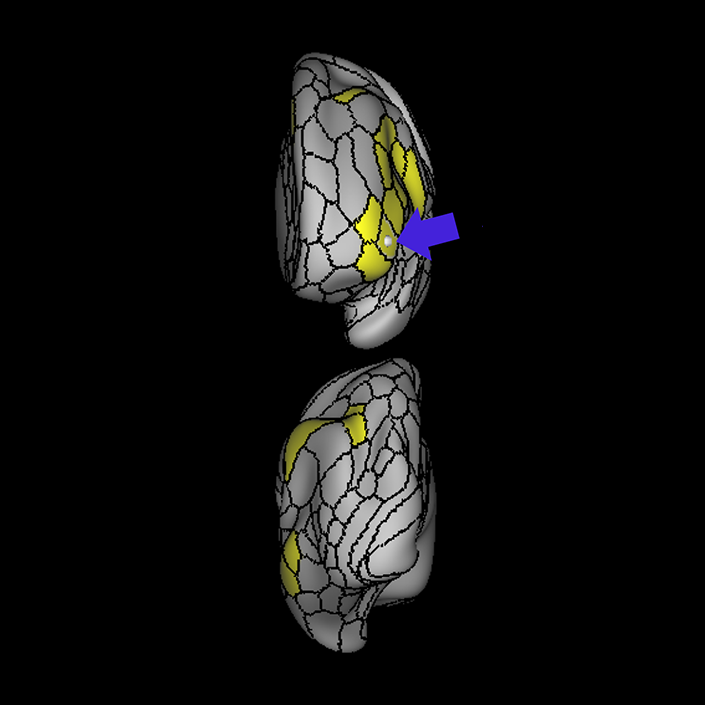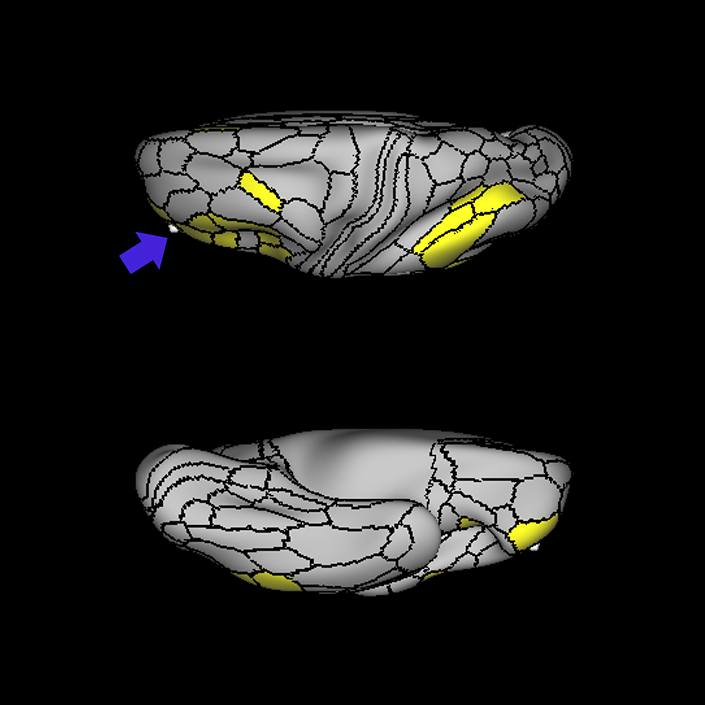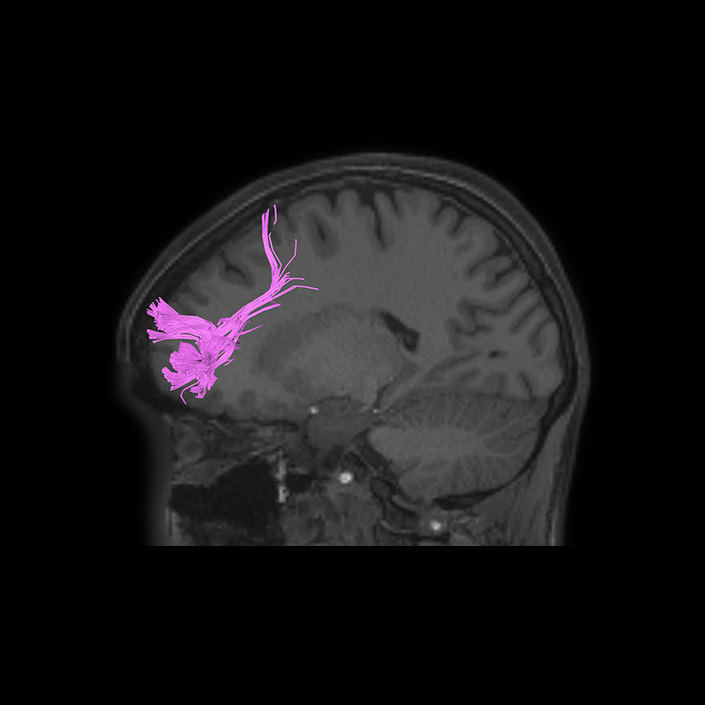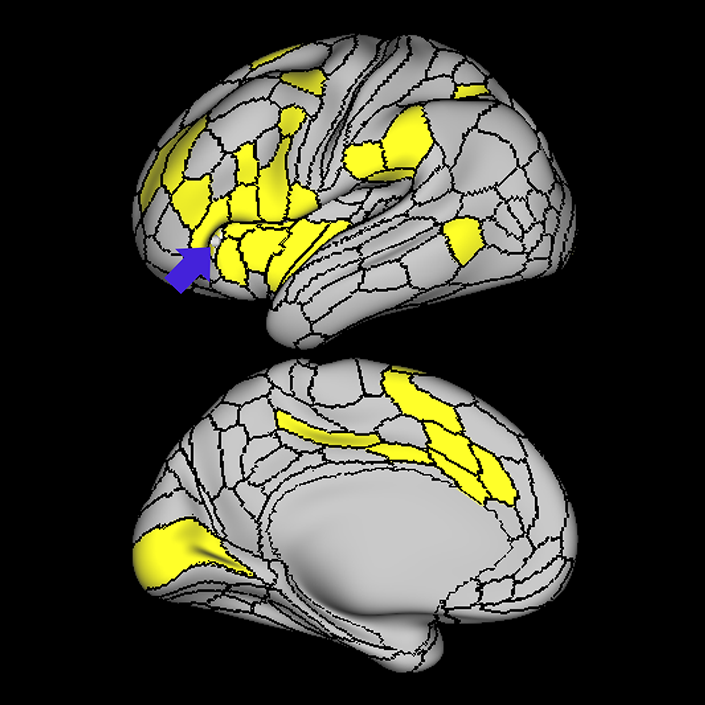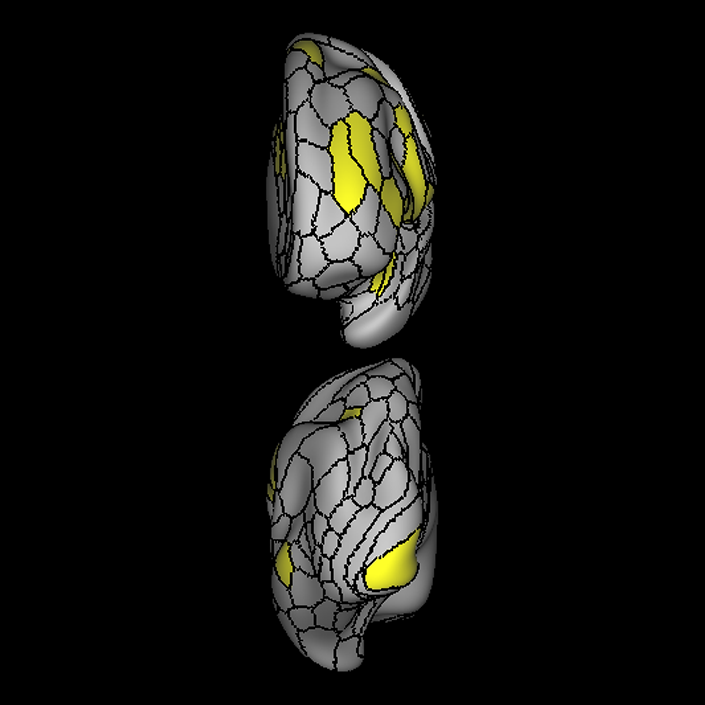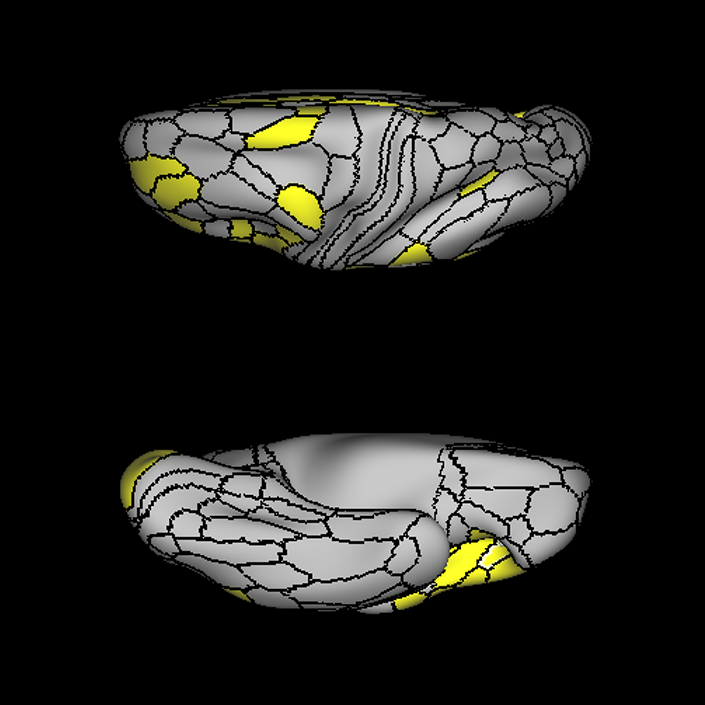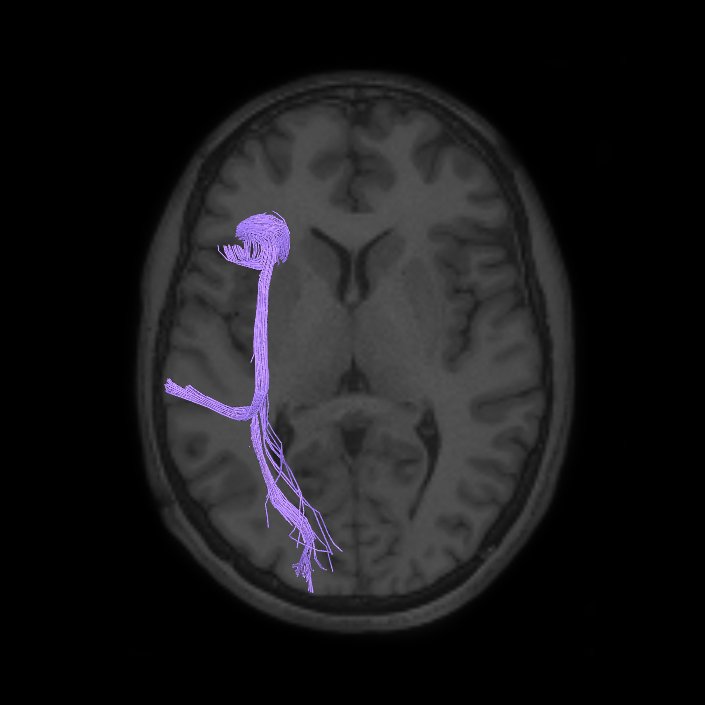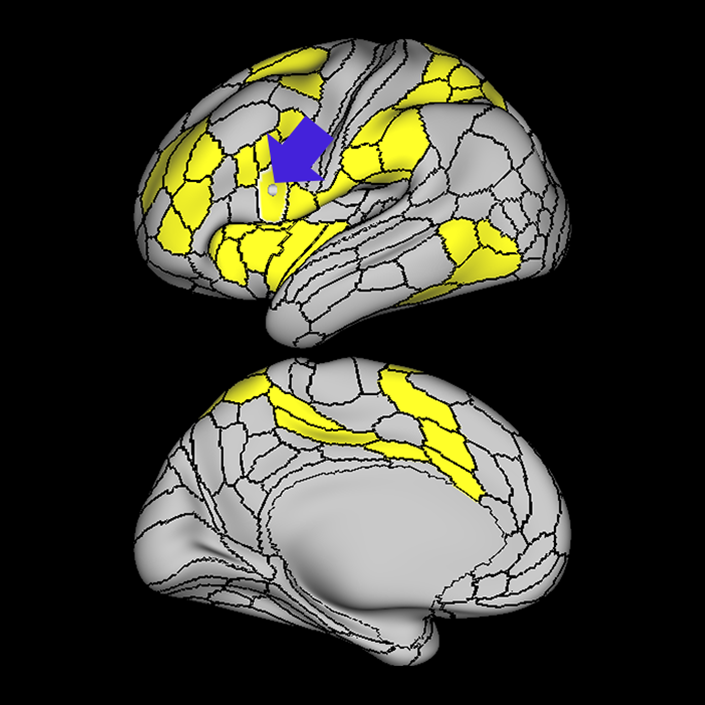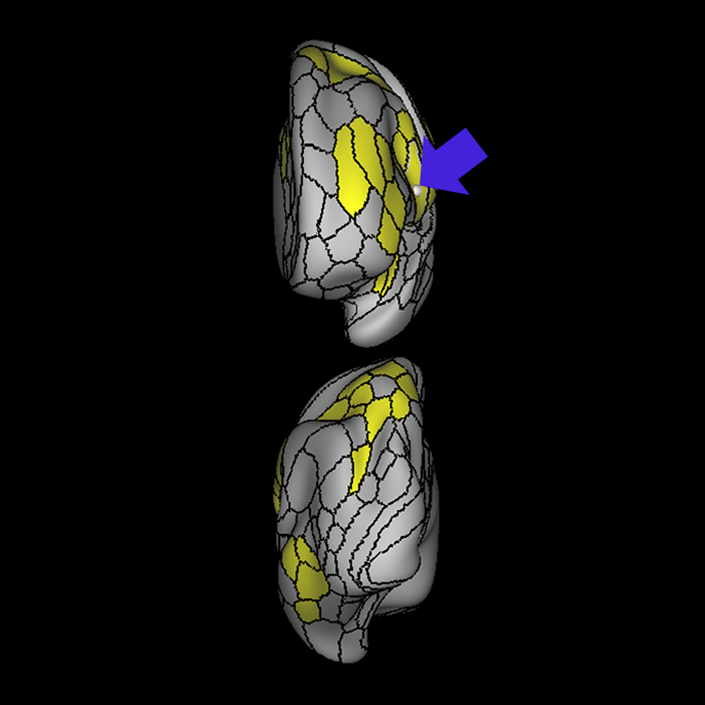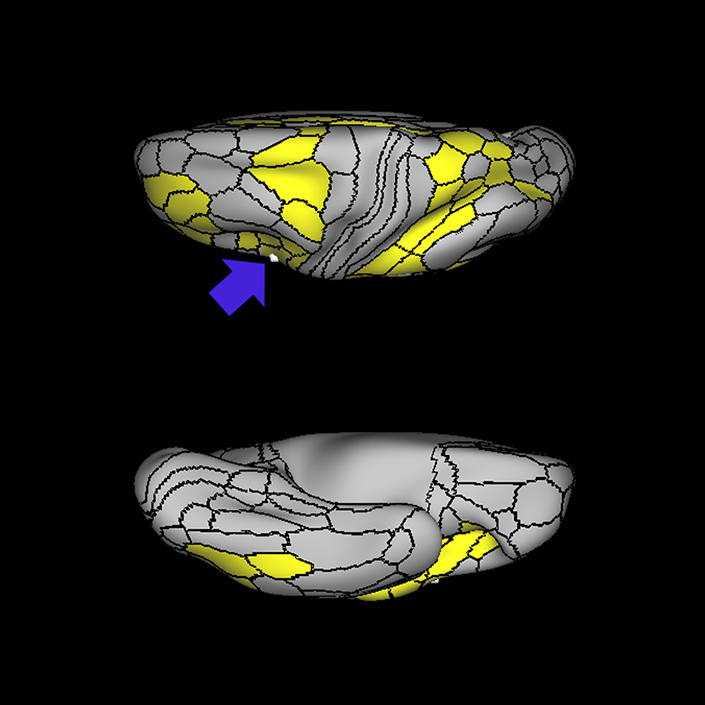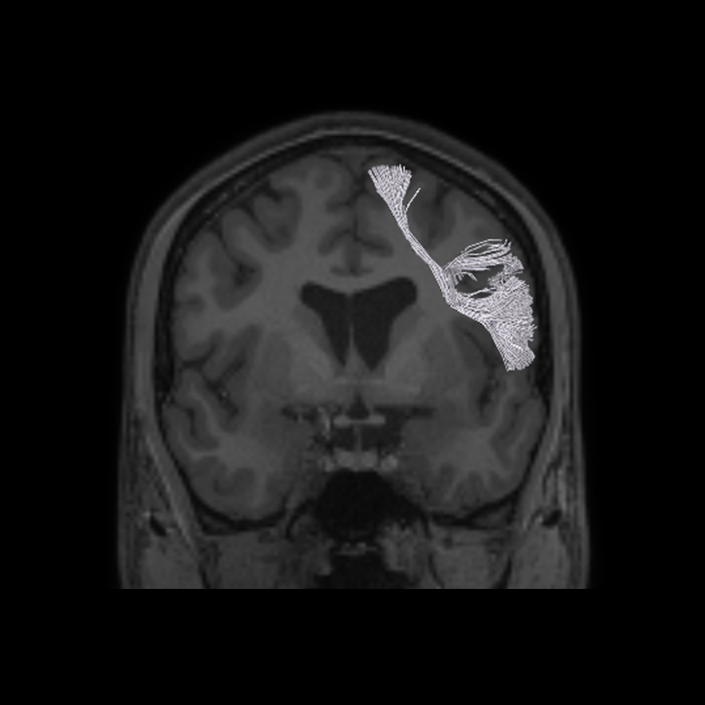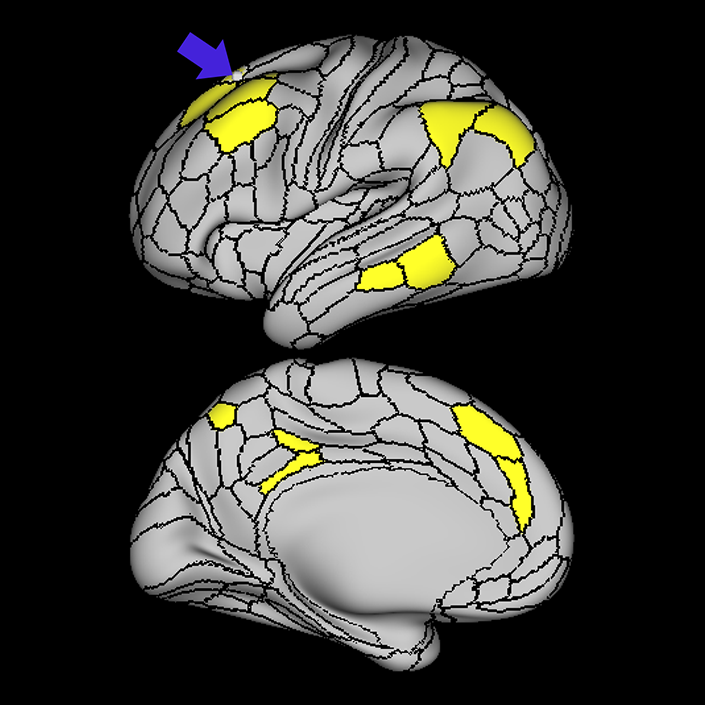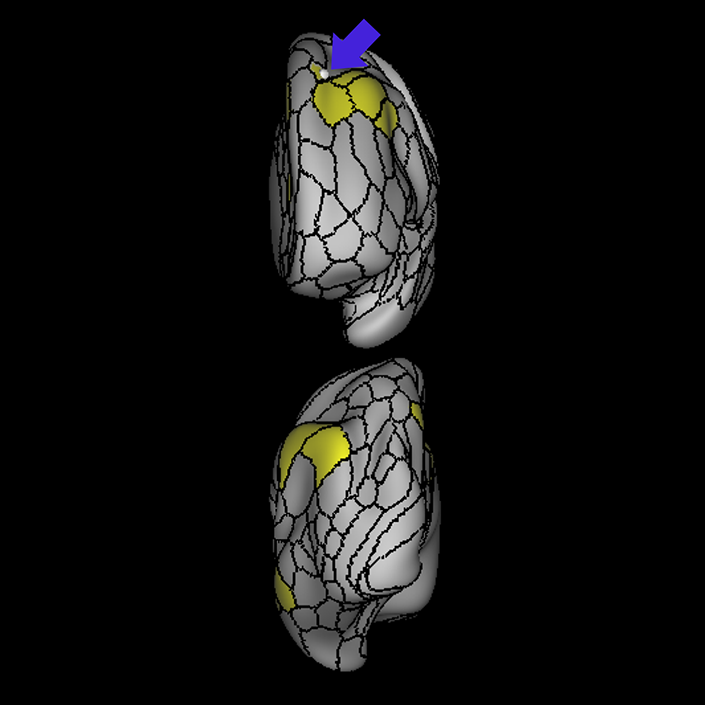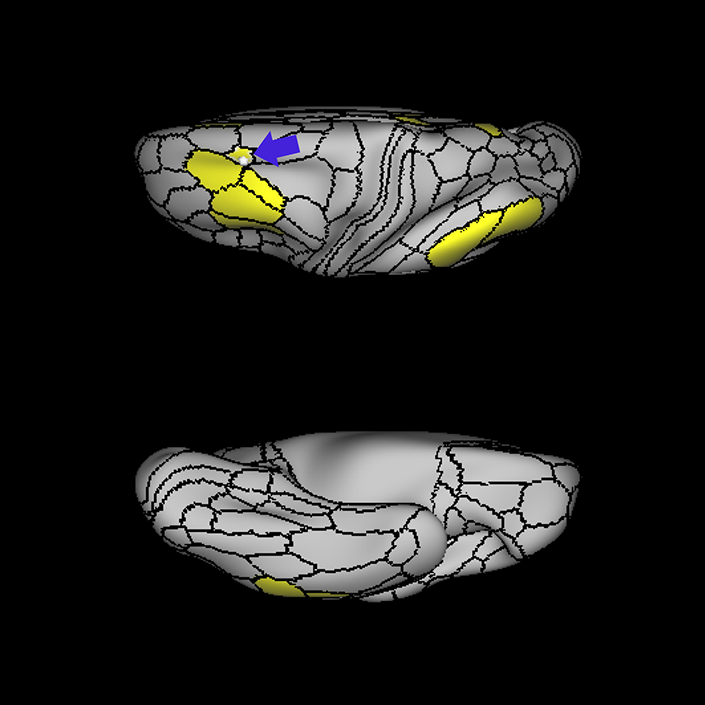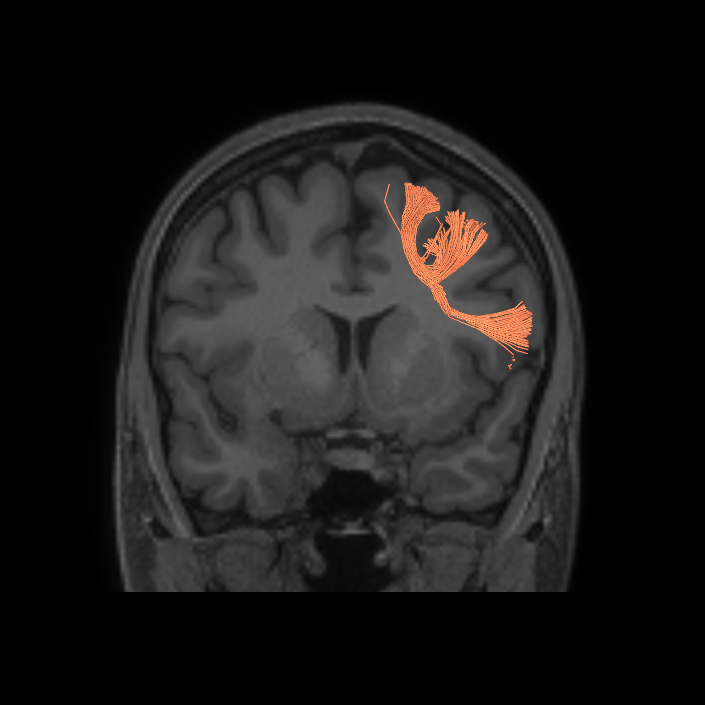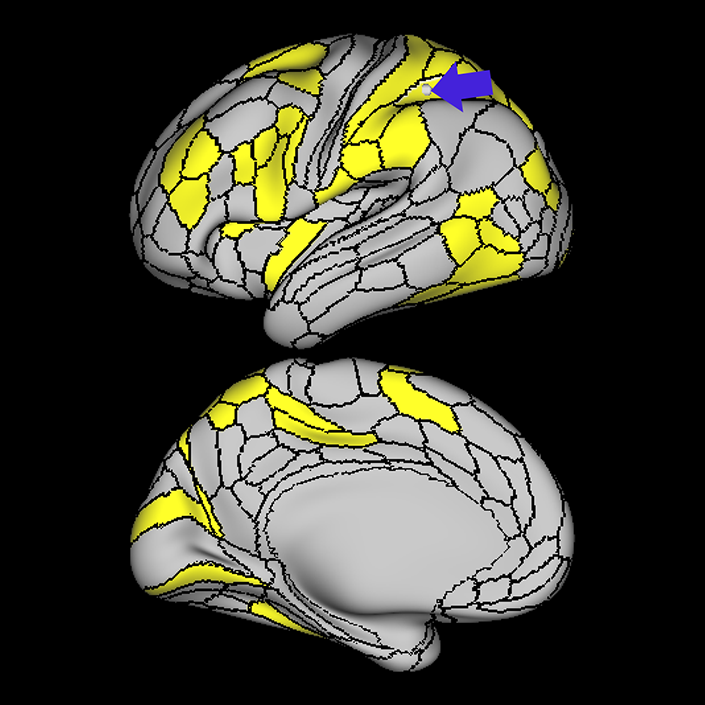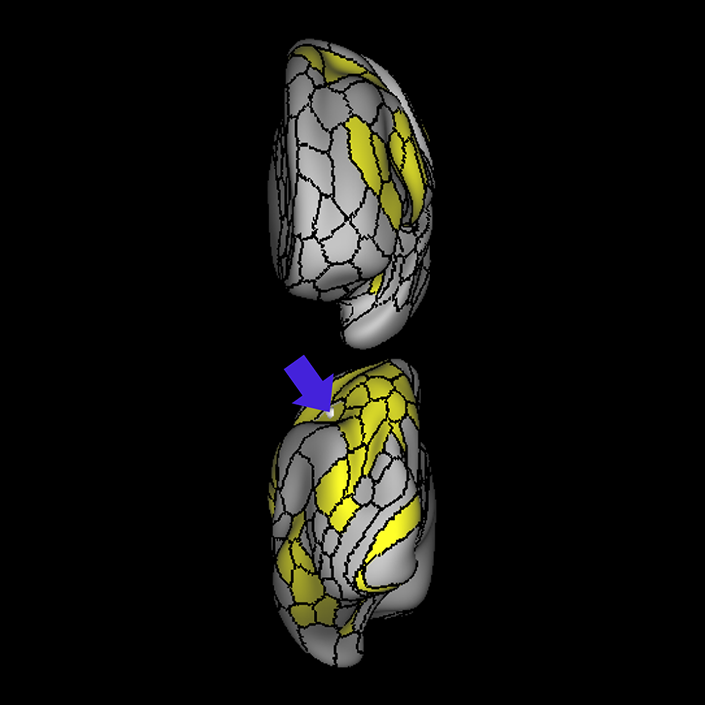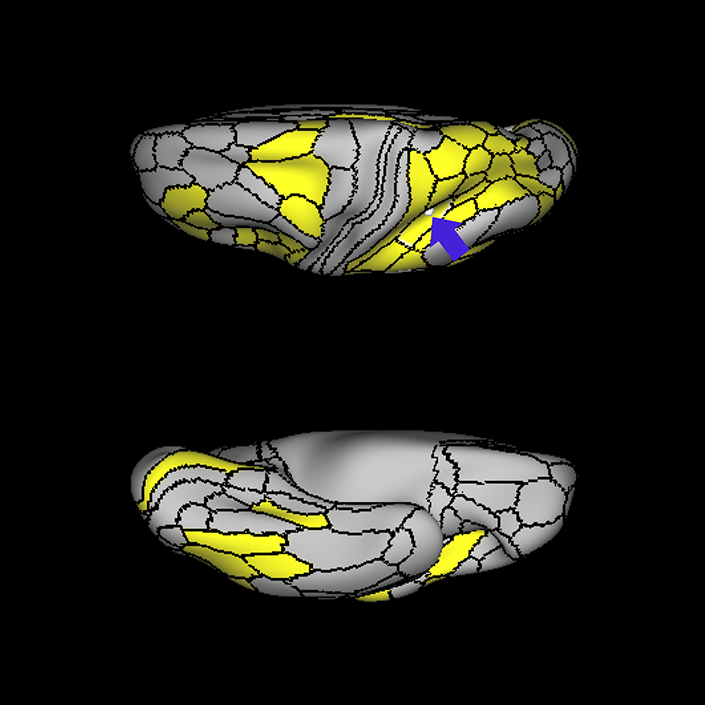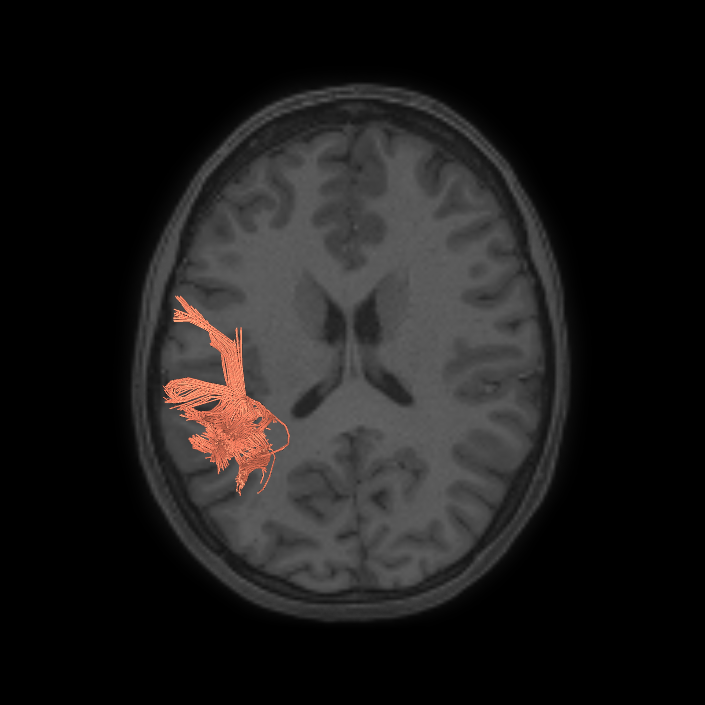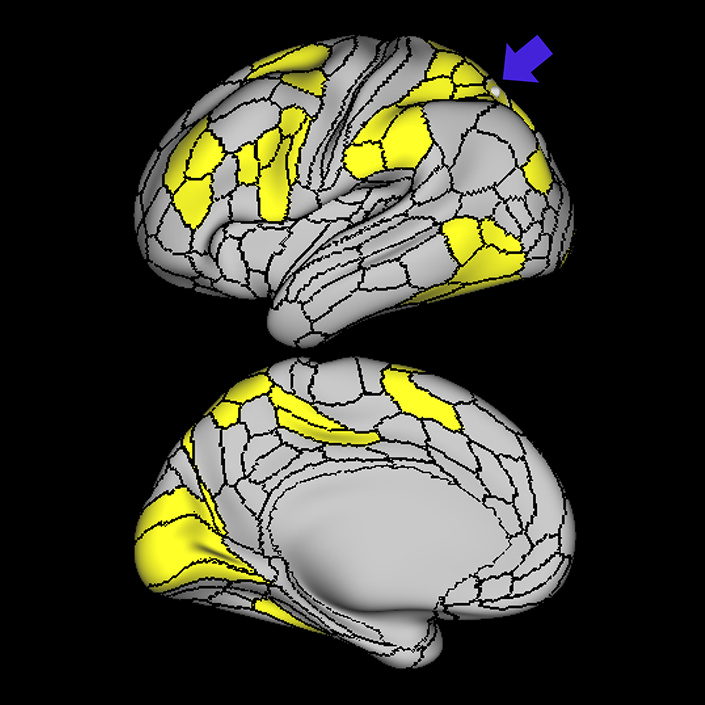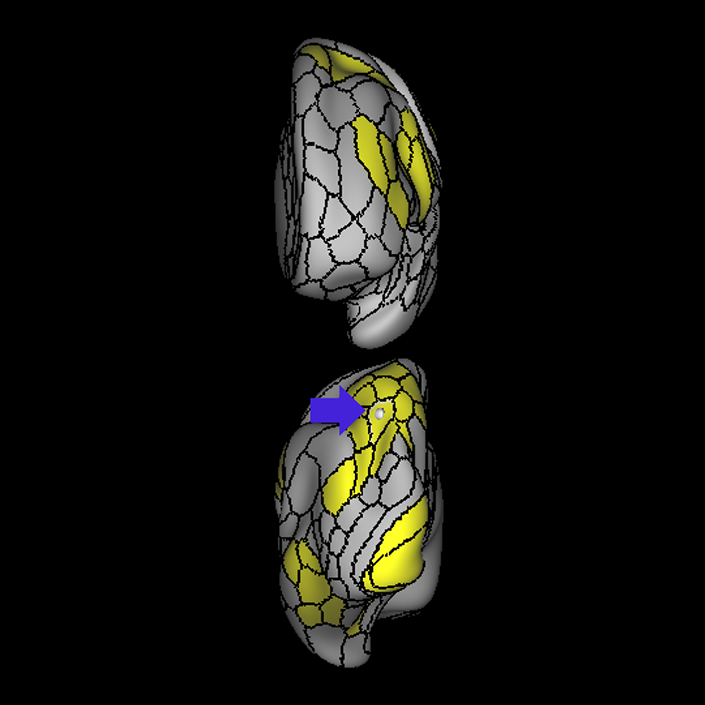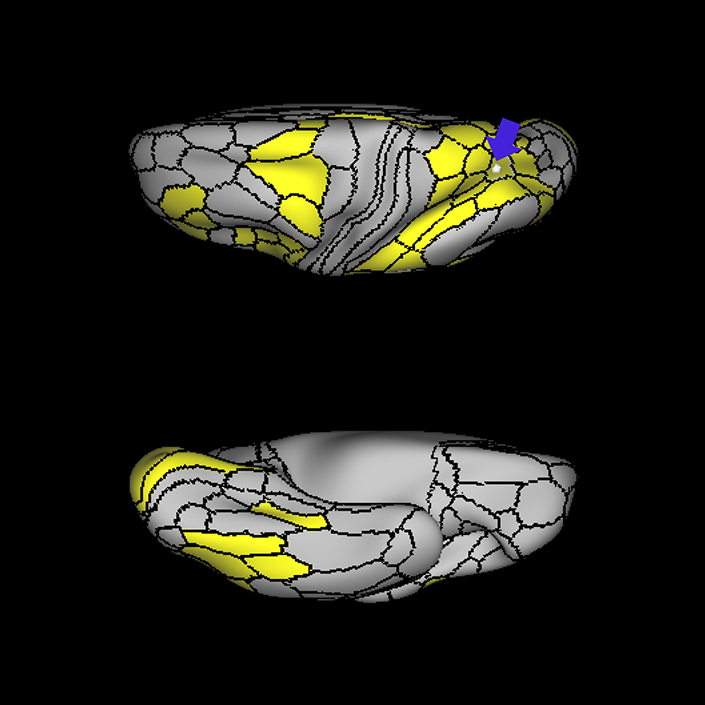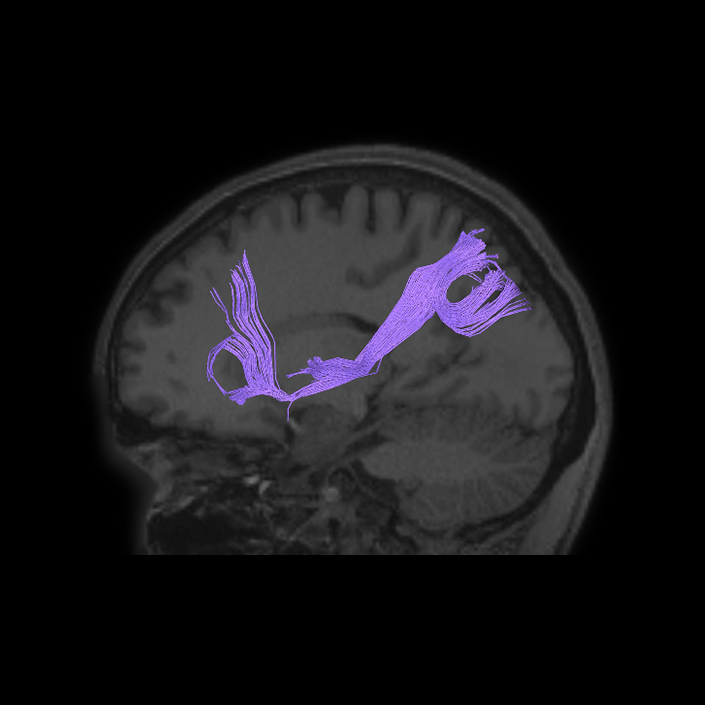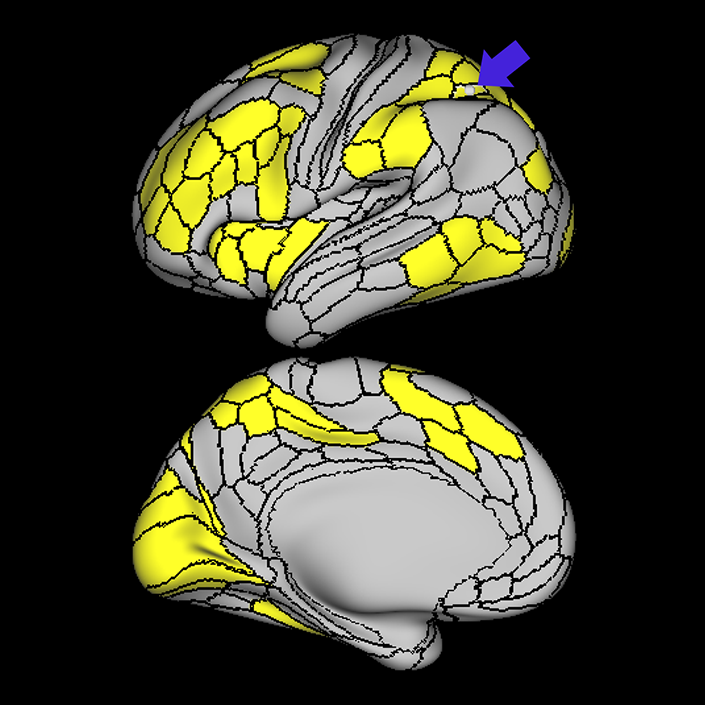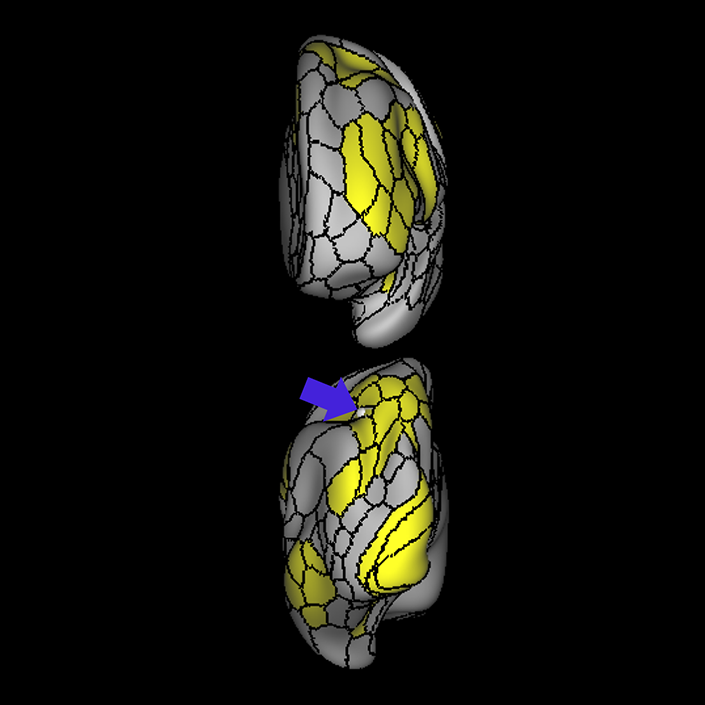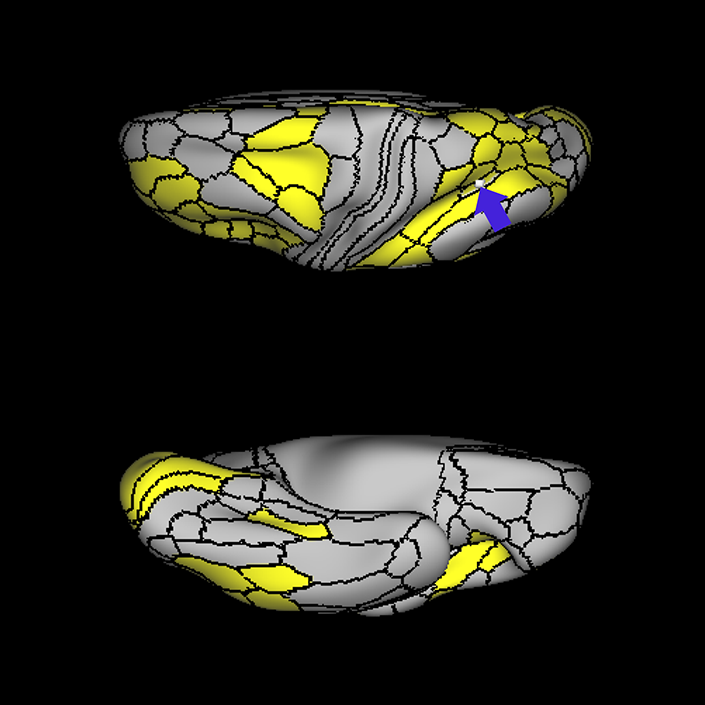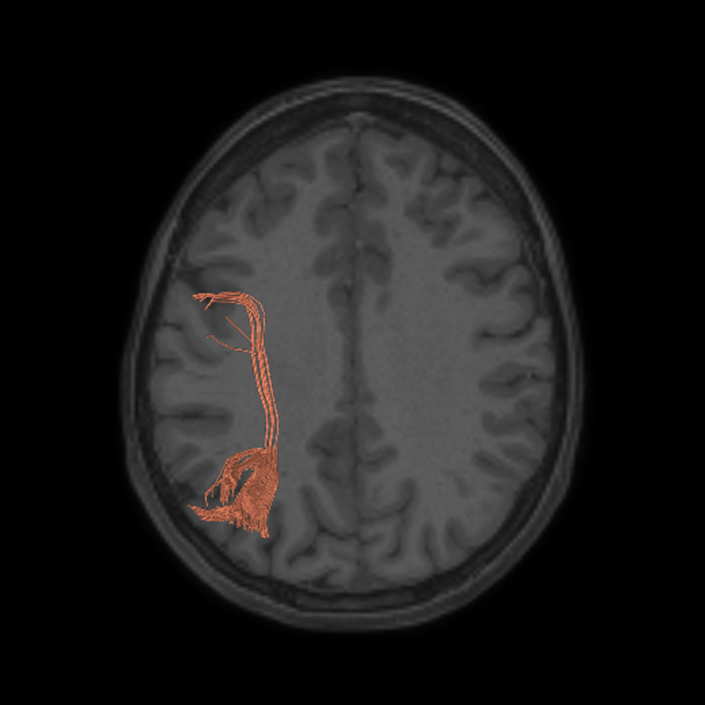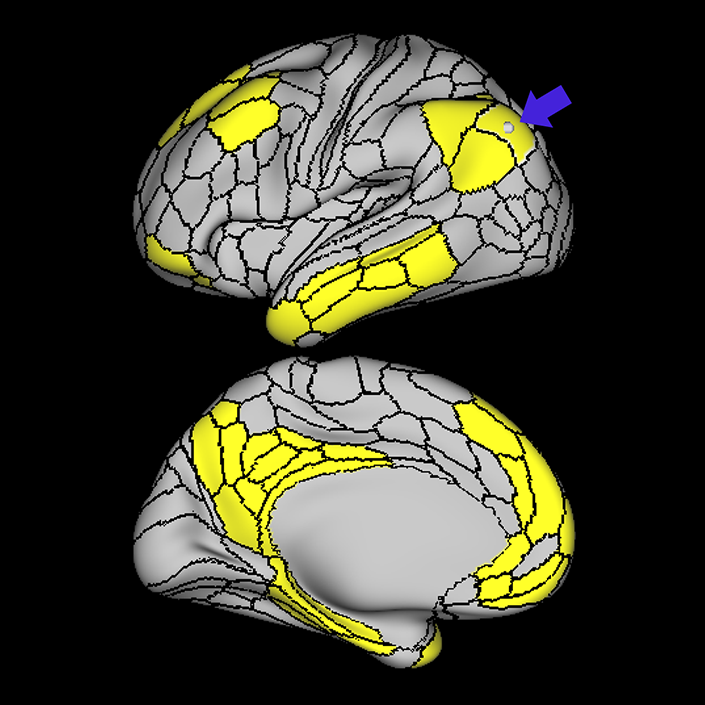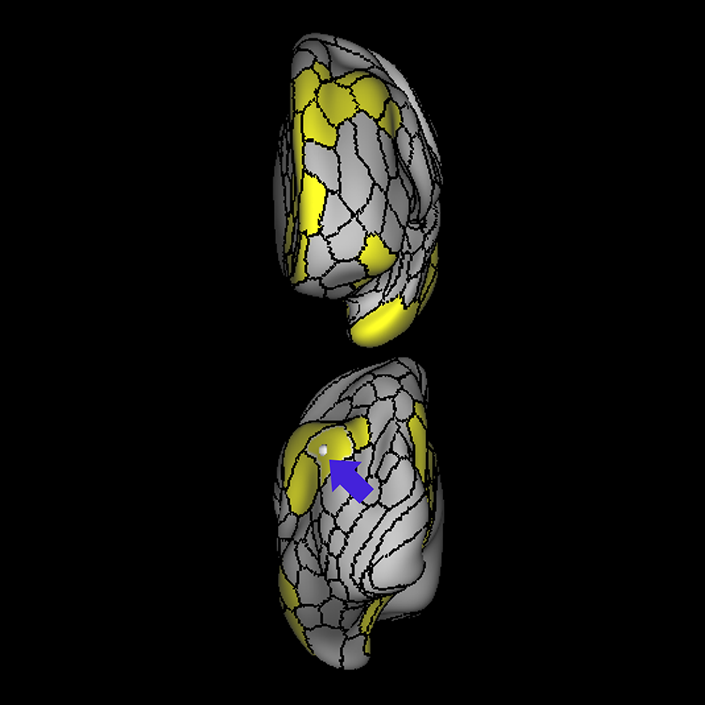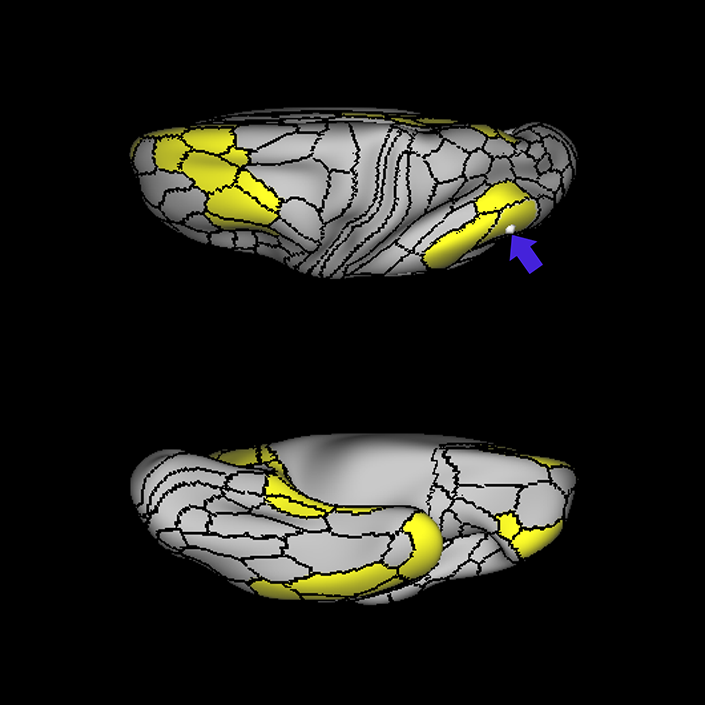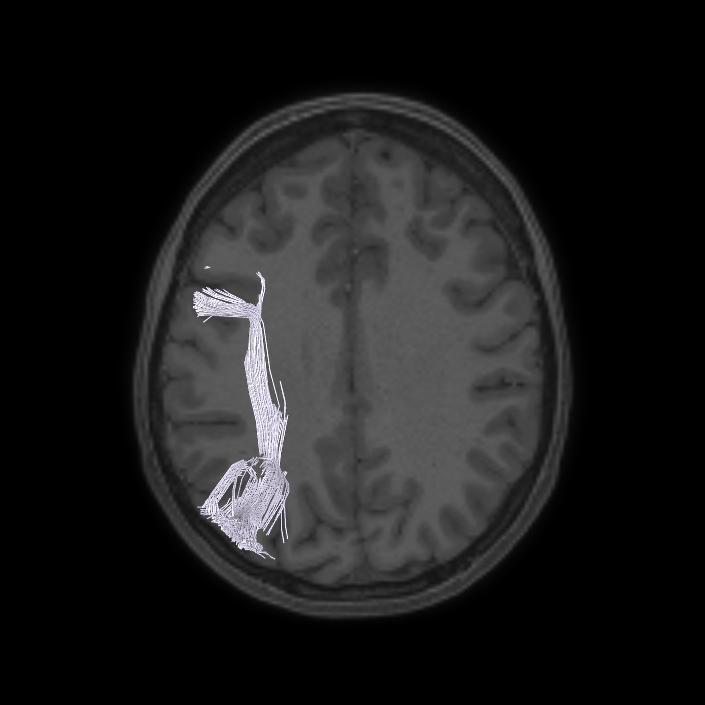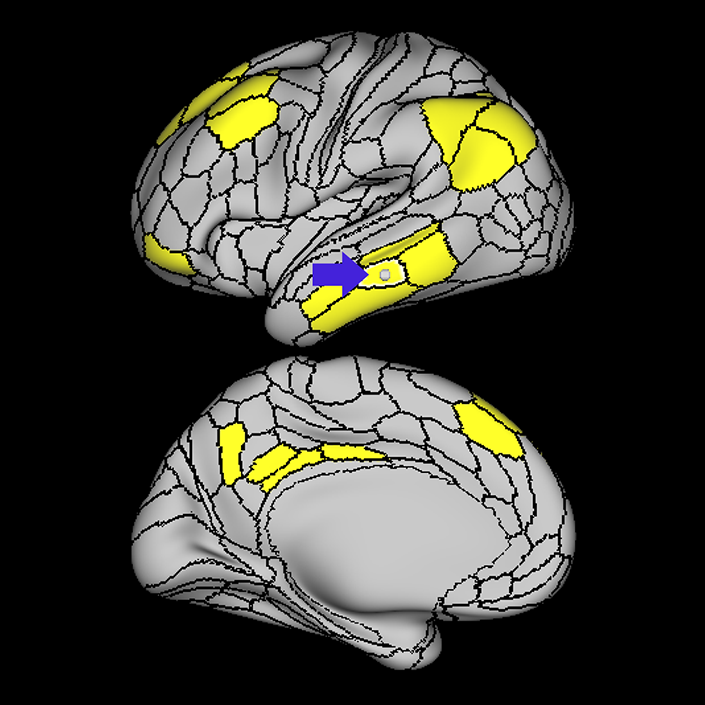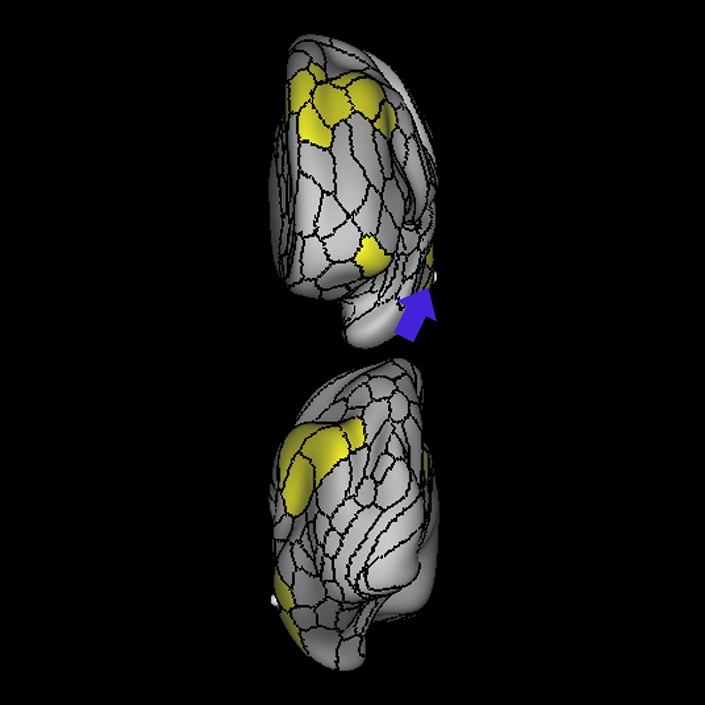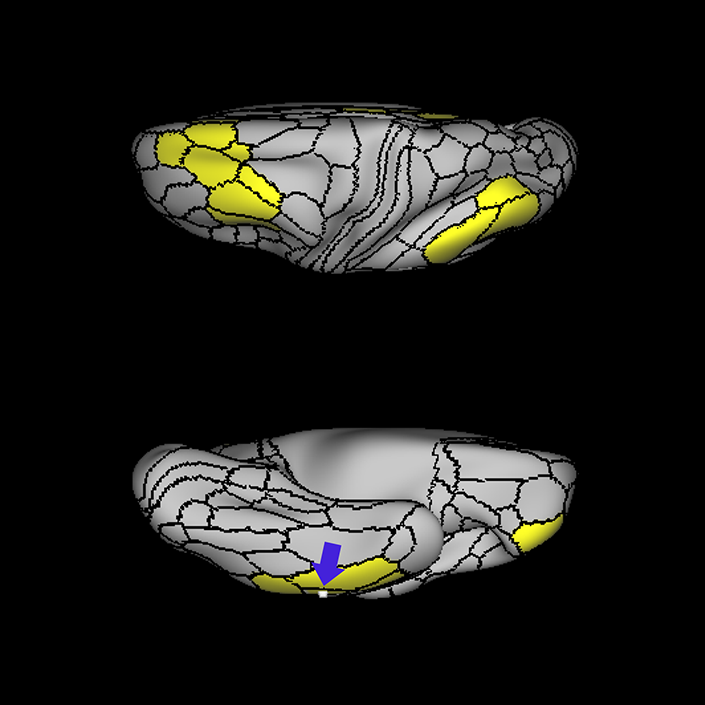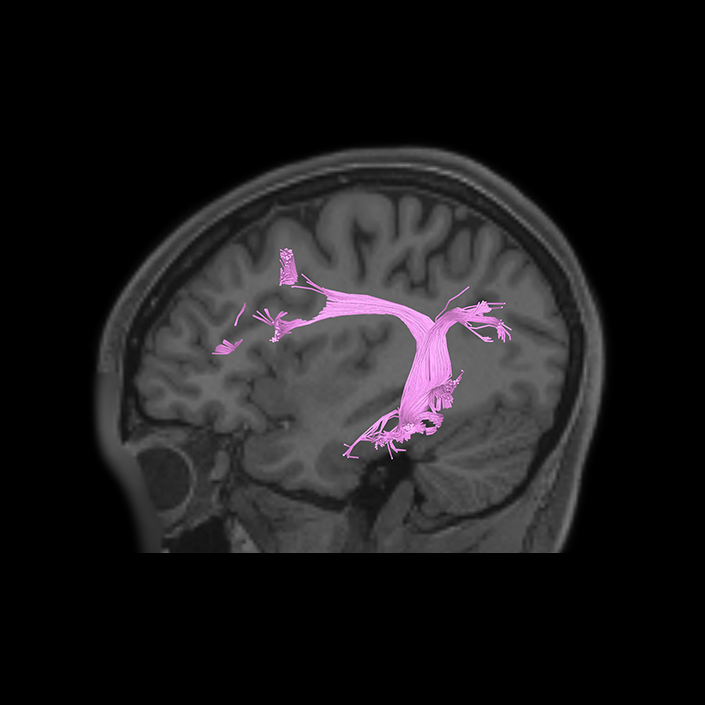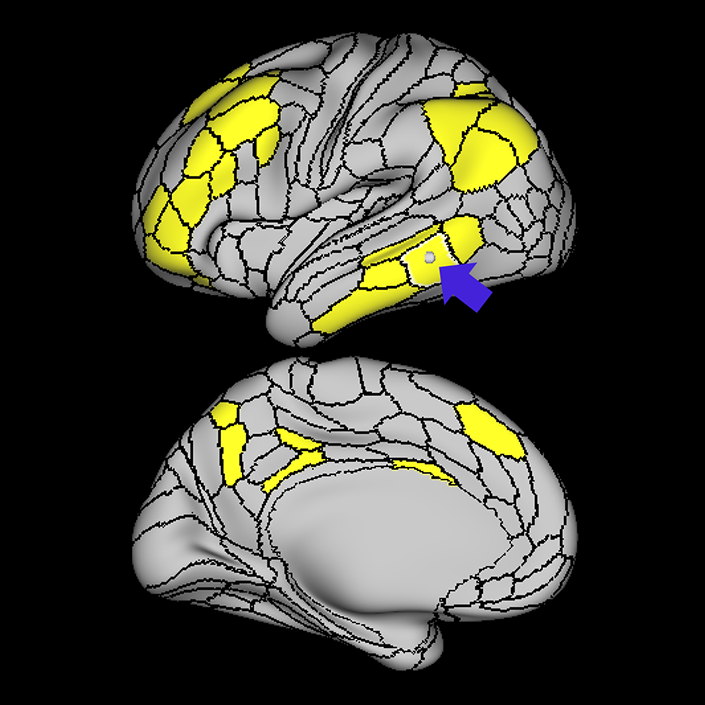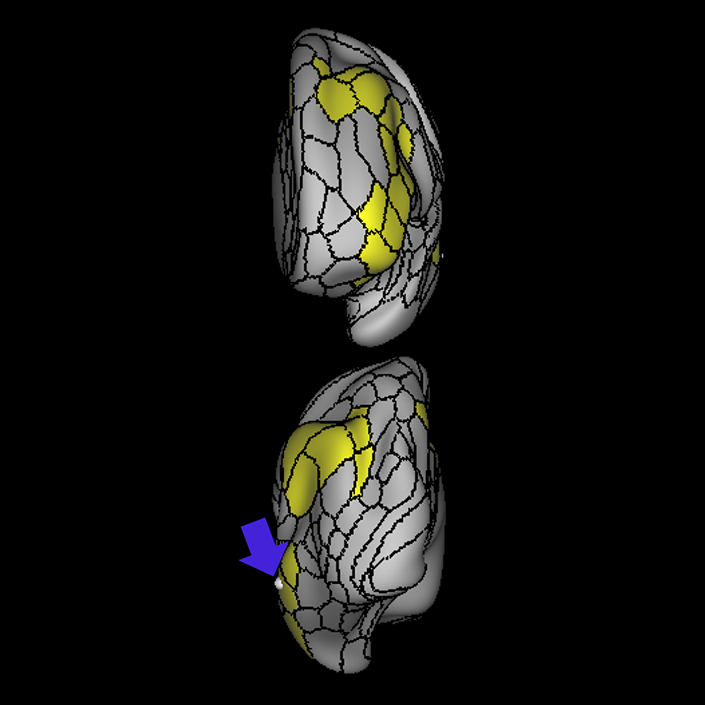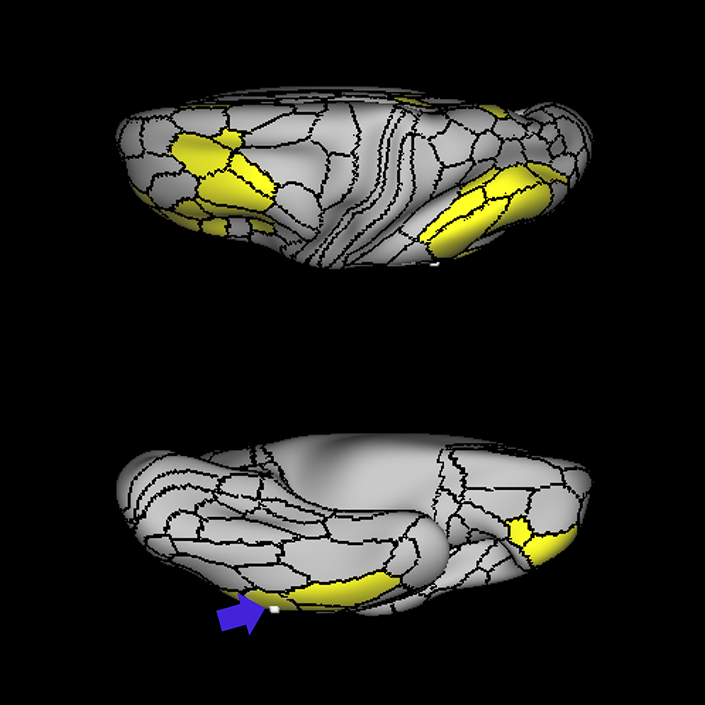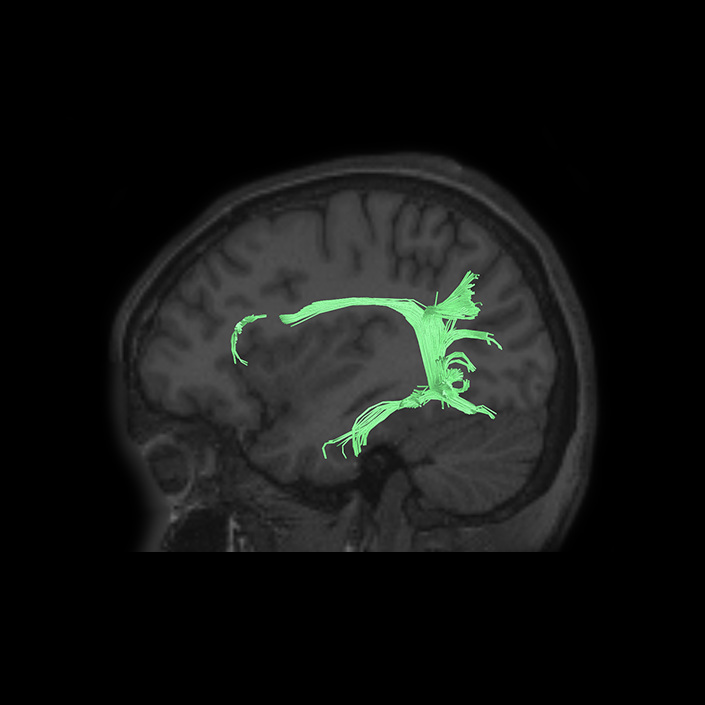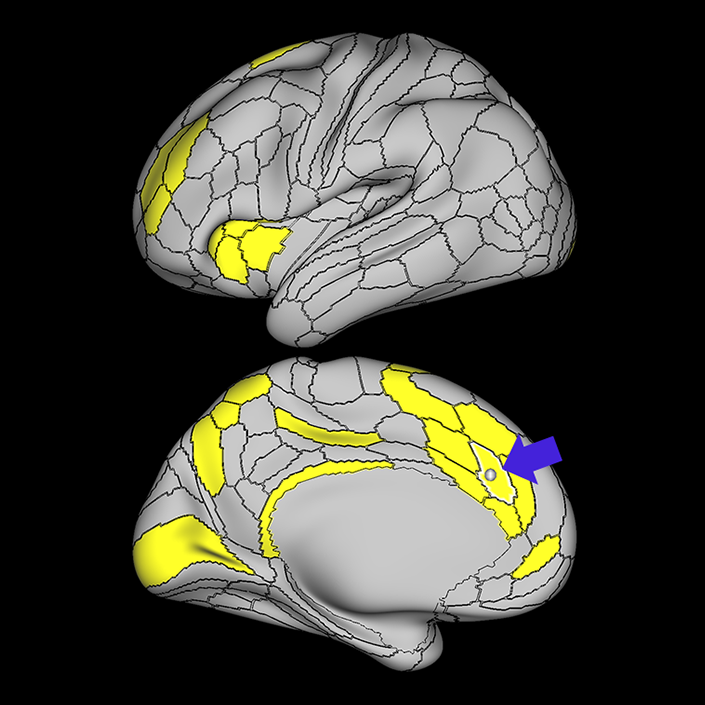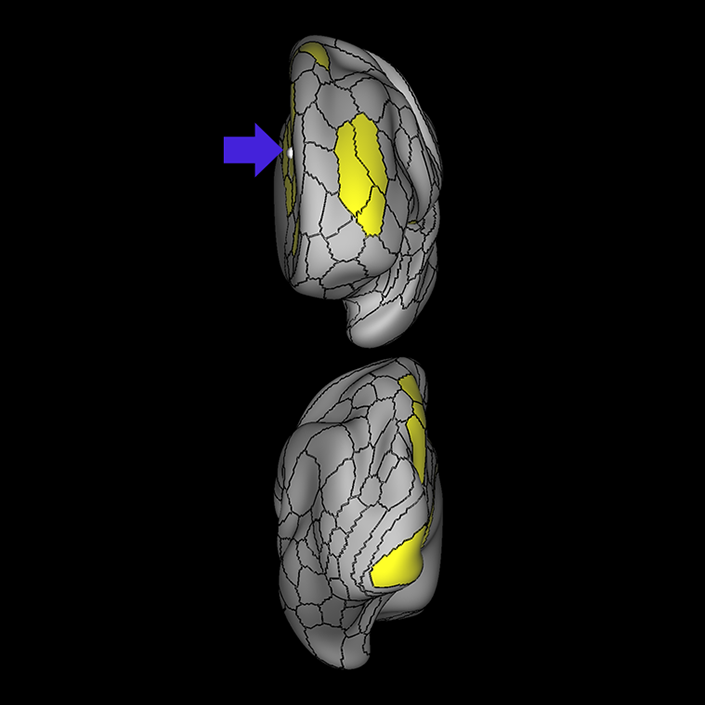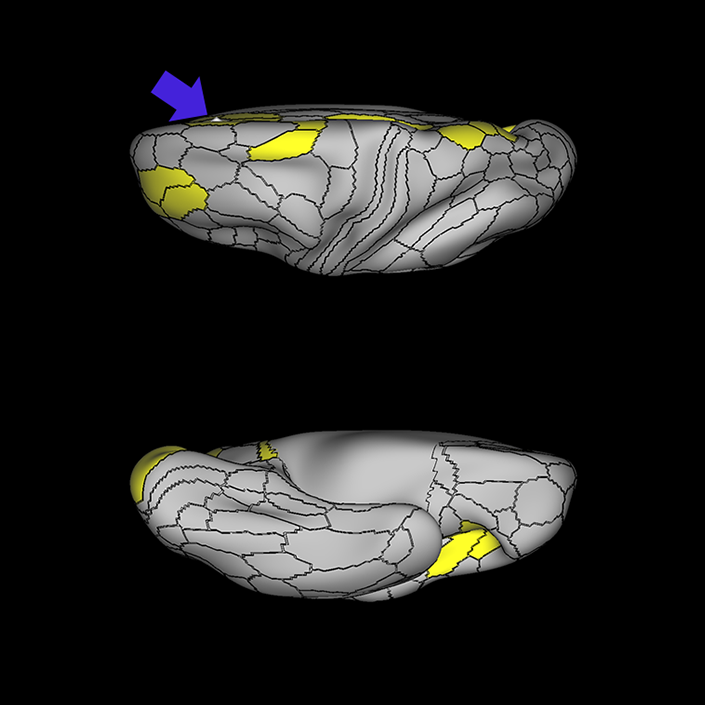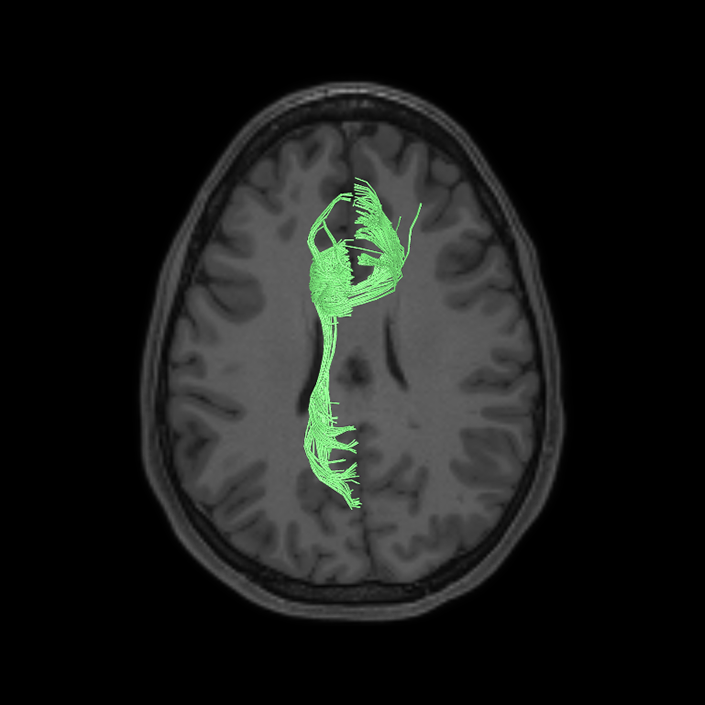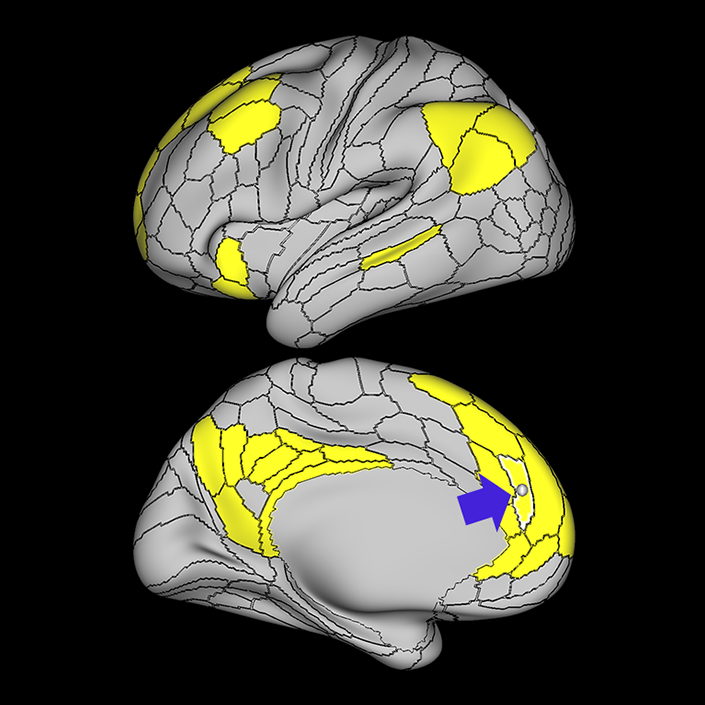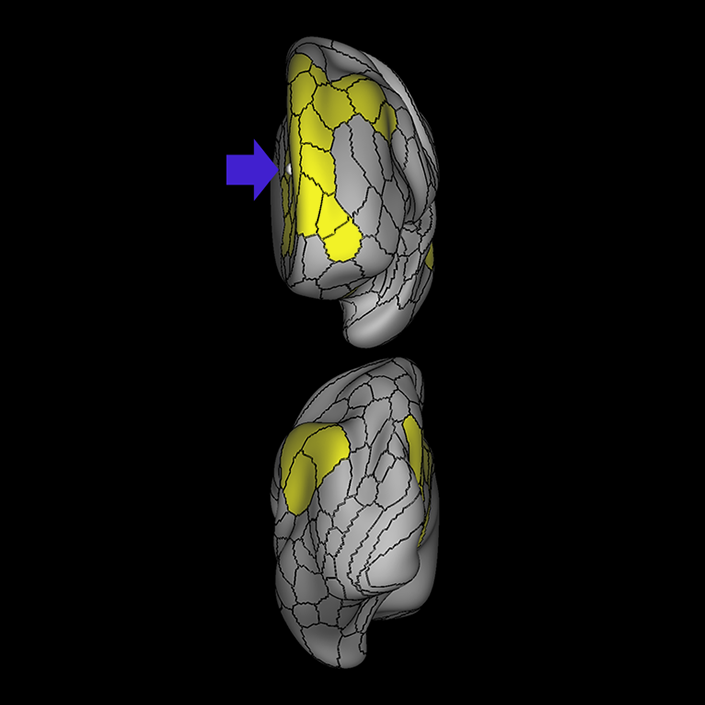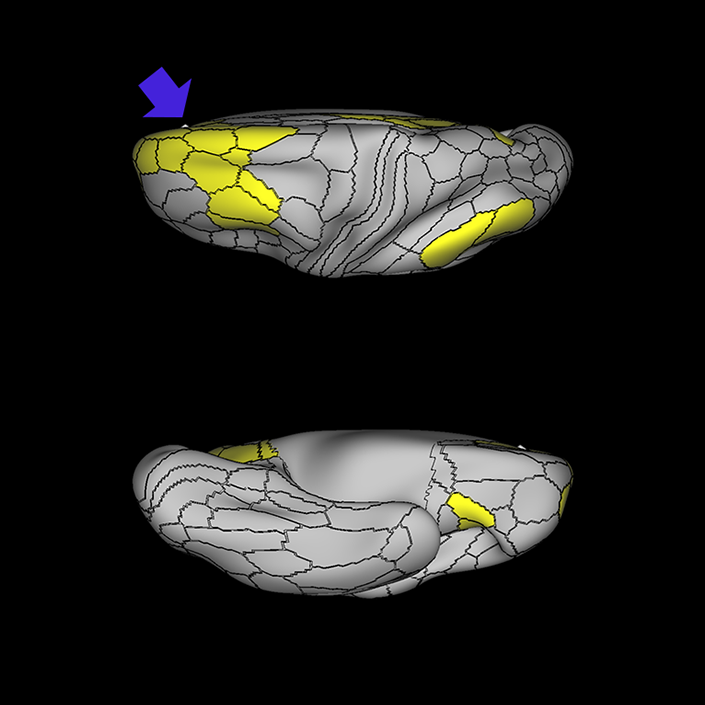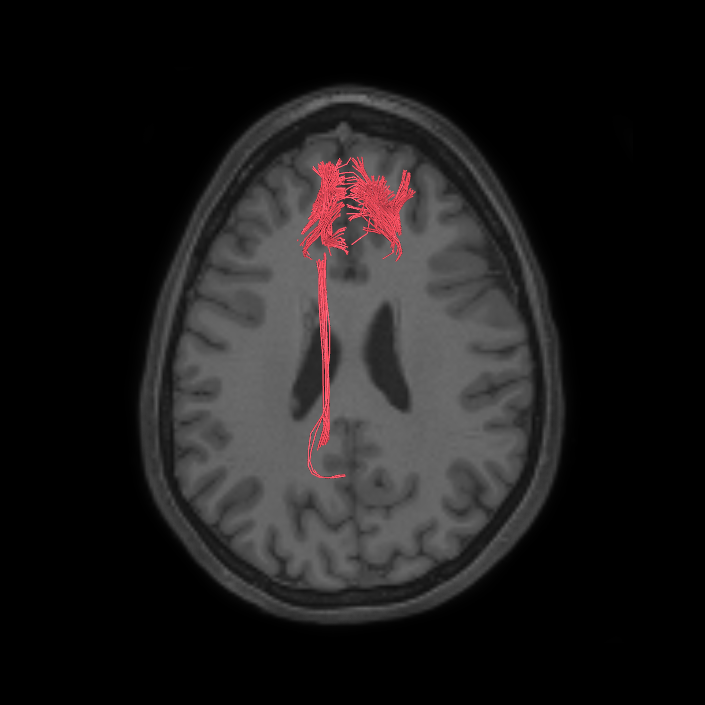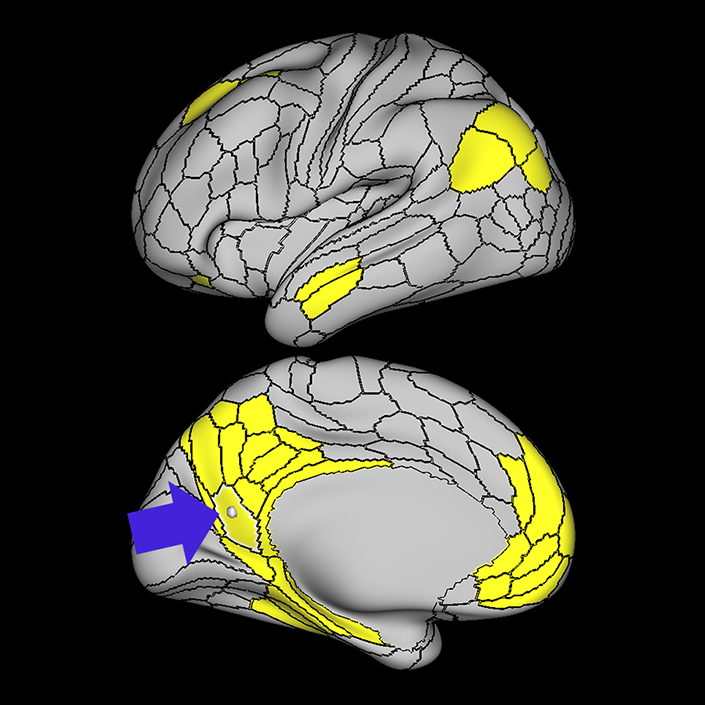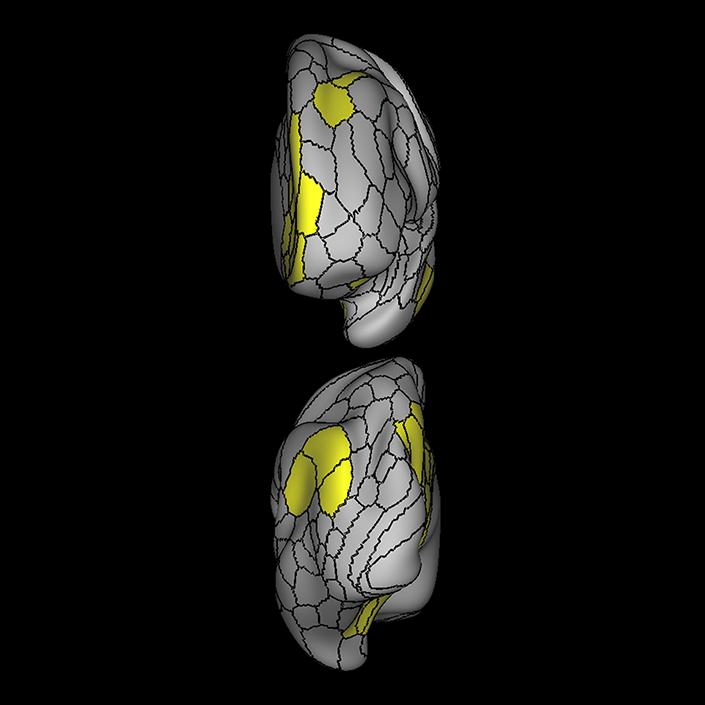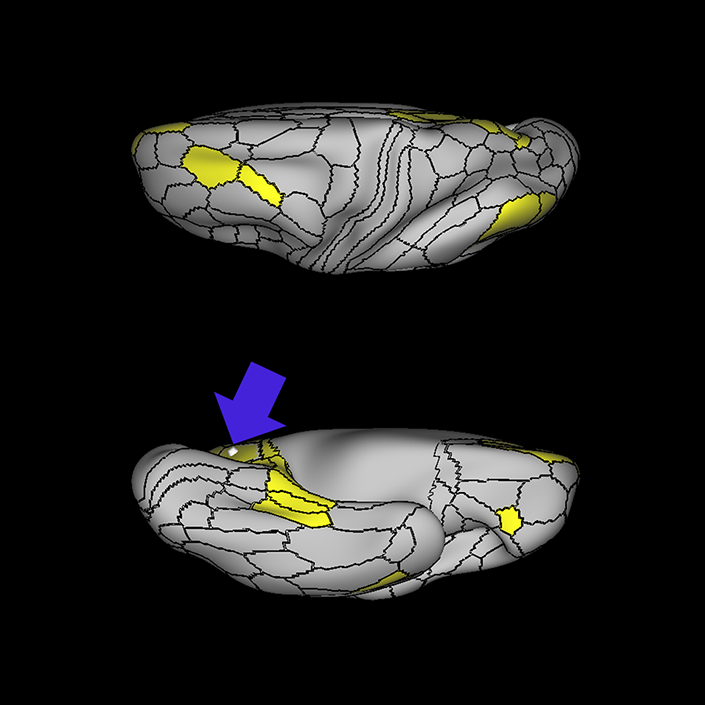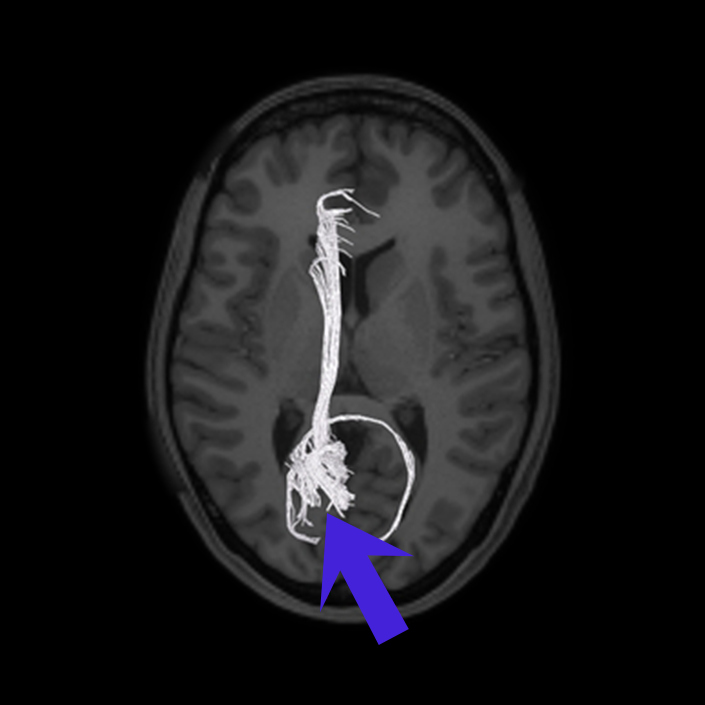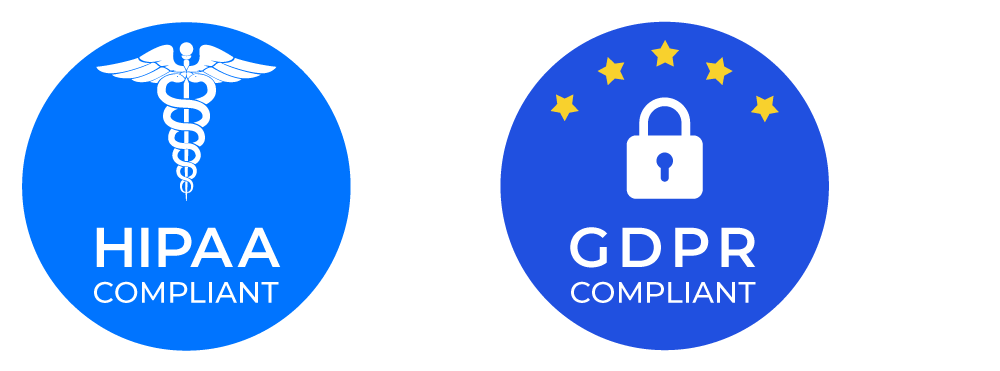ᐅ SummaryArea a9-46v (anterior 9-46 ventral): part of the lateral frontal lobe regions. Like Area 46, plays a role in goal-directed higher- order cognitive processes. The mid- DLPFC, which includes areas 9-46 and 46, is also involved in the conscious, active control of planned behavior. ᐅ Where is it?Area a9-46v (anterior 9-46 ventral) is located at the anterior portior of the middle frontal gyrus. ᐅ What are its borders?Area a9-46v borders area 46 posteriorly, and area 9-46d medially. Its lateral border is mainly with area p47r and a slight contribution with IFSa. Its anterior limit forms a wedge with areas p10p and a47r. ᐅ What are its functional connections?Area a9-46v demonstrates functional connectivity to area 46, 9-46d, p9-46v, a10p, p10p, 6ma, i6-8, a47r, p47r, 8C, and IFSa in the dorsolateral frontal lobe, areas 8BM, and a32prime in the medial frontal lobe, area 11L in the orbitofrontal region, area TE1p in the temporal lobe, area AVI in the insula, areas LIPd, PF, IP1, and IP2 in the parietal lobe, and areas 7pm, 31a, and RSC in the medial parietal lobe . ᐅ What are its white matter connections?Area a9-46v is structurally connected to local parcellations. White matter tracts from this parcellation are highly variable. Short association bundles connect with 8C, 9-46d, 46, IFSa and p47r. ᐅ What is known about its function?Area 9-46d, like Area 46, plays a role in goal-directed higher-order cognitive processes. The mid-dorsolateral prefrontal cortex, which includes areas 9-46 and 46, is also involved in the conscious, active control of planned behavior. |
|
A: lateral-medial
B: anterior-posterior
C: superior-inferior
DTI image |
Connectome Guide
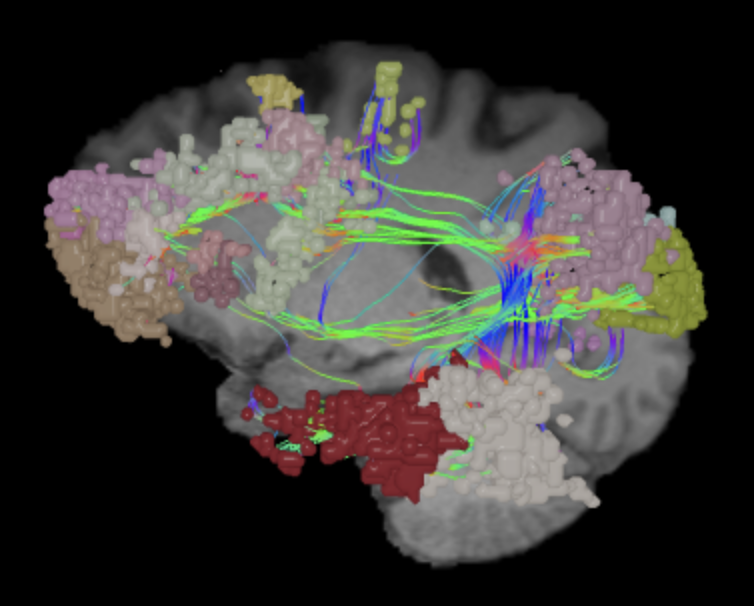
Multiple Demand Extended Network
Why we think these networks are worth considering in decision making:
Damage to the MD network has been shown in several studies to correlate with the degree of decline in higher cognitive function.
Evidence that these networks are responsible for useful function in humans:
Multiple demand network encompasses lateral prefrontal cortex (LPFC) in inferior fontal sulcus (IFS), the anterior insula/frontal operculum (AI/FO), the dorsal anterior cingulate/presupplementary motor area (ACC/pre-SMA), a small region in the anterior frontal cortex (AFC), and the intraparietal sulcus (IPS).1
Lateral studies demonstrated an extended multiple demand network demonstrated including the areas bilateral pre-SMA/MCC, aINS, MFG/IFG for higher cognitive functions.2
These networks are reported to be involved in a variety of cognitive demands including novelty, perceptual difficulty, response conflict and different memory types.
Stimulation of MD with rTMS in healthy participants improve both the accuracy and response times during the first stages of learning pseudoword-object matching whereas a similar improvement was not found for established vocabulary.3
Consequences of damage to this network:
Structural brain damage: Lesions restricted to the components of this network have shown to be predictive of fluid intelligence deficits whereas lesions outside these regions were not predictive even though they are located in the similar parts of the cortex.4 Several behavioral and neuroimaging studies suggested an important role for MD in recovery from aphasia.5 Studies revealed a direct causal relation between MD and novel vocabulary learning. In line with this, post stroke studies show that recovery from language deficits can be predicted by the strength of activity in the MD.6
Mental Illness: Conducting a meta analysis with 5493 patients and 5728 control participants, McTeague et al (2017) identified a common pattern of impaired activity that parallels the MD observed in intact cognition.7 In their study, they included imaging studies investigated different tasks performed by patients with schizophrenia, bipolar or unipolar depression, anxiety disorders and substance use disorders.
ᐅ SummaryArea p9-46v (posterior 9-46 ventral): part of the lateral frontal lobe regions. Like area 46, plays a role in goal-directed higher- order cognitive processes. The mid-DLPFC, which includes areas 9-46 and 46, is also involved in the conscious, active control of planned behavior. ᐅ Where is it?Area p9-46v (posterior 9-46 ventral) is a small triangular shaped region located in the middle frontal gyrus. ᐅ What are its borders?Area p9-46v borders area 8C posteriorly. Its medial border is area 46. Its lateral border is made of IFSp and IFJa. ᐅ What are its functional connections?Area p9-46v demonstrates functional connectivity to area 46, 9-46d, a9-46v a10p, p10p, 6ma, i6-8, a47r, p47r, 8C, IFJp, IFJa, IFSp and IFSa in the dorsolateral frontal lobe, areas 8BM, and 33prime in the medial frontal lobe, areas 6a and 6r in the premotor area, area 11L in the orbitofrontal region, areas TE1p, TE2p, PH, and PHT in the temporal lobe, area AVI in the insula, areas LIPd, AIP, MIP, PFm, 7PL, IP0, IP1, and IP2 in the parietal lobe, area 7pm in the medial parietal lobe, and area V1 in the occipital lobe. ᐅ What are its white matter connections?Area p9-46v is structurally connected to the arcuate/SLF. Connections with the arcuate/SLF project posteriorly and wrap around the sylvian fissure to the inferior temporal gyrus to end at TE2a. Local short association bundles connect with 46, a9-46v, IFJa, IFSa, IFSp, 8C and 9-46d. ᐅ What is known about its function?Area 9-46d, like Area 46, plays a role in goal-directed higher-order cognitive processes. The mid-dorsolateral prefrontal cortex, which includes areas 9-46 and 46, is also involved in the conscious, active control of planned behavior. |
|
A: lateral-medial
B: anterior-posterior
C: superior-inferior
DTI image |
ᐅ SummaryArea 8C: part of the lateral frontal lobe regions. Within the context of spatial working memory, area 8C is involved in the interpretation of complex visual information and attention. Areas 8 and rostral 6, as part of the posterior dorsolateral frontal areas, are also involved in the maintenance of spatial information. ᐅ Where is it?Area 8C is located at the posterior part of the middle frontal gyrus. It is an anterior- to-posterior band which is lateral to area 8AV. ᐅ What are its borders?Area 8C has area 8AV as its main medial border. Its lateral border is with 3 inferior frontal sulcus areas: IFSp, IFJa, and IFJp. Area 55b and PEF (precentral eyefield) are its posterior borders (and discussed in a different section). Area p9-46v and to a lesser extent area 46 are its anterior neighbors. ᐅ What are its functional connections?Area 8C demonstrates functional connectivity to areas s6-8, i6-8, a9-46v, p9-46v, a10p, 8BL, 8AD, and 8AV in the dorsolateral frontal lobe, areas 8BM and d32 in the medial frontal lobe, areas IFSp, IFJp, a47r, p47r, and 44 in the inferior frontal lobe, area AVI in the insula, areas TE1m, TE1p, TE2a, STSva, and STSvp in the temporal lobe, areas IP1, IP2, LIPd, PFm, PGi and PGs in the inferior parietal lobe, and areas 7pm, 31pv, 31a, POS2, 23d, and d23ab in the medial parietal lobe. ᐅ What are its white matter connections?Area 8C is structurally connected to the arcuate/SLF and the contralateral hemisphere. Contralateral connections travel through the corpus callosum to end at 8C. Connections with the arcuate/SLF project posteriorly and wrap around the sylvian fissure to the posterior temporal lobe to end at PH and PHT. ᐅ What is known about its function?Within the context of spatial working memory, area 8C is involved in the interpretation of complex visual information and attention. Areas 8 and rostral 6, as part of the posterior dorsolateral frontal areas, are also involved in the maintenance of spatial information. |
|
A: lateral-medial
B: anterior-posterior
C: superior-inferior
DTI image |
ᐅ SummaryArea IFJa (inferior frontal junction, posterior): part of the lateral frontal lobe. Areas in the midventrolateral prefrontal cortex interact with posterior areas of the brain to retrieve specific auditory memories. The inferior frontal junction, in particular, serves as an important crossroads between bottom-up and top-down processing in the lateral prefrontal cortex. ᐅ Where is it?Area IFJp is at the posterior most part of the inferior frontal sulcus. It is roughly superior to pars opercularis of the IFG. ᐅ What are its borders?Area IFJp borders IFJa anteriorly and the PEF posteriorly. Area 8C is its medial border and its inferior border is wedged between then upper borders of Areas 6R and 6V. ᐅ What are its functional connections?Area IFJp demonstrates functional connectivity to areas p47r, IFSa, IFJa, IFJp, p9-46v, i6-8, and 8C in the dorsolateral frontal lobe, areas 8BM and 33prime in the medial frontal lobe, areas 6r, 6a, and PEF in the premotor areas, areas PH, PHT, TE1p, and TE2p the temporal lobe, areas 7PL, PFt, PF, IP0, IP1, IP2, AIP, MIP and LIPd in the inferior parietal lobe, and area 7PM in the medial parietal lobe. ᐅ What are its white matter connections?Area IFJp is structurally connected with the arcuate/SLF and surrounding parcellations. Connections with the arcuate/SLF project posteriorly and wrap around the Sylvian fissure to the posterior temporal gyrus to end at PHT and FST. There are also connections from the arcuate/SLF to PFm. Local short association bundles connect with 8C, IFJa, IFJp, IFSp, 44, 6r and PEF. ᐅ What is known about its function?Areas in the midventrolateral PFC interact with posterior areas of the brain to retrieve specific auditory memories. The IFJ, in particular, serves as an important crossroads between bottom-up and top-down processing in the lateral prefrontal cortex. |
|
A: lateral-medial
B: anterior-posterior
C: superior-inferior
DTI image |
ᐅ SummaryArea i6-8 (inferior 6-8): part of the lateral frontal lobe. Areas s6-8 and i6-8 represent transitional areas of cortex between Brodmann areas 6 and 8. Areas 8 and rostral 6, as part of the posterior dorsolateral frontal areas, are involved in the maintenance of spatial information. Brodmann area 6 has also been subdivided into areas including the premotor and supplementary motor areas that influence motor control. The premotor area, which encompasses the lateral part of area 6, is further divided into ventral and dorsal portions, named PMv and PMd, respectively. ᐅ Where is it?Area i6-8 (inferior 6-8) is located at the posterior medial MFG near where the SFS joins with the precentral sulcus. ᐅ What are its borders?Area i6-8 borders area 6a medially, and area 55b and FEF laterally. Area 8AV is its lateral border. ᐅ What are its functional connections?Area i6-8 demonstrates functional connectivity to areas s6-8, a9-46v, p9-46v, p10p, 8C, 8AD, and 8AV in the dorsolateral frontal lobe, areas 8BM and d32 in the medial frontal lobe, areas IFSp, IFJp, a47r, p47r, and 44 in the inferior frontal lobe, area 6a in the premotor region, areas TE1m, TE1p, TE2a, PHA2, and PreS the temporal lobe, areas IP0, IP1, IP2, LIPd, PFm, and PGs in the inferior parietal lobe, and areas 7pm, 7m, 31a, POS2, POS1, and d23ab in the medial parietal lob. ᐅ What are its white matter connections?Area i6-8 is structurally connected to surrounding parcellations. White matter tracts from this parcellation are variable. Local short association bundles connect with 8Av, 8Ad, 9-46d, 6a and FEF. ᐅ What is known about its function?Areas s6-8 and i6-8 represent transitional areas of cortex between Brodmann Areas 6 and 8, previously described by Economo and Koskinas. Areas 8 and rostral 6, as part of the posterior dorsolateral frontal areas, are involved in the maintenance of spatial information. Brodmann Area 6 has also been subdivided into areas including the premotor and supplementary motor areas that influence motor control. The premotor area, which encompasses the lateral part of area 6, is further divided into ventral and dorsal portions, named PMv and PMd, respectively. |
|
A: lateral-medial
B: anterior-posterior
C: superior-inferior
DTI image |
ᐅ SummaryArea AVI (anterior ventral insula): part of anterior apex regions. Suggested to have a role in sensation and control of autonomic nervous system processes as well as playing a role in human awareness, self-recognition, time perception, and perceptual decision making. ᐅ Where is it?Area AVI (anterior ventral insula) is located in anterior superior apex of the insula. ᐅ What are its borders?Area AVI borders area 47l anteriorly, areas 47s and AAIC inferiorly, MI posteriorly, and FOP4 and FOP5 superiorly. ᐅ What are its functional connections?Area AVI demonstrates functional connectivity to areas 6ma and 6r in the premotor regions, areas 44, p47r, 8C, a9-46v, p9-46v and 9-46d in the lateral frontal lobe, areas 8BM d32, and a32prime in the medial frontal lobe, areas FOP4, and FOP5 in the superior insula opercular regions, areas AAIC and MI in the lower opercula and Heschl's gyrus regions, areas TE2p, PHA3 and PHT in the temporal lobe, areas LIPd, PF, PFm, and IP2 in the lateral parietal lobe, area V1 in the medial occipital lobe. ᐅ What are its white matter connections?Area AVI is structurally connected to local parcellations. Local short association bundles connect to insular parcellations 47s, 47l, AAIC, FOP4, FOP5, and MI, and temporal pole parcellations TGd. ᐅ What is known about its function?Area AVI is a newly described area of the brain and was parcellated from the anterior insula. The anterior insula is suggested to have a role in sensation and control of autonomic nervous system processes as well as playing a role in human awareness, self-recognition, time perception, and perceptual decision making. Area AVI was parcellated from areas MI and AAIC in the anterior insula based on functional activity differences between regions related to motor, arithmetic, auditory language, and semantic tasks. |
|
A: lateral-medial
B: anterior-posterior
C: superior-inferior
DTI image |
ᐅ SummaryArea IP1 (intraparietal 1): part of the lateral parietal lobe regions. Shows significant activation during mental arithmetic activities. Supports more complex parts of numeric and mathematical information processing. Shows greater activation in primary contrasts, when interpreting motor cues and when hearing a story compared to when hearing arithmetic problems. More active when individuals are processing faces than when processing shapes, and is less deactivated when hearing a story vs unrelated words. ᐅ Where is it?Area IP1 (Intraparietal 1) is found on the middle portion of the inferior bank of the intraparietal sulcus. ᐅ What are its borders?Area IP1 borders IP2 anteriorly and IP0 posteriorly. Its inferior border is formed by PFm and PGs, and its superior border is MIP and LIPv. ᐅ What are its functional connections?Area IP1 demonstrates functional connectivity to area 6a in the premotor regions, areas 33prime and 8BM in the middle cingulate regions, areas IFSa, IFSp, IFJp, a9-46v, p9-46v, 8AV, 8C, i6-8, a47r, and p47r in the lateral frontal lobe, areas TE1m, TE1p, PHT, and PreS in the temporal lobe, areas TE1p and PHT in the temporal lobe, areas PFm, PGs, IP0, IP2, AIP, MIP, and LIPd in the lateral parietal lobe, areas 7pm, 31a, d23ab, POS2, and RSC in the medial parietal lobe, and area V1 in the occipital lobe. ᐅ What are its white matter connections?Area IP1 is structurally connected with the superior longitudinal fasciculus (SLF). Connections with the SLF project anteriorly to the premotor cortex to end at 55b, FEF and PEF. Local short association fibers connect with PFm, LIPd, IP0, IPS1and PGs. White matter tracts in the right hemisphere have more inferior connections with the inferior frontal gyrus. ᐅ What is known about its function?Area IP1 shows significant activation during mental arithmetic activities, and, as part of the anterior IPS, supports more complex parts of numeric and mathematical information processing. Area IP1 shows greater activation in primary contrasts, when interpreting motor cues and when hearing a story compared to when hearing arithmetic problems. Relative to area IP2, area IP1 is more active when individuals are processing faces than when processing shapes, and is less deactivated when hearing a story versus unrelated words. |
|
A: lateral-medial
B: anterior-posterior
C: superior-inferior
DTI image |
ᐅ SummaryArea 1P2 (intraparietal 2): part of the lateral parietal lobe regions. Shows significant activation during mental arithmetic activities. Appear to support more complex parts of numeric and mathematical information processing. Involved in the modulatory sensorimotor integration processes related to fine finger movements. ᐅ Where is it?Area IP2 (Intraparietal 2) is found on the anterior most portion of the inferior bank of the intraparietal sulcus. ᐅ What are its borders?IP2 borders PF anteriorly, PFm inferiorly, IP1 posteriorly, and areas AIP and LIPv superiorly. ᐅ What are its functional connections?Area IP2 demonstrates functional connectivity to areas 6ma, 6a, and 6r in the premotor regions, areas 33prime and 8BM in the middle cingulate regions, areas IFSa, IFJp, a9-46v, p9-46v, 46, 11L, 8C, i6-8, a47r, and p47r in the lateral frontal lobe, areas AVI in the insula regions, area PHT in the temporal lobe, areas TE1p and PHT in the temporal lobe, areas PFt, PF, PFm, PGp, IP0, IP1, AIP, MIP, LIPd, and 7PL in the lateral parietal lobe, areas 7AM, 7pm, 31a, POS2, and RSC in the medial parietal lobe, and area PH in the occipital lobe. ᐅ What are its white matter connections?Area IP2 is structurally connected with the superior longitudinal fasciculus (SLF). Connections with the SLF project anteriorly to the premotor cortex to end at 55b and PEF. Local short association fibers connect with PFm, LIPd, AIP and IP1. White matter tracts in the right hemisphere have more inferior connections with the inferior frontal gyrus. ᐅ What is known about its function?Area IP2 shows significant activation during mental arithmeti activities. Anterior IPS areas appear to support more complex parts of numeric and mathematical information processing. The anterolateral bank of the IPS is involved in the modulatory sensorimotor integration processes related to fine finger movements. |
|
A: lateral-medial
B: anterior-posterior
C: superior-inferior
DTI image |
ᐅ SummaryArea PFm (parietal area F, part m): part of the lateral parietal lobe regions. Shows activation in nonspatial attention tasks, decision making when switching choices, rule change during visually guided attention, and reorientation. Also provide syntactical components to language processing, plays a role in attentional processing, and is activated in working memory, motor cue, and risk-related tasks. ᐅ Where is it?Area PFm (parietal area F, part m) is found on the anterior superior surface of the angular gyrus, and straddles the sulcus to lie on the posterior superior bank of the supramarginal gyrus. ᐅ What are its borders?Area PFm borders IP2 and IP1 superiorly, PF anteriorly, PSL and STV inferiorly, and PGI and PGS posteriorly. ᐅ What are its functional connections?Area PFm demonstrates functional connectivity to areas 8AV, 8AD, 8BL, 8C, s6-8, i6-8, a47r, p47r, a10p, p10p, 9a, a9-46v, p9-46v, and area 44 in the lateral frontal lobe, area d32 in the medial frontal lobe, area AVI in the insula, areas STSvp, TE1m, TE1p, and TE2a, in the temporal lobe, areas PGs, PGi, IP2, and IP1 in the lateral parietal lobe, and areas 7m, 7pm, POS2, 31a, 31pv, d23ab, 23d and RSC in the medial parietal lobe. ᐅ What are its white matter connections?Area PFm is structurally connected to the arcuate/SLF. Arcuate/SLF connections course anteriorly from PFm to 8C and 8BM, and inferiorly to middle temporal gyrus parcellations TE1a, TE1m, TE1p, STSva, STSvp and PHT. Local short association bundles connect with AIP, 7PC, IP1, IP2, LIPd, LIPv, PGi, PGs, 2 and 1 ᐅ What is known about its function?PFm shows activation in non-spatial attention tasks, decision making when switching choices, rule change during visually-guided attention, and reorientation. Intermediate regions of the inferior parietal lobule also provide syntactical components to language processing. This area also plays a role in attentional processing, and is activated in working memory, motor cue, and risk-related tasks. |
|
A: lateral-medial
B: anterior-posterior
C: superior-inferior
DTI image |
ᐅ SummaryArea 8BM (8B medial): part of medial superior frontal gyrus regions. Involved in maintaining visuospatial information as well as coordinating and coding visuospatial information in terms of oculomotor and other body-centered coordinate systems. ᐅ Where is it?Area 8BM (8B medial) is located in the posterior medial SFG. ᐅ What are its borders?Area 8BM borders area 9m anteriorly and SCEF posteriorly. It borders the following area 24 subdivisions superiorly: a24pr, p24pr, and p24. Its inferior border contains areas d32 and a32pr, and its superior boundary includes 8BL and SFL. ᐅ What are its functional connections?Area 8BM demonstrates functional connectivity to areas i6-8, s6-8, a10p, a9-46v, p9-46v, 8C, 8BL, 8AD, and 8AV in the dorsolateral frontal lobe, areas SFL, a32prime and d32 in the medial frontal lobe, areas IFSa, IFSp, IFJp, 44, 45, a47r, and p47r in the inferior frontal lobe, area 55b in the premotor areas, area AVI in the insula, areas TE1m, TE1p, and STSvp in the temporal lobe, areas LIPv, IP1, IP2, PFm, PGi and PGs in the lateral parietal lobe, and areas 7pm, 31a, and d23ab in the medial parietal lobe . ᐅ What are its white matter connections?Area 8BM is connected to the contralateral hemisphere, frontal aslant tract, inferior front-occipital fasciculus and thalamus. Contralateral connections course through the corpus callosum to end at 8BM and 9m. Frontal aslant tract fibers from 8BM project inferolaterally to end at 44. Thalamic connections run inferior to 8BM and continue in the brainstem. Fibers with the inferior fronto-occipital fasciculus project inferior and posterior through the extreme/external capsule through the temporal lobe to end at parietal and occipital connections 7PC, V1, V2 and V3. Local short association bundles connect with 9m, d32 and SCEF. ᐅ What is known about its function?Area 8Bm is involved in maintaining visuospatial information as well as coordinating and coding visuospatial information in terms of oculomotor and other body-centered coordinate systems. |
|
A: lateral-medial
B: anterior-posterior
C: superior-inferior
DTI image |
ᐅ SummaryArea SCEF (supplementary and cingulate eye field): part of medial superior frontal gyrus regions. Higher order oculomotor center implicated in appraising all possible oculomotor behaviors to direct primary oculomotor centers in goal- directed behavior. ᐅ Where is it?Area SCEF (supplementary and cingulate eye field) is located in the posterior medial SFG. ᐅ What are its borders?Area SCEF borders area 8BM anteriorly, areas 6ma and SFL superiorly, areas 6mp and 24dd posteriorly, and areas 24dv and p32pr inferiorly. ᐅ What are its functional connections?Area SCEF demonstrates functional connectivity to areas 1, 2, 3a, 3b in the sensory strip, area 4 in the motor strip, areas PEF, FEF, 55b, 6ma, 6mp, 6a, 6r, and 6v in the premotor regions, areas a24prime, p32prime, a32prime, 5mv, and 23c in the middle cingulate regions, areas IFJa, 46, and 9-46d in the lateral frontal lobe areas OP4, OP1, PFcm, 43, FOP1, FOP2, FOP3 FOP4, and FOP5 in the superior insula opercular regions, areas PSL, 52, A4, MI, PoI1 and PoI2 in the lower opercula and Heschl's gyrus regions, area PHT in the temporal lobe, areas AIP, MIP, VIP, LIPd, LIPv, PFop, PF, PFt, IP0, IPS1, 7AL, 7PL, and 7PC, in the lateral parietal lobe, areas 7am and DVT in the medial parietal lobe, area V1, V2, V3, V4 in the medial occipital lobe, areas V3a, V3b, V6, V6a, and V7 in the dorsal visual stream, area FFC of the ventral visual stream, and areas PH, TPOJ2, LO3, MST, and FST of the lateral occipital lobe. ᐅ What are its white matter connections?Area SCEF is structurally connected to the contralateral hemisphere and thalamus. Contralateral connections course through the body of the corpus callosum to end at SCEF, 8BL, SFL and 8BM. Thalamic projections travel through the ventral thalamus to the brainstem (Figure 32). Local short association bundles connect with SF, 8BM, SFL and 8BL. ᐅ What is known about its function?Area SCEF is a higher order oculomotor center implicated in appraising all possible oculomotor behaviors to direct primary oculomotor centers in goal-directed behavior. |
|
A: lateral-medial
B: anterior-posterior
C: superior-inferior
DTI image |
ᐅ SummaryArea 11: part of the the orbitofrontal regions. Research indicates its primary function is to receive, integrate, and modulate olfactory information to evaluate food-related reinforcers and analyze satiety and anticipation of food rewards. ᐅ Where is it?Area 11l is located in the anterior orbitofrontal cortex. ᐅ What are its borders?Area 11l borders area a10p anteriorly, area a47r laterally, areas 13l and 47m posteriorly, and OFC medially. ᐅ What are its functional connections?Area 11l demonstrates functional connectivity to areas 46, a9-46v, p9-46v and IFSa in the frontal lobe and IP2 in the parietal lobe. ᐅ What are its white matter connections?Area 11l is structurally connected to the occipital lobe through the inferior fronto-occipital fasciculus. In some individuals 11l also connects with the uncinate fasciculus but this tract is inconsistent. Inferior fronto-occipital fasciculus fibers project through the extreme/external to end at occipital lobe area V1. ᐅ What is known about its function?Research on area 11l indicates its primary function is to receive, integrate, and modulate olfactory information to evaluate food-related reinforcers and analyze satiety and anticipation of food rewards. |
|
A: lateral-medial
B: anterior-posterior
C: superior-inferior
DTI image |
ᐅ SummaryArea a10p (anterior 10 polar): part of the lateral frontal lobe regions. involved in episodic and working memory tasks. Brodmann area 10 more generally is activated in relation to increasing complexity of working memory tasks. This area also plays a role in abstract cognitive function. ᐅ Where is it?Area a10p (anterior 10 polar) is located at the fusiform junction of the anterior most aspects of the superior and middle frontal gyri. ᐅ What are its borders?Area a10p borders area 11r on its inferior (orbitofrontal) boundary, and area p10p on its superior boundary. Areas a47r and p47r are its lateral neighbors, and area 10pp is its medial neighbor. ᐅ What are its functional connections?Area a10p demonstrates functional connectivity to areas p10p, a9-46v, 8BM and 8C in the dorsolateral frontal lobe, d32 in the anterior cingulate region, area PFm in the lateral parietal lobe, and POS2 and 7pm in the medial parietal lobe. ᐅ What are its white matter connections?Area a10p is structurally connected to the IFOF and contralateral hemisphere. Contralateral connections travel through the genu of the corpus callosum with the forceps minor to end at 9a and p10p. IFOF connections travel from a10p through the extreme/external capsule and continue posteriorly to end at occipital lobe parcellations V1, V2, V3, V6 and V6a. Local short association bundles are connected to 10d, 10pp, p10p, a9-46v and 9-46d. ᐅ What is known about its function?Area a10p is involved in episodic and working memory tasks. Brodmann area 10 more generally is activated in relation to increasing complexity of working memory tasks. This area also plays a role in abstract cognitive function. |
|
A: lateral-medial
B: anterior-posterior
C: superior-inferior
DTI image |
ᐅ SummaryArea p10p (posterior 10 polar): part of the lateral frontal lobe regions. Involved in episodic and working memory tasks. Brodmann area 10 more generally is activated in relation to increasing complexity of working memory tasks. This area also plays a role in abstract cognitive function. ᐅ Where is it?Area p10p (posterior 10 polar) is located on the lateral bank of the anterior aspect of the superior frontal gyrus, just posterior to a10p. It straddles the anterior most point of the superior frontal sulcus which terminates here. ᐅ What are its borders?Area p10p borders area a10p on its anterior boundary, and area a9-46d and a small part of area 9a on its superior boundary. Area 9-46d is also its lateral neighbor. It is slightly triangular shaped and its superior apex is wedged between area 9a and area 9-46d. ᐅ What are its functional connections?Area p10p demonstrates functional connectivity to a10p and a9-46v in the anterior frontal lobe, d32 in the anterior cingulate region, i6-8 in the posterior frontal lobe, areas 31a, 31pv, d23ab, POS2, RSC, and 7pm in the posterior cingulate region, and area PFm in the inferior parietal lobule. ᐅ What are its white matter connections?Area p10p is structurally connected to the IFOF and contralateral hemisphere. Contralateral connections travel through the genu of the corpus callosum with forceps minor to end at 9m. IFOF connections travel from p10p through the extreme/external capsule and continue posteriorly to end at occipital lobe parcellations V1 and V2. Local short association bundles are connected with 9-46d, 10d, a10p, a9-46v and p9-46v. ᐅ What is known about its function?Area p10p is involved in episodic and working memory tasks. Brodmann area 10 more generally is activated in relation to increasing complexity of working memory tasks. This area also plays a role in abstract cognitive function. |
|
A: lateral-medial
B: anterior-posterior
C: superior-inferior
DTI image |
ᐅ SummaryArea a47r (anterior 47 rostral): part of the lateral frontal lobe regions. Previous research has shown that the pars orbitalis is involved in controlled semantic retrieval. ᐅ Where is it?Area a47r (anterior 47 rostral) is a j-shaped area located at the anterior inferior portion of the pars orbitalis of the inferior frontal gyrus. It has a slight superior bend near its anterior extreme which blends into the anterior middle frontal gyrus. ᐅ What are its borders?Area a47r borders area p47r and area a9-46v; its superior end lies between their anterior surfaces. Its medial neighbor is area a10p. Its posterior edge is with 47l, and it borders 11r on its orbitofrontal side. ᐅ What are its functional connections?Area a47r demonstrates functional connectivity to areasp47r, 8C, 8av 8BL, 8BM, i6-8, a9-46v and p9-46v in the dorsolateral frontal lobe, areas IFSa, IFSp, 47l and 45 in the inferior frontal gyrus regions, areas IP1, IP2, PGi, PGs, and PFm in the inferior parietal lobule, areas TE1m, TE1p, TE2a, and STSv in the lateral temporal lobe, and area d23ab in the posterior cingulate region. ᐅ What are its white matter connections?Area a47r is structurally connected to the IFOF. IFOF connections travel from a47r through the extreme/external capsule and continue posteriorly to end at occipital lobe parcellations V1, V2, V3, V3a, V6, V6a, 7Am and 7PL. Local short association bundles are connected with 47m and 11l. ᐅ What is known about its function?Previous research has shown that the pars orbitalis is involved in controlled semantic retrieval. |
|
A: lateral-medial
B: anterior-posterior
C: superior-inferior
DTI image |
ᐅ SummaryArea p47r (posterior 47 rostral): part of the lateral frontal lobe regions. Brodmann area 47 is activated during the processing of linguistically complex words. In the recognition of spoken language, Brodmann area 47 increases in activity as the cohort of spoken words increases in size. ᐅ Where is it?Area p47r (posterior 47 rostral) is located at the anterior end of the inferior frontal sulcus in the antero-superior most part of the inferior frontal gyrus. ᐅ What are its borders?Area p47r borders area a47r anteriorly and IFSa posteriorly. Its entire medial border is with area a9-46v. It has a small lateral border with area 45 ᐅ What are its functional connections?Area p47r demonstrates functional connectivity to areas a47r, a9-46v, p9-46v, 8BM, 8C, and i6-8 in the dorsolateral frontal lobe, areas IFSa, IFSp, IFJp, and 6r in the inferior frontal lobe, area AVI in in the insula, areas TE1p and PHT in the temporal lobe, area PFm in the inferior parietal lobe, and areas IP2, IP1, and LIPd in the intraparietal a. ᐅ What are its white matter connections?Area p47r is structurally connected with surrounding parcellations. The white matter tracts from this parcellation are highly inconsistent. Some individuals seem to have connections with the IFOF. Local short association bundles are connected to a47r, p10p, 45, IFSa, s6-8, 9-47d and 9a. ᐅ What is known about its function?Brodmann Area 47 is activated during the processing of linguistically complex words. In the recognition of spoken language, Brodmann area 47 increases in activity as the cohort of spoken words increases in size. |
|
A: lateral-medial
B: anterior-posterior
C: superior-inferior
DTI image |
ᐅ SummaryArea FOP5 (frontal operculum 5): part of anterior apex regions. Frontal operculum plays a key role in the initiation of language and lexical retrieval required for language learning. FOP5 showed greater activity in motor tasks during which individuals squeezed their left and right toes, tapped their left and right fingers, and moved their tongue. ᐅ Where is it?Area FOP5 (frontal operculum 5) is located on the undersurface of the opercular portions of pars triangularis of the IFG. ᐅ What are its borders?Area FOP5 is principally the underside of area 45, though parts of area 44 and area 47L are on its exterior surface. AVI is inferior to it and FOP4 is posterior to it. ᐅ What are its functional connections?Area FOP5 demonstrates functional connectivity to areas SCEF, FEF, PEF, 6ma and 6r in the premotor regions, areas 44, 45, IFSa, IFja, 46, and 9-46d in the lateral frontal lobe, areas 23c, a24prime, p24prime, a32prime, and p32prime in the medial frontal lobe, areas 43, PFcm, FOP3, and FOP4 in the superior insula opercular regions, areas AVI, MI, PoI1, and PoI2 in the lower opercula and Heschl's gyrus regions, area PHT in the temporal lobe, areas LIPd, PF, and PFop in the lateral parietal lobe, area 7am in the medial parietal lobe, area V1 in the medial occipital lobe. ᐅ What are its white matter connections?Area FOP5 is structurally connected to the IFOF and arcuate/SLF. The IFOF courses from occipital lobe parcellations V1, V2 V3, and parietal area MIP, through the extreme/external capsule to turn laterally to FOP5. FOP5 has arcuate/SLF fibers projecting posteriorly above the insula and turning laterally to end at the posterior insula and planum temporale parcellations RI and LBelt. Local short association fibers connect with 45, FOP4 and AVI. White matter tracts from FOP5 in the right hemisphere have less consistent connections with the arcuate/SLF. ᐅ What is known about its function?Area FOP5 is a newly described area of the brain that was parcellated from the frontal operculum. The frontal operculum plays a key role in the initiation of language and lexical retrieval required for language learning. Area FOP5 was parcellated from FOP4 based on functional activity differences between these two regions. Specifically, FOP5 showed greater activity in motor tasks during which individuals squeezed their left and righ toes, tapped their left and right fingers, and moved their tongue. Area FOP5 was parcellated from area 44 based on functional activity differences in motor cue and semantic tasks. |
|
A: lateral-medial
B: anterior-posterior
C: superior-inferior
DTI image |
ᐅ SummaryArea 6r (6 rostral): part of the premotor areas. Has not been extensively studied. The literature indicates that this area is functionally related to Broca's area in humans, which is a well-known cortical area essential to language processing. ᐅ Where is it?Area 6r (6 rostral) is the inferior portion of the precentral sulcus, including its floor and both banks. The latter point implies that some of area 6r lies on both the anterior inferior portion of the precentral gyrus and the posterior portion of the pars opercularis of the inferior frontal gyrus. The inferior extent of the precentral sulcus forms a shovel shaped cup near the opercular edge and this cup is area 6r. ᐅ What are its borders?Area 6r borders area 44 anteriorly and area 43 posteriorly. Area 6v forms a posterosuperior border with it. PEF is its main superior neighbor, while IFJp and IFJa form an anterior superior border. FOP1 and FOP4 form its inferior border on its undersurface opercular surface. ᐅ What are its functional connections?Area 6r demonstrates functional connectivity to areas SCEF, FEF PEF, 6ma, 6a and 6v in the premotor regions, areas 23c, 5mv, a24prime, p24prime,and p32prime in the middle cingulate regions, areas 46, p9-46v, 9-46d, IFSa, IFJa, IFJp, and p47r in the lateral frontal lobe, areas 43, OP4, PFcm, FOP2 FOP3, FOP4, and FOP5 in the superior insula opercular regions, areas AVI, MI, PoI1, and PoI2 in the lower opercula and Heschl's gyrus regions, areas TE2p and PHT in the temporal lobe, areas AIP, MIP, LIPd, LIPv, PFop, PF, PFt, IP0, 7PL, 7AL, and 7PC, in the lateral parietal lobe, and areas PH, and FST of the lateral occipital lobe. ᐅ What are its white matter connections?Area 6r is structurally connected to the superior longitudinal fasciculus and frontal aslant tract. FAT connects 6r with the superior frontal gyrus at parcellation SFL. Connections with the superior longitudinal fasciculus connect 6r to posterior temporal parcellations TE1a and TE2a. Local short association fibers connect with 6v, 44, IFJa, IFJp, 8C and IFSa. ᐅ What is known about its function?Area 6r has not been extensively studied. The literature indicates that this area is functionally related to Broca's area in humans, which is a well-known cortical area essential to language processing. |
|
A: lateral-medial
B: anterior-posterior
C: superior-inferior
DTI image |
ᐅ SummaryArea s6-8 (superior 6-8): part of lateral temporal lobe. Areas s6-8 and i6-8 represent transitional areas of cortex between Brodmann areas 6 and 8. Areas 8 and rostral 6, as part of the posterior dorsolateral frontal areas, are involved in the maintenance of spatial information. Brodmann area 6 has also been subdivided into areas including the premotor and supplementary motor areas that influence motor control. The premotor area, which encompasses the lateral part of area 6, is further divided into ventral and dorsal premotor portions, named PMv and PMd, respectively. ᐅ Where is it?Area s6-8 (superior 6-8) is located at the posterior most superior frontal gyrus, on its lateral bank near where the SFS joins with the precentral sulcus. ᐅ What are its borders?Area s6-8 borders areas 8AD and 8BL anteriorly. Its medial border is SFL (discussed in later sections). Its posterior border is made of areas 6ma and 6a. ᐅ What are its functional connections?Area s6-8 demonstrates functional connectivity to areas i6-8, 8C 8AD, and 8AV in the dorsolateral frontal lobe, areas 8BM and d32 in the medial frontal lobe, areas TE1m andTE1p in the temporal lobe, areas PFm and PGs in the inferior parietal lobe, and areas 7pm, 31a, and d23ab in the medial parietal lobe. ᐅ What are its white matter connections?Area s6-8 is structurally connected to the FAT. Connections from the FAT project to the inferior frontal gyrus to terminate at 44, FOP4 and 6r. Local short association bundles connect to 8. ᐅ What is known about its function?Areas s6-8 and i6-8 represent transitional areas of cortexbetween Brodmann Areas 6 and 8, previously described by Economo and Koskinas. Areas 8 and rostral 6, as part of the posterior dorsolateral frontal areas, are involved in the maintenance of spatial information. Brodmann Area 6 has also been subdivided into areas including the premotor and supplementary motor areas that influence motor control. The premotor area, which encompasses the lateral part of area 6, is further divided into ventral and dorsal premotor portions, named PMv and PMd, respectively. PMv has a significant contribution to the control of object manipulation with the hands, specifically when it comes to the force applied with precision grip. In addition, PMv contains mirror neurons that play a role in understanding actions performed by others. PMd is involved in selecting motor responses based on both arbitrary and spatial cues. For example, the PMd integrates sensory information to guide motor tasks such as reaching for an object. In addition to sensory connections, the PMd also communicates with the prefrontal cortex. Within this subdivision, the caudal portion of the PMd connects to the primary motor area, and the rostral portion analyzes cues to select motor responses. |
|
A: lateral-medial
B: anterior-posterior
C: superior-inferior
DTI image |
ᐅ SummaryArea AIP (anterior intraparietal): part of the lateral parietal lobe regions. Involved in grasping activity as well as object recognition. Neurons in this part of the cortex are oriented for grip and hand shape, and the inferior temporal cortex provides input related to object information. Receives input from the ventral and dorsolateral visual streams. Plays a role in shaping the hand for grasping activity. Beyond grasping action, is involved in tactile shape-processing and understanding orientation in space. ᐅ Where is it?Area AIP (Anterior intraparietal) is found on the superior bank of the intraparietal sulcus at its most anterior aspect. It extends onto the superior surface of the adjacent superior parietal lobule, and its anterior tip lies in the bank of the postcentral sulcus. ᐅ What are its borders?Area AIP borders Area 2 anteriorly and PFt anteroinferiorly. Its anterosuperior border is area 7PC, and its inferior border is with IP2 across the intraparietal sulcus. LIPv and LIPd make up its posterior boundaries. ᐅ What are its functional connections?Area AIP demonstrates functional connectivity to area 2 in the sensory strip, areas SCEF, FEF, PEF 6a, 6r, and 6ma in the premotor regions, areas IFSa, IFJp, 46, and p9-46v in the lateral frontal lobe, areas 5mv, and 23c in the medial frontal lobe, areas PoI2, FOP2, FOP4, and OP4 in the insula opercular regions, areas PHA3, PHT and TE2p, in the temporal lobe, areas 7PC, 7PL, 7AL, VIP, MIP, LIPv, LIPd, PFop, PFt, PGp, IP2, IP1, IP0, and IPS1 in the lateral parietal lobe, areas DVT, 7AM and 7pm in the medial parietal lobe, area V2 in the medial occipital lobe, area FFC in the ventral visual stream areas, and areas V3CD, PH, TPOJ2, and FST in the lateral occipital lobe. ᐅ What are its white matter connections?Area AIP is structurally connected to the pars opercularis and local parcellations. Connections from AIP to the pars opercularis travel anteroinferiorly to end at 43 and 6r. Local short association bundles connect with 2, PFt, PFcm, PF, IP2 and 7PC. ᐅ What is known about its function?Area AIP is involved in grasping activity as well as object recognition. Neurons in this part of the cortex are oriented for grip and hand shape, and the inferior temporal cortex provides input related to object information. AIP also receives input from the ventral and dorsolateral visual streams. This region also plays a role in shaping the hand for grasping activity. Beyond grasping action, AIP is involved in tactile shape-processing and understanding orientation in space. |
|
A: lateral-medial
B: anterior-posterior
C: superior-inferior
DTI image |
ᐅ SummaryArea MIP (medial intraparietal): part of the lateral parietal lobe regions. Visuomotor area presumed to be involved in the control of arm-reaching movements as well as prehension. Important for reception of proprioceptive signals. Area MIP neurons are modulated by reaching activity as well as visual and somatosensory stimulation. Important for the adjustment of reaching movements and correction of movement error. Important in the transformation of visual information into motor action for precise movement. ᐅ Where is it?Area MIP (Medial intraparietal) is found in the posterior portion of the superior bank of the intraparietal sulcus. It extends onto the superior surface of the adjacent portion of the superior parietal lobule. ᐅ What are its borders?Area MIP borders IPS1 posteriorly, area 7PL and VIP medially, IP1 and IP0 inferiorly, and LIPv and LIPd anteriorly. ᐅ What are its functional connections?Area MIP demonstrates functional connectivity to areas SCEF, FEF, PEF 6a, 6v, 6r, and 6ma in the premotor regions, areas IFSa, IFJa, IFJp, 46, and p9-46v in the lateral frontal lobe, areas 5mv, and 23c in the medial frontal lobe, areas PHA3, PHT and TE2p, in the temporal lobe, areas 7PC, 7PL, 7AL, AIP, VIP, LIPv, LIPd, PF, PFt, PGp, IP2, IP1, IP0, and IPS1 in the lateral parietal lobe, areas DVT, 7AM and 7pm in the medial parietal lobe, areas V1 and V2 in the medial occipital lobe, area FFC in the ventral visual stream areas, and areas PH and FST in the lateral occipital lobe. ᐅ What are its white matter connections?Area MIP is structurally connected to the IFOF, MdLF and local parcellations. IFOF connections travel from MIP through the posterior temporal lobe and extreme/external capsule to the frontal lobe to end at parcellations 8BL, 9p and 45. Connections with MdLF travel deep to the parietal lobe to the planum temporale to end at PBelt and MBelt. The majority of local short association bundles project inferior to 7PL, IP0, IP1 and IPS1. ᐅ What is known about its function?This visuomotor area is presumed to be involved in the control of arm-reaching movements as well as prehension. This region is important for reception of proprioceptive signals. Area MIP neurons are modulated by reaching activity as well as visual and somatosensory stimulation. Furthermore, this region is important for the adjustment of reaching movements and correction of movement error. This shows this region's importance in transformation of visual information into motor action for precise movement. |
|
A: lateral-medial
B: anterior-posterior
C: superior-inferior
DTI image |
ᐅ SummaryArea LIPd (lateral intraparietal, dorsal): part of the lateral parietal lobe regions. Implicated in control of attention and eye movements. This region has specifically been implicated in saccade coordination and mapping of contralateral spaces. ᐅ Where is it?Area LIPd (Lateral intraparietal, dorsal) is located centrally on the superior bank of the intraparietal sulcus. Note that the nomenclature here can be confusing. LIPd is actually ventral to LIPv. ᐅ What are its borders?Area LIPd borders AIP anteriorly, and MIP posteriorly. Its inferior border (across the intraparietal sulcus) is made up of IP2 and IP1. Its superior border is made up of LIPv and VIP. ᐅ What are its functional connections?Area LIPd demonstrates functional connectivity to areas SCEF, FEF, PEF 6a, and 6r in the premotor regions, areas IFSa, IFSp, IFJa, p47r, i6-8, 8C, 9- 46d, 46, a9-46v,and p9-46v in the lateral frontal lobe, areas 8BM, p32prime, 5mv, and 23c in the medial frontal lobe, areas PoI2, FOP4, FOP5, MI, AVI and PoI2 in the insula opercular regions, areas PHA3, PHT and TE1p, in the temporal lobe, areas 7PC, 7PL, AIP, VIP, MIP, LIPv, PF, PGp, IP2, IP1, IP0, and IPS1 in the lateral parietal lobe, areas PCV, DVT, 7AM and 7pm in the medial parietal lobe, areas V1, V2 and V3 in the medial occipital lobe, and areas PH and FST in the lateral occipital lobe. ᐅ What are its white matter connections?Area LIPd is structurally connected to the premotor region and local parcellations. In some individuals the anterior projections from LIPd end at the motor cortex and do not extend to premotor areas. Premotor connections end at 55b and PEF. Local short association bundles connect with PGs, AIP, IP1, IP2 and PGs. ᐅ What is known about its function?LIPd is implicated in control of attention and eye movements. This region has specifically been implicated in saccade coordination and mapping of contralateral spaces. |
|
A: lateral-medial
B: anterior-posterior
C: superior-inferior
DTI image |
ᐅ SummaryArea PGs (parietal area G superior): part of the lateral parietal lobe regions. Shows activity when individuals change their visuospatial attention from one area to another. Specifically, it is involved in the response to biological motion. It is a major node in the task-negative network, which mostly functions to redirect attention towards relevant stimuli. Also relevant in number processing. ᐅ Where is it?Area PGs (parietal area G superior) is found on the superior surface of the angular gyrus. ᐅ What are its borders?Area PGs borders PFm anteriorly, PGi inferiorly, PGp posteriorly and IP1 and IP0 superiorly. ᐅ What are its functional connections?Area PGs demonstrates functional connectivity to areas 8AD, 8AV, 8BL, 8C, s6-8, i6-8, a47r, 47m, 10d, and 9p in the lateral frontal lobe, areas 9m, 10v, 10r, 8BM, a24, d32, and s32 in the medial frontal lobe, areas PHA1, PHA2, PreS, EC, the hippocampus, STSva, STSvp, TGd, TE1a, TE1m, TE1p, and TE2a, in the temporal lobe, areas PFm, PGi, and IP1 in the lateral parietal lobe, and areas 7m, 7pm, POS1, POS2, 31a, 31pd, 31pv, d23ab, v23ab, 23d and RSC in the medial parietal lobe. ᐅ What are its white matter connections?Area PGs is structurally connected to the arucate/SLF. Arcuate/SLF connections course anteriorly from PGs to inferior frontal sulcus parcellations IFJa, IFJp and IFSp, and inferiorly to occipitotemporal junction areas PHT, FST and TPOJ2. Local short association bundles connect with PFm, PGi, PGp, IP0, IP1, IP2 and MIP. ᐅ What is known about its function?Area PGs shows activity when individuals change their visuospatial attention from one area to another. Specifically, PGs is involved in the response to biological motion. It is a major node in the task-negative network, which mostly functions to re-direct attention toward relevant stimuli. This region is also relevant in number processing. Area PGs is superior to area PGi, but these regions are not differentiated well within the literature. |
|
A: lateral-medial
B: anterior-posterior
C: superior-inferior
DTI image |
ᐅ SummaryArea TE1m (temporal area 1 middle): part of the temporal lobe regions. Appears primarily related to visual pathways. TE1m, like TE1p, shows greater activation in the visual working memory secondary contrast compared to area TE1a. Relative to TE1p, TE1m is less deactivated during language tasks and more deactivated in theory of mind tasks. In fact, TE1m is more deactivated in theory of mind tasks than all of its neighbors. ᐅ Where is it?Area TE1m (TE1 middle) is found on the lateral surface of the middle portion of the MTG. It spills across the corresponding portion of the inferior temporal sulcus and occupiessome of the superior portion of the corresponding portion of the ITG. ᐅ What are its borders?Area TE1m borders TE1a anteriorly and TE1p posteriorly. Its superior border is STSvp and its inferior border is TE2a. ᐅ What are its functional connections?Area TE1m demonstrates functional connectivity to a47r, 8AV 8BL, 8AD, 8C, 9p, 47L, i6-8 and s6-8 in the frontal lobe, areas STSvp, TE2a, TE1p, and TE1a in the temporal lobe, and areas PGs, PFm, IP1, 7m, d23ab, 31pv, and 31pd in the parietal lobe. ᐅ What are its white matter connections?Area TE1m is structurally connected to the arcuate/SLF and "u" fibers of the occipito-temporal system. Arcuate/SLF tracts wrap around the Sylvian fissure projecting toward the frontal lobe to turn medially and end at 44, 45, IFJa, IFJp and 8C. There are posterior projections from the arcuate/SLF that terminate at the inferior parietal lobule at PGi and PFm. Local short association fibers include "u" fibers of the occipito-temrporal system that connect to TE1p and TE1a. ᐅ What is known about its function?The function of area TE1m appears primarily related to visual pathways. TE1m, like TE1p, shows greater activation in the visual working memory secondary contrast compared to area TE1a. Relative to TE1p, TE1m is less deactivated during language tasks and more deactivated in theory of mind tasks. In fact, TE1m is more deactivated in theory of mind tasks than all of its neighbors. |
|
A: lateral-medial
B: anterior-posterior
C: superior-inferior
DTI image |
ᐅ SummaryArea TE1p (temporal area 1 posterior): part of the temporal lobe regions. Appears primarily related to visual pathways. TE1p, like TE1m, shows greater activation in the visual working memory secondary contrast compared to area TE1a. Relative to TE1m, TE1p is more deactivated during language tasks and more activated during facial recognition tasks. ᐅ Where is it?Area TE1p (TE 1 posterior) is found on the posterior most portions of the middle an inferior temporal gyri and the intervening inferior temporal sulcus. It spills onto the basal face of the temporal lobe and extends up to the occipitotemporal sulcus. ᐅ What are its borders?Area TE1p borders TE1m and TE2a anteriorly. Its posterior border is made up of PHT on the lateral surface and PH on the basal surface. TE2p forms its inferobasal edge and STSvp forms its superior edge. ᐅ What are its functional connections?Area TE1p demonstrates functional connectivity to 33prime, 8AV, 8AD, 8BM, 8C, IFSa, IFSp, IFJp a47r, p47r, 47m, a9-46v, p9-46v, i6-8 and s6-8 in the frontal lobe, areas STSvp, PHT, TE1m, and TE2a in the temporal lobe, and areas PGs, PGi, PFm, IP2, IP1, IP0, 7pm, 7m, d23ab, and 31a in the parietal lobe. ᐅ What are its white matter connections?Area TE1p is structurally connected to the arcuate/SLF and "u" fibers of the occipito-temporal system. Arcuate/SLF tracts wrap around the Sylvian fissure projecting toward the frontal lobe to turn medially and end at 45. There are abundant posterior projections from the arcuate/SLF that terminate at the inferior parietal lobule at STV, PFm, PSL, PGi, TPOJ1, TPOJ2 and STV. Local short association fibers include "u" fibers of the occipito-temrporal system that connect to TE2a and PeEc. ᐅ What is known about its function?The function of area TE1p appears primarily related to visual pathways. TE1p, like TE1m, shows greater activation in the visual working memory secondary contrast compared to area TE1a. Relative to TE1m, TE1p is more deactivated during language tasks and more activated during facial recognition tasks. |
|
A: lateral-medial
B: anterior-posterior
C: superior-inferior
DTI image |
ᐅ SummaryArea a32pr (anterior 32 prime): part of anterior cingulate regions. Research suggests that a32pr helps to guide behavior by evaluating motivation, anticipating outcomes, recognizing reward values, and encoding errors to influence attention allocation and motor preparation. ᐅ Where is it?Area a32pr (anterior 32 prime) is located in the posterior inferior portion of the superior frontal gyrus. It wraps into the superior bank of the cingulate sulcus. ᐅ What are its borders?Area a32pr borders area 8BM superiorly, p32pr posteriorly, a24pr and p24 inferiorly, and d32 anteriorly. ᐅ What are its functional connections?Area a32pr demonstrates functional connectivity to areas 8BM, SCEF, p24, d32, 23c, p24prime, and p32prime in the medial frontal lobe, areas a9-46v, 9- 46d, and 46 in the lateral frontal lobe, areas FOP4, FOP5, AVI and MI in the insula opercular areas, areas 7pm, RSC and POS2 in the medial parietal lobe, area V1 in the medial occipital lobe. ᐅ What are its white matter connections?Area a32pr is structurally connected to the cingulum and contralateral hemisphere. Contralateral connections course through the body of the corpus callosum to end at a32pr, p32pr, 8BM and 9m. Cingulum fibers project posteriorly from a32pr to end at precuneus areas 7m, 31a, 31pd, 31pv, RSC, Sand v23ab. Local short association fibers connect with p24, 8BM, SCEF and d32. ᐅ What is known about its function?Research on this particular region suggests that a32pr helps to guide behavior by evaluating motivation, anticipating outcomes, recognizing reward values, and encoding errors to influence attention allocation and motor preparation. |
|
A: lateral-medial
B: anterior-posterior
C: superior-inferior
DTI image |
ᐅ SummaryArea d32 (dorsal 32): part of anterior cingulate regions. Has been implicated in the evaluation of reinforcement and punishment in assigning value to social information. ᐅ Where is it?Area d32 (dorsal 32) is a vertically oriented area in the inferior SFG. It is somewhat different in orientation to the other cingulate areas. ᐅ What are its borders?Area d32 borders area 8BM superiorly, and area 9m anteriorly. Its posterior border is a32pr and its inferior border is p24. ᐅ What are its functional connections?Area d32 demonstrates functional connectivity to areas p32, a24, p24, a32prime, p32, 9m, 10d, 8BM, and SFL in the medial frontal lobe, areas 8AV, 8AD, 8BL, 8C, 9a, 9p, a10p, p10p, i6-8, s6-8, and 47s in the lateral frontal lobe, area AVI in the insula, area STSvp in the temporal lobe, areas PFm, PGs, and PGi in the lateral parietal lobe, and areas RSC, 31a, 31pv, 31pd, d23ab, 7m, POS2, and POS1 in the posterior cingulate areas. ᐅ What are its white matter connections?Area d32 is structurally connected to the contralateral hemisphere, the cingulum and abundant local parcellations. Connections to the contralateral hemisphere course through the corpus callosum to areas d32, 8BM and 9m. Cingulum fibers project posteriorly to precuneus areas 31pv, POS1, v23ab and RSC. Local short association bundles connect with 8BM, 9m a32pr and 10d. ᐅ What is known about its function?Area d32 has been implicated in the evaluation of reinforcement and punishment in assigning value to social information. |
|
A: lateral-medial
B: anterior-posterior
C: superior-inferior
DTI image |
ᐅ SummaryArea POS2 (parieto-occipital sulcus 2): Strong, coupled functional correlation with the retrosplenial cortex. Involved in working memory processing of place, body, tool, and face images; processing of visual cues instructing movement, and comparing featural dimensions of objects vs matching objects based on verbal classifications. ᐅ Where is it?Area POS2 (Parieto-occipital sulcus 2) is found on the anterior bank of the parieto- occipital sulcus, and makes up the superior half of that bank. ᐅ What are its borders?Area POS2 borders area 7M anteriorly and DVT posteriorly. Its superior border is made of areas 7pm and 7pl and its inferior border is made of POS1. ᐅ What are its functional connections?Area POS2 demonstrates functional connectivity to 46, 9- 46d, i6-8, 8C, p10p, and a10p in the lateral frontal lobe, areas 8BM, 9m, a24, p24, a32prime, p32, and d32 in the medial frontal lobe, areas IP1, IP2, PFm, PGp, and PGs in the lateral parietal lobe, and areas 23d, d23ab, POS1, PCV, RSC, DVT, 7am, 7pm, 7m, 31a, 31pv, and 31pd in the medial parietal lobe ᐅ What are its white matter connections?Area POS2 is structurally connected to local parcellations and the contralateral hemisphere. The white matter tracts from this parcellation are highly variable. Connections to the contralateral hemisphere travel with the forceps major fiber bundle to end at V1, though the termination of this tract is inconsistent. Short association bundles are connected to DVT, POS1, V2 and 7pm. ᐅ What is known about its function?Area POS2 has a strong, coupled functional correlation with the retrosplenial cortex (RSC). Task fMRI studies indicate that this region is specifically involved in working memory processing of place, body, tool, and face images; processing of visual cues instructing movement, and comparing featural dimensions of objects versus matching objects based on verbal classifications. |
|
A: lateral-medial
B: anterior-posterior
C: superior-inferior
DTI image |
Reference list
- Duncan J.The multiple-demand (MD) system of the primate brain: mental programs for intelligent behaviour. 2010. https://doi.org/10.1016/j.tics.2010.01.004
- Camilleri A, Müller I, Fox P, Laird R, Hoffstaedter F, Kalenscher T, Eickhoff B. Definition and characterization of an extended multiple-demand network. NeuroImage, 2018;165, 138–147. https://doi.org/10.1016/j.neuroimage.2017.10.020
- Sliwinska W, Violante R, Wise S, Leech R, Devlin T, Geranmayeh F, Hampshire A. (2017). Stimulating Multiple-Demand Cortex Enhances Vocabulary Learning. 2017. https://doi.org/10.1523/JNEUROSCI.3857-16.2017
- Woolgar A, Parr A, Cusack R, Thompson R, Nimmo-Smith I, Torralva T, Roca M, Antoun N, Manes F, Duncan J. Fluid intelligence loss linked to restricted regions of damage within frontal and parietal cortex. Proceedings of the National Academy of Sciences of the United States of America, 2010;107(33), 14899–14902. https://doi.org/10.1073/pnas.1007928107
- Hartwigsen G. Flexible Redistribution in Cognitive Networks. Trends in Cognitive Sciences, 2018;22(8), 687-698. Elsevier Ltd. https://doi.org/10.1016/j.tics.2018.05.008
- Raboyeau G, De Boissezon X, Marie N, Balduyck S, Puel M, Bézy C, Démonet F, Cardebat D. Right hemisphere activation in recovery from aphasia: Lesion effect or function recruitment? Neurology, 2008;70(4), 290–298. https://doi.org/10.1212/01.wnl.0000287115.85956.87
- McTeague M, Huemer J, Carreon M, Jiang Y, Eickhoff B, Etkin A. Identification of common neural circuit disruptions in cognitive control across psychiatric disorders. American Journal of Psychiatry, 2017;174(7), 676–685. https://doi.org/10.1176/appi.ajp.2017.16040400


